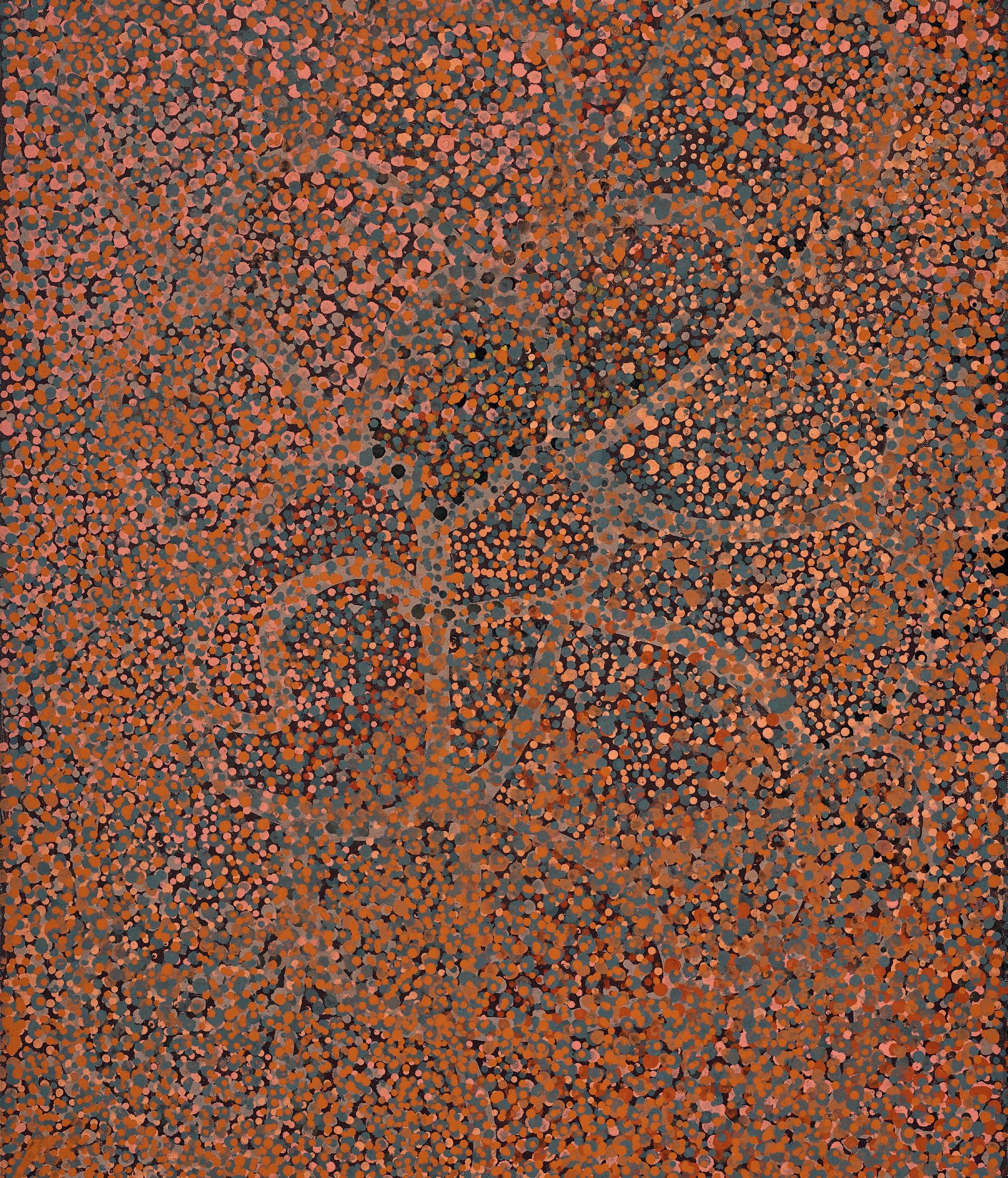
Important Australian Indigenous Art
AUCTION | MELBOURNE | 26 MARCH 2023


99 points
“Good depth and hue of colour it’s still purpletinted at this age. The bouquet is fresh and bold, replete with forest-floor/mint and driedherb nuances, while the palate is very powerful, concentrated, full-bodied and firmly constructed. Deep-set cassis fruit as well, still partially in hiding. This is a dense, power-packed cabernet-driven red with abundant tannins. Tremendously long finish. A magnificent wine, which has what it takes to age and reward cellaring for the long term.”
Huon Hooke, The Real Review, 21 March 2023

yalumba.com
Yalumba The Caley Cabernet & Shiraz 2018 available now.
Important Australian Indigenous Art
Lots
3 AUCTION | MELBOURNE | 26 MARCH 2024
1 – 66
FORBES ST
BURTON ST
NATIONALARTSCHOOL
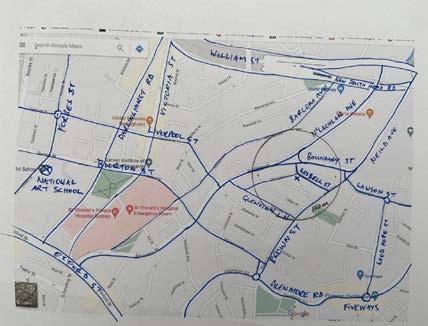
WILLIAM ST
DARLINGHURST RD VICTORIA ST NEW SOUTH HEAD RD 200M
LIVERPOOL ST
BARCOM AVE
McLACHLANAVE
GOSBELLST
NEILD AVE
MELBOURNE • AUCTION + VIEWING
105 commercial road, south yarra, victoria, 3141 telephone: 03 9865 6333 • facsimile: 03 9865 6344 info@deutscherandhackett.com
OXFORDST
BOUNDARYST
MACDONALDST
BROWNST GOODHOPE ST
GLENMORE RD
SYDNEY • VIEWING
36 gosbell street, paddington, new south wales, 2021 telephone: 02 9287 0600 • facsimile: 02 9287 0611 info@deutscherandhackett.com
4
sydney viewing
melbourne viewing
melbourne auction a bsentee/telephone bids
online bidding
LOTS 1 – 66
TUESDAY 26 MARCH
7:00 pm
105 commercial road south yarra, vic
telephone: 03 9865 6333
THURSDAY 14 – SUNDAY 17 MARCH
36 gosbell street paddington, nsw
telephone: 02 9287 0600
11:00 am – 6:00 pm
THURSDAY 21 – MONDAY 25 MARCH
105 commercial road south yarra, vic
telephone: 03 9865 6333
11:00 am – 6:00 pm
email bids to: info@deutscherandhackett.com
telephone: 03 9865 6333
fax: 03 9865 6344
telephone bid form – p.126
absentee bid form – p.127
www.deutscherandhackett.com/watch-live-auction
www.deutscherandhackett.com
info@deutscherandhackett.com
5
|
l
ive
s pecialists





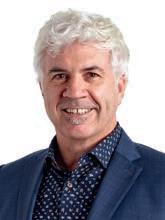
CHRIS DEUTSCHER
executive director — melbourne
Chris is a graduate of Melbourne University and has over 40 years art dealing, auction and valuation experience as Director of Deutscher Fine Art and subsequently as co-founder and Executive Director of Deutscher~Menzies. He has extensively advised private, corporate and museum art collections and been responsible for numerous Australian art publications and landmark exhibitions. He is also an approved valuer under the Cultural Gifts Program.
CRISPIN GUTTERIDGE
head of aboriginal art and senior art specialist
Crispin holds a Bachelor of Arts (Visual Arts and History) from Monash University. In 1995, he began working for Sotheby’s Australia, where he became the representative for Aboriginal art in Melbourne. In 2006 Crispin joined Joel Fine Art as head of Aboriginal and Contemporary Art and later was appointed head of the Sydney office. He possesses extensive knowledge of Aboriginal art and has over 20 years experience in the Australian fine art auction market.
FIONA HAYWARD
senior art specialist
After completing a Bachelor of Arts at Monash University, Fiona worked at Niagara Galleries in Melbourne, leaving to join the newly established Melbourne auction rooms of Christie’s in 1990, rising to become an Associate Director. In 2006, Fiona joined Sotheby’s International as a Senior Paintings Specialist and later Deputy Director. In 2009, Sotheby’s International left the Australian auction market and established a franchise agreement with Sotheby’s Australia, where Fiona remained until the end of 2019 as a Senior Specialist in Australian Art. At the end of the franchise agreement with Sotheby’s Australia, Smith & Singer was established where Fiona worked until the end of 2020.
ALEX CRESWICK
managing director / head of finance
With a Bachelor of Business Accounting at RMIT, Alex has almost 25 years experience within financial management roles. He has spent much of his early years within the corporate sector with companies such as IBM, Macquarie Bank and ANZ. With a strong passion for the arts more recently he was the Financial Controller for Ross Mollison Group, a leading provider of marketing services to the performing arts.
DIANA McPHILLIPS
head of online auctions & social media
Diana has a Bachelor of Arts (Art History and Theory, History) together with a Master of Art Curatorship from the University of Sydney. She has also completed studies in Interior Design from the New York Institute of Art and Design. As a member of an Australian diplomatic family, Diana has lived extensively overseas and has gained a strong appreciation for the arts and culture.
DANNY KNEEBONE
design and photography manager
With over 25 years in the art auction industry as both photographer and designer. Danny was Art Director at Christie’s from 1998–2007, Bonham's and Sotheby's 2007–2009 and then Sotheby’s Australia from 2009–2020. Specialist in design, photography, colour management and print production from fine art to fine jewellery. Danny is also an artist in his own right, holding regular solo and group exhibitions, winning over 50 national and international photography awards.
6
s pecialists




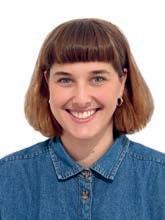

DAMIAN HACKETT executive director — sydney
Damian has over 30 years experience in public and commercial galleries and the fine art auction market. After completing a BA (Visual Arts) at the University of New England, he was Assistant Director of the Gold Coast City Art Gallery and in 1993 joined Rex Irwin Art Dealer, a leading commercial gallery in Sydney. In 2001, Damian moved into the fine art auction market as Head of Australian and International art for Phillips de Pury and Luxembourg, and from 2002 – 2006 was National Director of Deutscher~Menzies.
HENRY MULHOLLAND senior art specialist
Henry Mulholland is a graduate of the National Art School in Sydney, and has had a successful career as an exhibiting artist. Since 2000, Henry has also been a regular art critic on ABC Radio 702. He was artistic advisor to the Sydney Cricket Ground Trust Basil Sellers Sculpture Project, and since 2007 a regular feature of Sculpture by the Sea, leading tours for corporate stakeholders and conducting artist talks in Sydney, Tasmania and New Zealand. Prior to joining Deutscher & Hackett, Henry’s fine art consultancy provided a range of services, with a particular focus on collection management and acquiring artworks for clients on the secondary market.
VERONICA ANGELATOS
art specialist and senior researcher
Veronica has a Master of Arts (Art Curatorship and Museum Management), together with a Bachelor of Arts/Law (Honours) and Diploma of Modern Languages from the University of Melbourne. She has strong curatorial and research expertise, having worked at various art museums including the Peggy Guggenheim Collection, Venice and National Gallery of Victoria, and more recently, in the commercial sphere as Senior Art Specialist at Deutscher~Menzies. She is also the author of numerous articles and publications on Australian and International Art.
ELIZA BURTON registrar
Eliza has a Bachelor of Arts (English and Cultural Studies and History of Art) from the University of Western Australia and a Master of Art Curatorship from the University of Melbourne. She has experience in exhibition management, commercial sales, and arts writing through her work for Sculpture by the Sea and The Sheila Foundation.
HANNAH JAMES
gallery manager – sydney
Hannah has a Bachelor of Fine Arts from the University of New South Wales together with a Master of Arts (Contemporary Art Theory) from the University of London. She has spent time living and working across London, Venice, Munich, and Sydney, in a range of roles including curation, exhibition management, artist liaison, art sales and gallery administration.
CAMILLE NICHOLLS
front of house manager – melbourne
Camille has a dual BA in Arts (Fine Arts and Visual Culture) from Curtin University, Perth. She’s also completed studies in Conservation, Languages and Arts Law. She’s lived in Vanuatu, France and Bahrain and has experience in Collection Management, Curatorial, and Conservation with a focus on Oceanic, Modern and 15th–16th Century European Art. Camille has worked at the National Museum of Vanuatu, The Michoutouchkine & Pilioko Museum, Vanuatu, and HOTA Gallery, Gold Coast.
7
s pecialists for this auction auctioneer
Crispin Gutteridge Henry Mulholland
0411 883 052 0424 487 738
Fiona Hayward
Damian Hackett
0417 957 590 0422 811 034
Chris Deutscher
Veronica Angelatos
0411 350 150 0409 963 094
ADMINISTRATION AND ACCOUNTS
Alex Creswick (Melbourne)
Hannah James (Sydney) 03 9865 6333 02 9287 0600
ABSENTEE AND TELEPHONE BIDS
Camille Nicholls 03 9865 6333
SHIPPING
Eliza Burton 03 9865 6333

SCOTT LIVESEY auctioneer
Scott Livesey began his career in fine art with Leonard Joel Auctions from 1988 to 1994 before moving to Sotheby’s Australia in 1994, as auctioneer and specialist in Australian Art. Scott founded his eponymous gallery in 2000, which represents both emerging and established contemporary Australian artists, and includes a regular exhibition program of indigenous Art. Along with running his contemporary art gallery, Scott has been an auctioneer for Deutscher and Hackett since 2010.
8
contents
various vendors page 12
watercolours by Albert Namatjira page 67
various vendors page 76
prospective buyers and sellers guide page 122
conditions of auction and sale page 124
telephone bid form page 126
absentee bid form page 127
attendee pre-registration form page 128
index page 143
9

Important Australian Indigenous Art
11
MIRDIDINGKINGATHI JUWARNDA SALLY GABORI (c.1924
– 2015)
DIBIRDIBI COUNTRY, 2009 synthetic polymer paint on linen 137.0 x 122.0 cm
bears inscription verso: artist’s name, title, medium and Mornington Island Arts and Crafts cat. 4305–L–SG–0509
ESTIMATE: $15,000 – 20,000
PROVENANCE
Mornington Island Arts and Crafts, Mornington Island, Queensland (stamped verso)
Woolloongaba Art Gallery, Brisbane Private collection, Melbourne
This work is accompanied by a certificate of authenticity from Mornington Island Arts and Crafts which states: ‘This is a big mangrove swamp on my husband’s country on Bentinck Island. It is on the edge of a big saltpan.’
background into consideration, Gabori’s style is completely self-made, conjured from maps in her mind of Bentick Island and the country she loved. From her very earliest works, she has depicted aspects of her own beloved country as well as that of her brother, father and husband – including both geographical aspects of the landscape as well as the wildlife, specifically sea-life which is central to the landscape.’1
Mirdidingkingathi Juwarnda Sally Gabori’s paintings are a tribute to the country on Bentinck Island, a small sparsely vegetated rise of land in the southern Gulf of Carpentaria where she grew up living off the natural abundance of the surrounding ocean and estuaries in the traditions of the Kaiadilt. In 1948, following a series of natural disasters, Gabori along with the other inhabitants of Bentinck Island, were forced to relocate to Gununa on nearby Mornington Island.
Gabori began her art career late in life, aged 85, however, unlike many other Aboriginal language groups, the Kaiadilt did not have a tradition of mark making, whether on tools, objects or bark. Taking this cultural
Dibirdibi Country, 2009 depicts a subject painted more often by the artist than any other and is a powerful recollection of the country of her husband, Kabarrarjingathi Bulthuku Pat Gabori, a rival of her brother King Alfred, and whose relationship with Gabori created intense friction within Kaiadilt society eventually resulting in the death of her brother. 2 As Gabori suggests on the certificate of authenticity from Mornington Island Arts and Crafts which accompanies the work, the painting recalls the country of her husband and the Rock Cod Ancestor, depicting the big mangrove swamp on the edge of a large saltpan that covers part of her husband’s country close to the site where the liver of Dibirdibi, the Rock Cod Ancestor, was thrown into the sea, creating a permanent fresh water well. Known primarily for her brightly coloured canvases, with vital, intuitive and boldly executed brushstrokes, when Gabori paints Dibirdibi, the meanings layer in multitudes; she is at once painting the saltpans of the land, the Rock Cod Ancestor Dreaming of Dibirdibi Country, a portrait of her late husband in connection to his country, and finally, her own longing, loss and memory.
1. Pinchbeck, C., ‘Mirdidingkingathi Juwarnda Sally Gabori’ in unDisclosed, 2nd National Indigenous Art Triennial, National Gallery of Australia, Canberra, 2012, p. 64
2. McLean, B., ‘Dulka Warngiid; The Whole World’ in Mirdidingkingathi Juwarnda Sally Gabori Dulka Warngiid; Land of All, Queensland Art Gallery I Gallery of Modern Art, Brisbane, 2016 p. 16
CRISPIN GUTTERIDGE
12 IMPORTANT AUSTRALIAN INDIGENOUS ART
1

13
NOŊGIRRŊA MARAWILI
(c.1939 – 2023)
BARATJALA, 2015 natural earth pigments and recycled print toner on eucalyptus bark
74.5 x 44.0 cm (irregular) bears inscription verso:
Buku-Larrŋgay Mulka Centre cat. 4816-U bears inscription on label verso: artist's name and Buku-Larrŋgay Mulka Centre cat. 4816-U
ESTIMATE: $8,000 – 12,000
PROVENANCE
Buku-Larrŋgay Mulka Centre, Yirrkala, Northern Territory
Buku-Larrŋgay at the Darwin Art Fair, Darwin Private collection, Brisbane, acquired from the above
No ŋ girr ŋ a Marawili’s Baratjala, 2015, abounds with the energy of her coastal lands. Dark forms of rocks, painted in ochre and charcoal, are outlined in white dots and contained by an overlay of irregular parallel lines of smaller dots, evoking the rhythm and cyclical interactions of currents, tides and breaking waves. In recording adjacent sites of Yathikpa and Baratjala, located on Blue Mud Bay, Marawili asserts the secular nature of her painting, ‘I paint water designs – the water as it splashes onto the rocks at high tide…. the painting that I do is not sacred…. The paintings I do are from the outside, Water, Rock, Rocks which stand strong and the waves which run and crash upon the rock, the Sea spray. This is the painting I do, but I know the sacred designs.’1
Marawili began painting in the 1990s as an assistant to her husband, Djutjadjutja Munuŋgurr, adding cross-hatching and in-fill according to his instructions, and over the next decade she would collaborate with him following established Yol ŋ u bark painting conventions. Marawili didn’t begin to emerge in her own right until 2005 when she became a regular painter at Buku-Larr ŋ gay, but her most original works appeared from 2011 when she began to paint interpretations of her paternal lands. Her current work refers back to these areas, remembering ancient ways of living directly on country she grew up on as a child.
Marawili’s work has been the recipient of a number of awards, winning the NAATSIA Best Bark award in 2015 and again in 2019, and she has been the subject of a major solo exhibition at the Art Gallery of New South Wales in 2018. Her paintings were also included in major group exhibitions, such as Tarnathi, Art Gallery of South Australia in 2019; NIRIN, Biennale of Sydney in 2020; Know My Name, National Gallery of Australia; and Bark Ladies, National Gallery of Victoria run over the summer of 2021 – 2022.
1. Pinchbeck, C. (ed.), Noŋgirrŋa Marawili. From My Heart and Mind, Art Gallery of New South Wales, Sydney, 2018, p. 21
CRISPIN GUTTERIDGE
14 IMPORTANT AUSTRALIAN INDIGENOUS ART
2

15
NYAPANYAPA YUNUPIŊU
(c.1945 – 2021)
CIRCLES, 2011
natural earth pigments on eucalyptus bark 180.0 x 80.0 cm (irregular) bears inscription verso: Buku–Larrŋgay Mulka Centre cat. 4039M
ESTIMATE: $25,000 – 35,000
PROVENANCE
Buku Larrŋgay Mulka Centre, Yirrkala, Northern Territory (label attached verso)
Roslyn Oxley9 Gallery, Sydney (label attached verso) Private collection, Sydney, acquired in 2011
EXHIBITED
Nyapanyapa Yunupiŋu, Birrka’, Roslyn Oxley9 Gallery, Sydney, 6 – 29 October 2011, cat. 1
Working outside of previous Yolŋu conventions, the art of Nyapanyapa Yunupiŋu was unique and seemingly independent of Arnhem Land bark painting traditions. Valued for the spontaneity and texture of her hand and for the freeness of her mark making, she did not paint ancient dreaming narratives nor traditional clan designs like other Yolŋu artists; rather, her art is personal, recalling stories from her life or simply reflecting a spontaneous expression of the moment. ‘Yolŋu bark painting and sculpture traditionally conveys a temporal union between prehistory, the present and the distant future where all these time zones are happening simultaneously! This is the tense in which
the creation events happened/are happening/will happen. All Yolŋu art until this point was either sacred and in this tense or decorative. Decorative paintings were expressly ‘ordinary’ and without meaning or story of any kind.’1 However, once prompted in 2008 to paint the story of her almost fatal goring by a Buffalo that occurred in the 1970s, Nyapanyapa discarded these conventions and unleashed a unique set of personal narrative paintings revolving around her own experiences. 2 Her early story paintings evolved quickly into an idiosyncratic method of mark making combining individual free flowing elements such as circles, squares and thick lines with underlying and rhythmic cross-hatching.
Circles , 2011 is one such work – here a loose and energetic surface of white circles hover above a base of dynamic patterned and variously hued crosshatching designs. Yunupiŋu’s paintings are rhythmic designs mapped out in bold gestures using traditional and non-traditional materials. The looseness of her hand and her particular focus upon form and line give her art a spontaneous quality, a contrast to the tightly geometric works of many contemporary Yirrkala artists. For as Luke Scholes reveals, ‘she painted for the pure, gleeful pleasure of it. There is no ego, no desire, she is instinctively and unreservedly giving herself to each mark.’ 3
1. Buku–Larrŋgay Mulka Centre certificate of authenticity
2. Will Stubbs, cited in Scholes, L., ‘Anyhow in the everywhen’ in Luke Scholes (ed.), The Moment Eternal, Nyapanyapa Yunupiŋu, Museum and Art Gallery of the Northern Territory, Darwin, 2020 p. 98
3. ibid p. 103
CRISPIN GUTTERIDGE
16 IMPORTANT AUSTRALIAN INDIGENOUS ART
3

17
NYAPANYAPA YUNUPIŊU
(c.1945 – 2021)
MAPU, 2014 felt tip pen and white clay pigment on discarded photography paper
129.0 x 134.0 cm
ESTIMATE: $8,000 – 12,000
PROVENANCE
Buku Larrŋgay Mulka Centre, Yirrkala, Northern Territory Roslyn Oxley9 Gallery, Sydney (label attached verso) Private collection, Sydney, acquired in 2015

Nyapanyapa Yunupiŋu painting at Buku-Larrŋgay Mulka Centre, Yirrkala, 2011 photographer: unknown
18 IMPORTANT AUSTRALIAN INDIGENOUS ART
4
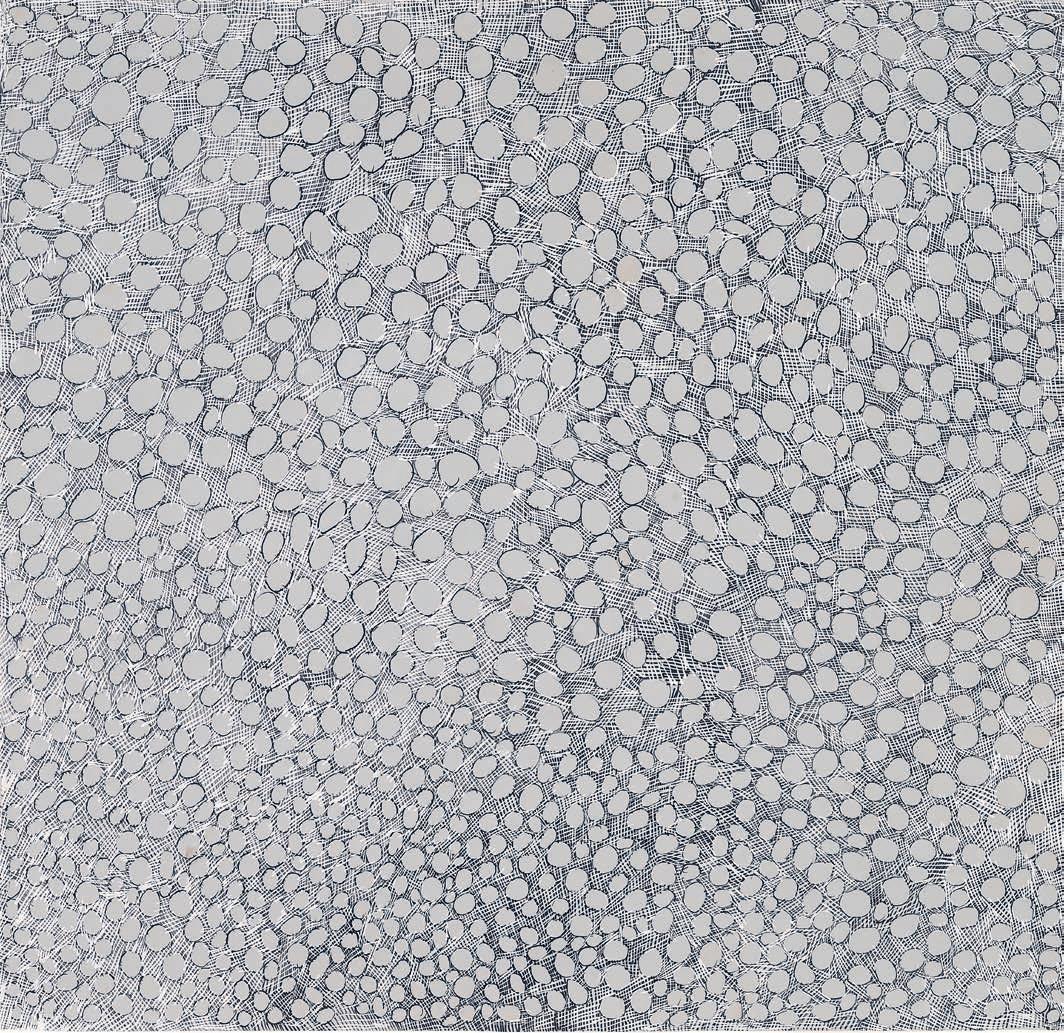
19
RAMMEY RAMSEY born c.1935
WARLAWOON COUNTRY, 2006
natural earth pigment with synthetic binder on linen 180.0 x 150.0 cm
bears inscription verso: artist's name, W Art Fair and Jirrawun Arts cat. RR 6 2006-77
ESTIMATE: $20,000 – 30,000
PROVENANCE
Jirrawun Arts, Wyndham, Western Australia
William Mora Galleries, Melbourne (gallery stamp verso) Private collection, Melbourne
EXHIBITED
Jirrawun Arts in associastion with William Mora Galleries at Melbourne Art Fair, Melbourne, 2 – 6 August 2006 (illus. in exhibition catalogue p. 21)
Rammey Ramsey began painting for Jirrawun Arts at the beginning of the millennium where his paintings came to prominence when included in a number of group exhibitions at commercial galleries alongside contemporaries such as Paddy Bedford, Freddie Timms and Hector Jandany.
A senior Gija man of Jungurra skin, Ramsey was born at Old Greenvale Station (now part of Bow River Station) but as a young boy lived at Warlawoon, his ancestral country located to the west of Bedford Downs near Elgee Cliffs in the remote East Kimberley region of Western Australia. For much of his life he worked as a stockman on various surrounding Kimberley cattle stations, including Bedford Downs, Lansdowne Station and Bow River Station. Ramsey combined stock work with his collective knowledge of Gija lore and ceremony. He came to painting in his later years, but art was always an essential part of his life through ceremony.
Warlawoon Country, 2006 was first shown with William Mora Galleries at the Melbourne Art in 2006 and depicts the country of his mother and father. Warlawoon is also Ramsey’s Gija name and the main subject of his painting, portraying both a personal and collective history, and a memory of place. Notably in 2006, another of Ramsey’s work was included in the exhibition , Jirrawun in the House: A Contemporary Experience from the East Kimberley, held at Parliament House, Canberra.
20 IMPORTANT AUSTRALIAN INDIGENOUS ART
5
CRISPIN GUTTERIDGE
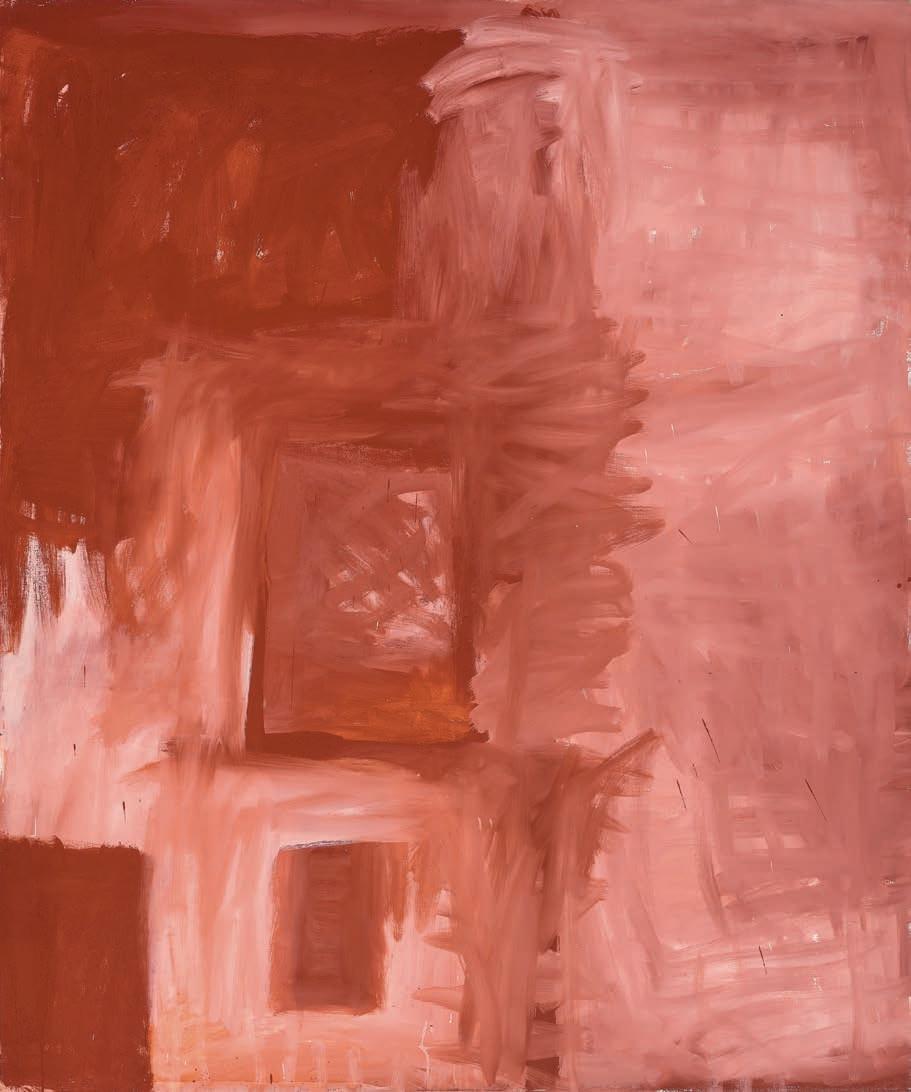
21
FREDDIE TIMMS
(c.1946 – 2017)
PIPE CREEK CATTLE PLAIN CATTLE CAMP, 2008 ochres and pigment with synthetic binder on Belgian linen 150.0 x 180.0 cm bears inscription verso: artist’s name, title, size and Waringarri Aboriginal Arts cat. 375412
ESTIMATE: $12,000 – 18,000
PROVENANCE
Waringarri Aboriginal Arts, Kununurra, Western Australia
The Estate of Freddie Timms
In a career that spanned more than 30 years, Freddie Timms was recognised as the foremost painter amongst the second generation of Gija artists. He became known for painting works that chronicled the interactions between the Gija and the settler-colonisers, recording the devastating consequences on the local people and landscape from the effects of colonisation and station life in the cattle industry. Utilising a reserved palette and an economy of space, his balanced compositions conform to the East Kimberley archetype, originated by Rover Thomas, but are recognisably his own with discrete areas of colour outlined in double rows of white dots. He is noted for his careful aerial landscapes and mapping that are not necessarily inspired by the Ngarranggarni, but often stem from personal experience.
Timms lived as a child on Bow River and Lissadell Stations, later working as a stockman and fencer on several stations throughout the East Kimberley. He knew Rover Thomas when they both worked at Bow River and Texas Downs, where Timms danced and helped paint boards for early performances of Thomas’ Gurirr-Gurirr. He first began
painting in the mid-1980s while living at Frog Hollow, south of Turkey Creek, obtaining canvases from Joel Smoker of Waringarri Arts who at the time was supplying canvases to Jack Britten, Rover Thomas, Hector Jandany and his father-in-law, George Mung-Mung. Timms’ paintings were first shown in the Waringarri group exhibition Turkey Creek: Recent Work (1989), held at Deutscher Gertrude Street, Melbourne – an exhibition which signalled the emergence of the East Kimberley school.
Part of Lissadell Station – approximately 200 kilometres to the south of Kununurra and north-east of the Warmun Community on the edge of Lake Argyle – Pipe Creek Plain Cattle Camp is a place Timms knew well from his works as a stockman on Lissadell, a time he remembers as of ‘hard times but good times.’1 Like many of his paintings, this work evokes features of the landscape such as black and red soils, the sandy ground, hills, creeks, and water holes. It shows roads, stockyards, and at a spiritual level, Ngarranggarni or dreaming places. The site is characterised by black soils and is a haven for wildlife, boab trees and permanent water.
Timms was pivotal in the establishment of Jirrawun Aboriginal Art Corporation in 1998 and, with the assistance of Tony Oliver, Jirrawun began to market the work of a wide group of Kimberley artists including Paddy Bedford, Hector Jandany, Rusty Peters, Goody Barrett, Phyllis Thomas, and his father’s brother, Timmy Timms.
1 Timms in conversation with Georges Petijean 22 August 2002, ‘Contemporary Art from the East Kimberley: An Overview’, in Beyond Sacred: Australian Aboriginal Art: The Collection of Colin and Elizabeth Laverty, Edition II, Kleimeyer Industries Pty Ltd, Melbourne, 2011, p. 212
CRISPIN GUTTERIDGE
22 IMPORTANT AUSTRALIAN INDIGENOUS ART
6

23
EMILY KAM KNGWARREYE
(c.1910 – 1996)
UNTITLED (ENDUNGA), 1990 synthetic polymer paint on linen 121.0 x 90.5 cm bears inscription verso: artist’s name and Delmore Gallery cat. 0H19
ESTIMATE: $150,000 – 250,000
7
PROVENANCE
Commissioned by Delmore Gallery, via Alice Springs, Northern Territory in 1990
Private collection, Alice Springs, Northern Territory
Sotheby’s, Sydney, 9 November 1997, lot 130 (as ‘Edunga’)
Private collection, Melbourne
Sotheby’s, Melbourne, 24 June 2002, lot 203 (as ‘Edunga’)
Private collection, Melbourne
EXHIBITED
Emily Kame Kngwarreye: Werke Australischer Privatsammlungen, Kunsthaus Zug, Zug, Switzerland, 1 October 2019 – 12 January 2020
LITERATURE
Drury, N., Images 2 – Contemporary Australian Painting, Craftsman House, Sydney, 1994, p. 282, pl. 267 (illus.)
Voight, A., and Drury, N., Wisdom of the Earth – The Living Legacy of Aboriginal Dreamtime, Simon & Shuster, Sydney, 1997, p. 86 (illus.)
This work is accompanied by a certificate of authenticity from Delmore Gallery.
Deeply rooted in the Anmatyerr land of her ancestors to whom she paid respect through a lifetime of devotion to women’s ceremony in song, dance and the ceremonial painting of bodies, the art of Emily Kam Kngwarreye reveals a deep affinity to the country and the everchanging desert landscape in her father and grandfather’s Country of Alhalker. As the youngest of three children, Kngwarreye chronicled on canvas this triangular-shaped country – the place she was born, and where she lived in the ways of the eastern Anmatyerr. The traditional life of the Anmatyerr and Alyawarr people was forever disrupted in the 1930s, when the borders of the Utopia pastoral lease were drawn across their lands. Over time, many local people including Kngwarreye
found periodic work on the emergent pastoral stations. Sixty years later however, Kngwarreye was introduced to batik as part of adult education classes held on Utopia Station in 1977 and the following decade, in 1988–89, Emily painted her first work on canvas, sparking a meteoric rise to fame.
Untitled (Endunga), 1990 is one of a small number of paintings of similar tonal colour produced in the second year of her painting that have come to symbolise her oeuvre. A masterpiece of strength and simplicity, the distinctive meandering linear pattern, based on the underground growth of the Atnulare yam, is infilled and overpainted with patterns of dotting that represents the fruit, seeds (Ntang) and reedy strands of the Endunga grass. Working from the periphery of the canvas, traceries and over-dotting spread energetically across the canvas limited only by the reach of the artist’s arm. ‘Kngwarray painted with great speed and intensity and the strength of her arms and hands…is apparent in the rhythmic, confident marks she made… echos of batik style and process are apparent in these early works on canvas.’1
Often domestic in theme, Kngwarreye’s painting demonstrates the interconnectedness of life, landscape and culture, a celebration of the seasonal variations in her homeland of Alhalker and the related spiritual and domestic obligations to country. When looking at this work, as Janet Holt states in the accompanying certificate, ‘One can imagine Kngwarray leaning forward, her digging stick nearby, her hands quickly rustling aside drying leaves and grasses seeking cracks in the ground indicating the presence of yams and their lineal connecting “strings” beneath the earth.’2
More than two decades have passed since Emily Kngwarreye died in September 1996, yet her name remains synonymous with the best of Australian Indigenous art. An original, intuitive and often enigmatic artist, her painting career lasted less than a decade, but the critical acclaim for her prodigious output has not diminished and her reputation has been sustained both in Australia and internationally.
1. Jenny Green, ‘The Life and Legacy of Emily Kam Kngwarray’ in Cole K., Green J., and Perkins H., (eds.) Emily Kam Kngwarray, National Gallery of Australia, Canberra, 2023, p. 157
2. From the accompanying Delmore Gallery certificate of authenticity. CRISPIN GUTTERIDGE
24 IMPORTANT AUSTRALIAN INDIGENOUS ART

25
EMILY KAM KNGWARREYE
(c.1910 – 1996)
UNTITLED (EMU COUNTRY), 1993 synthetic polymer paint on canvas 152.0 x 91.5 cm
bears inscription verso: artist’s name and Delmore Gallery cat. 93A171
ESTIMATE: $70,000 – 90,000
PROVENANCE
Commissioned by Delmore Gallery, via Alice Springs, Northern Territory in 1993
Songlines Gallery, San Francisco, USA
Private collection, New York, USA, acquired from the above in September 2007
EXHIBITED
Songlines Aboriginal Art: Utopian Visions, Art 1999 Chicago, Chicago, USA, 7 – 11 May 1999
This painting is accompanied by a certificate of authenticity from Delmore Gallery.
Anmatyerr, following a way of life that had continued unchanged from long before European presence. Her mark making recorded the seasonal variations, sometimes subtle but often dramatic, of the harsh desert environment and the explosion of growth that occurred after rain. Referred to by Emily as the ‘green time’1, the desert would come to life, wildflowers carpeting the red earth and plants and grasses flourishing, supplying the women with seeds, tubers and fruit.
Renowned for her colourful and vibrant recording of the ever-changing desert landscape in her father and grandfather’s Country of Alhalker, Emily Kam Kngwarreye chronicled on canvas her custodial responsibility for the Yam and the Emu – reflecting her connection to country and Women’s ceremonies through body painting and dance. Located at the western edge of Utopia this triangular shaped country was where Emily was born and where she lived in the traditional ways of the eastern
With her distinctive use of pattern and colour, Kngwarreye had seemingly endless variations to call upon in the depiction of her country. Her paintings would often dissolve into fields of layered colour achieved through a build-up of dots upon dots as in Untitled (Emu Country), 1993 – in this case, a tracery of soft milky pink dots hover over an underlying ground of green, yellow and red dots. ‘This is Emu Country - called Alalgura (sic.) where the male emu’s role is to look after the emu chicks and keep them in sight of their home and not beyond their preferred seeds and fruits. These foods include the Nterkwe, a small purple-blue plum, and the Anooralya, a long, thin yam with a small flower. 2
Kngwarreye bears witness though her painting to that abundance that carpets the earth after rain, sustaining country and celebrating the hardiness and fertility of their bush tucker and food sources, and in turn, her people’s own resilience.
1. Isaacs, J., ‘Amatyerre Woman’ in Isaacs, J. et al., Emily Kame Kngwarreye Paintings, Craftsman House, Sydney, 1998, p. 13
2. Cited in the accompanying certificate from Delmore Gallery
CRISPIN GUTTERIDGE
26 IMPORTANT AUSTRALIAN INDIGENOUS ART
8

27
JOHN MAWURNDJUL
born 1952
BULUWANA AT DILEBANG, 2011
natural earth pigments on stringybark (Eucalyptus tetradonta) 185.0 x 65.0 cm (irregular) bears inscription verso: Maningrida Arts and Culture cat. 2169-11 bears inscription on label verso: artist's name, subject, medium, size, language group and Maningrida Arts and Culture cat. 2169-11
ESTIMATE: $40,000 – 60,000
PROVENANCE
Maningrida Arts and Culture, Maningrida, Northern Territory Private collection, Sydney
This work is accompanied by a certificate of authenticity from Maningrida Arts and Culture.
One of Australia’s most successful and innovative contemporary artists, with an artistic career spanning more than thirty years, John Mawurndjul first achieved recognition in 1981 when he was included in a group exhibition in Paris, Les magicians de la terre at the centre Georges Pompidou. Exhibitions at commercial galleries followed and in 2000, his work was featured in the 12th Biennale of Sydney, followed in 2002 with the bark painting prize at the National Aboriginal & Torres Strait Islander Art Award, Darwin, a prize he won again in 2016.
Born in the freshwater country of Kubukkan near Marrkolidjban, south of Maningrida, an important site for the Kurulk clan and home to the Kuninjku people. Mawurndjul had a very traditional upbringing, guided by his elder brother Jimmy Njiminjuma and his uncle Peter Marralwanga, whose early painting instruction taught him how to apply paint to bodies for dance and initiation ceremonies, a task for which he showed a natural flair. As he recalls, ‘I saw my father doing the rarrk for the Mardayin ceremony and tried to do it myself with my back all doubled over, I ended up being better than any of them at it. They gave me a job in the Mardayin ceremony to paint some rarrk. When they all saw me doing it they said ‘wow’, he’s got the hang of it. ‘You’ve left us behind my son’, they said to me.’1 Today Mawurndjul guides and monitors the development of his children and his niece Irenie Ngalinba, the daughter of his late brother Jimmy Njiminjuma.
His first paintings on bark were representations of mythological figures, such as Ngalyod the Rainbow Serpent, totemic creatures and local natural species. These early paintings invoke ideas of spirituality, mythology and natural life cycles. It wasn’t until after he had developed a more metaphysical representation of specific sites, events and landscape that Mawurndjul’s fame grew. The artist eliminated representational imagery from his painting and instead embarked upon a journey of exploration of rarrk (lineal clan designs), producing intricate paintings that are encoded with secret meaning. In Buluwana at Dilebang , 2011, the complexity and skill of Mawurndjul’s ability as a painter of rarrk is evident. The central arc, infilled with white clay, represents the head of the ancestor woman Buluwana , who lived at Dilebang and Ngandarrayo in mythological times, and who was killed by the Giant Deaf Adder and turned to a standing stone. Expanses of rarrk with multiple grids rendered in fine interlocking lines, constantly and unpredictably shifting in planes across the surface of the bark surround the central form of Buluwana.
In elevating the treatment of rarrk and the iconic representation of both Mardayin (Sacred) and natural themes, Mawurndjul is constantly finding new ways to interpret his country. As Hetti Perkins notes ‘His works –lovingly crafted and sculpted depictions of flora and fauna, ancestral events, supernatural beings, significant sites and encrypted ceremonial designs – are at once of country and mnemonic of country’ 2 and as Mawurnjul maintains his paintings are the ‘same, same but different... I just can’t stop thinking about my paintings... They are very important places for us, they have meanings.’3
1. Mawurndjul, cited in Rarrk: John Mawurndjul, Journey Through Time in Northern Australia, Museum Tinguely, Basel, 2005, p. 43
2. Perkins H., ‘Mardayin Maestro’ in John Mawurndjul, I am the Old and the New, op. cit., 2018, p. 26
3. Mawurndjul, cited ibid.
CRISPIN GUTTERIDGE
28 IMPORTANT AUSTRALIAN INDIGENOUS ART
9

29
JOHN MAWURNDJUL born 1952
UNTITLED (LORRKON), 2005 natural earth pigments and synthetic binders on hollow log
247.0 cm height
ESTIMATE: $30,000 – 40,000
PROVENANCE
Maningrida Arts and Culture, Maningrida, Northern Territory (cat. 3037-05)
Annandale Galleries, Sydney
Private collection, Queensland, acquired from the above Private collection, Melbourne
‘I also make make Lorrkon – hollow log – all painted with my rarrk, filled with Mardayin power.’1
Untitled (Lorrkon), 2005 was painted the year before John Mawurndjul undertook his major commission for the Musée du Quai Branly, Paris. As one of the eight Australian artists selected by the project architect Jean Nouvel to integrate Australian indigenous art into the structure of the building, Mawurndjul was commissioned to paint a colossal column and another of his works was reproduced on the ceiling of the museum bookshop. Although highly sacred by nature, Mawurndjul chose to depict Mardayin ceremonial themes on the Branly column and indeed our Lorrkon also depicts an abstract representation of this ancient ceremony.
The Western Arnhem Land version of the Lorrkon ceremony involves the singing of sacred songs to the accompaniment of the karlikarli, a pair of sacred boomerangs used as rhythm instruments.
The complete ceremony may stretch over a period of two weeks, but on the last night the bones of the deceased – which have been kept in a bark container or today wrapped in cloth and kept in a suitcase – are taken out, painted with red ochre and placed inside the hollow log. This ceremony may take place years after the person has died.
‘At the end of the ceremony, early in the morning as the sun moves across the sky, the hollow log is placed upright. It will stand there and decay. At the end of standing-up ritual the women will dance around it. In the camp people chant as they move up. The section with men carrying burning torches represent the fire hawks who carry the burning embers and take them away… Fire Hawks or brown falcons carry the fire in the ceremony representing the hawk lifting up that person and taking them away.’ 2
1. Kohen, A., ‘Interview with Apolline Kohen and John Mawurndjul’ in Kaufmann, C. and Museum Tinguely, Basel (eds.), rarrk: John Mawurndjul: Journey through Time in Northern Australia, Schwabe Verlag, Basel and Crawford House, Adelaide, 2005, p. 28
2. Mawurndjul, cited in John Mawurndjul, I am the Old and the New, Museum of Contemporary Art, Sydney, 2018, p. 283
CRISPIN GUTTERIDGE
30 IMPORTANT AUSTRALIAN INDIGENOUS ART
10

31
TOMMY M c RAE (c.1836 – 1901)
WAR DANCE, 1900 pen and ink on paper
24.5 x 31.0 cm
bears inscription and date verso: R Kilborn / 1900
ESTIMATE: $50,000 – 70,000
PROVENANCE
George Kilborn, Wahgunyah, Victoria
Thence by descent
Private collection, Melbourne
Joel Fine Art, Melbourne, 3 June 2008, lot 3
Private collection, Sydney
RELATED WORK
Lachlan War Dance , c.1890, pen and ink on paper, 21.5.0 x 28.0 cm, in the collection of the Latrobe Library, State Library of Victoria, Melbourne, illus. in Sayers, A., Aboriginal Artists of the Nineteenth Century, Oxford University Press, Melbourne, 1994, p. 32, pl. M 14
Tommy McRae, also known as Yackaduna, Warra-euea, Tommy Barnes and Tommy McCrae was born in the 1830s just as the colonisation of the Upper Murray region was commencing. As a young man, McRae experienced the cultural transition from traditional life to one where interactions with settlers became widespread and from the 1850s with the influx of miners following the discovery of gold in the North-east of Victoria, traditional life was overwhelmed by settler culture.
McRae worked for squatters along the Murray River in both New South Wales and Victoria. In his later years he settled at Lake Moodermere south of Wahgunyah on the Victoria side of the Murray River, and it was in these later years that McRae produced his insightful images
of both settler life and pre-colonial times. Recording daily events in his community and the emerging towns, his depictions of traditional hunting, fishing, and ceremonial scenes as well as portrayals of settler life and historical events were, perhaps surprisingly, widely admired and supported by the local community. McRae’s visual record was a rarity at this time of great change for the local Aboriginal population.
This drawing, acquired by George Kilborn, the youngest son of Roderick Kilborn – McRae’s friend and sometime patron – records an episode in traditional aboriginal life. The subject, a ceremonial war dance, is a theme McRae depicted many times and is almost certainly a recollection of an earlier pre-colonial event. Typical of McRae’s illustrations, the ceremonial dancers are drawn in a row across the page from edge to edge in a frieze-like pattern. The dancers stand, legs wide apart, bent at the knees. All wear a string apron and bear decorative body designs. Each man holds weapons, either a pair of boomerangs or a boomerang and club. The integrated forms of the figures and the movement of the weapons overhead create an effect of dancers moving in complete unison.
The silhouetted images of the dancer are typical of McRae’s economy with the pen yet the gesture and movement in his drawings express all that is necessary to convey the story. Tiny details such as the ringtail possum perched on a tree branch observing the events below show as Andrew Sayers observes, that McRae had a ‘keen sense of observation and a characteristic storytelling quality, often showing a wry amusement, combine in his drawings to produce an evocative art, full of vitality.’1
1. Sayers, A., Aboriginal Artists of the Nineteenth Century, Oxford University Press, Melbourne, 1994, p. 49
CRISPIN GUTTERIDGE
32 IMPORTANT AUSTRALIAN INDIGENOUS ART
11

33
GINGER RILEY MUNDUWALAWALA
(c.1936 – 2002)
CHRISTMAS AT OLD ROPER RIVER MISSION, 1995 – 96 synthetic polymer paint on cotton duck 129.0 x 257.5 cm
signed lower left: Ginger Riley bears inscription verso: artist’s name and Alcaston Gallery cat. AK3306
ESTIMATE: $80,000 – 120,000
PROVENANCE
The Anglican Diocese of the Northern Territory, Darwin, a gift from the artist in November 1996
This work is accompanied by a certificate of authenticity from Alcaston House Gallery which states:
‘In 1908 the Church of England Mission Society established a Mission Station on the Roper River in the Gulf of Carpentaria in the Northern Territory, which was known as the Roper River Mission. The Anglican Church was replaced by a Government agency in 1968 and the community is now called Ngukurr, which means a place of many stones.
During 1995 Ginger Riley Munduwalawala was asked to paint a work to hang in the Anglican Christ Church Cathedral in Darwin. It was an initiative of the Very Reverend Michael Chiplin Dean of Darwin, the aim being to increase the general congregations awareness of the Aboriginal people in the parish.
After much discussion and thought, Ginger Riley painted his mother’s country at Limmen Bight and his interpretation of the Anglican church set in the Limmen Bight country landscape. He called this painting Christmas at the old Roper River Mission.
12
The black painted up figures, who are sitting away from their camp fires, tells the story of the Aboriginal people who did not convert to the Anglican faith, rather they continued to celebrate their spirituality in the traditional way. The large [structure] with the crucifix and Aboriginal people (not painted up) depicts those who embraced the Anglican faith.
The bottom left hand side of this painting shows the abandoned empty [shelters] and camp fires confirming that all the people had decided, old ways or new ways. However the fires left burning could suggest that many people embraced Christianity whilst maintaining their traditional beliefs.
Ngak Ngak the white breasted sea eagle acting as sentinel, observes the country and all that is happening. The Limmen Bight River and the Four Arches, where the artist believes creation began, is an integral part of this work.
Whilst Ginger Riley Munduwalawala did not spend a great deal of time at Roper, the doctrine and especially the Christmas celebrations were fond memories, with lasting spiritual effects on his day to day life.
He often referred to his Church when speaking of the old days. He held deep spiritual beliefs tied up in his inherited responsibilities to his country which he expresses through his creative energy.’
34 IMPORTANT AUSTRALIAN INDIGENOUS ART

35
MIRDIDINGKINGATHI JUWARNDA SALLY GABORI (c.1924 – 2015)
DIBIRDIBI COUNTRY, 2008 synthetic polymer paint on linen 151.0 x 101.0 cm
bears inscription verso: artist's name, title, medium, Mornington Island Arts and Crafts cat. 5986-L-SG-0610 and Alcaston Gallery cat. AK18615
ESTIMATE: $20,000 – 30,000
PROVENANCE
Mornington Island Arts and Crafts, Mornington Island, Queensland (stamped verso)
Alcaston Gallery, Melbourne (stamped verso)
Private collection, Melbourne, acquired from the above in 2014
EXHIBITED
Sally Gabori, Alcaston Gallery, Melbourne, 18 March – 16 April 2014
This work is accompanied by certificates of authenticity from Alcaston Gallery and Mornington Island Arts and Crafts which states: 'This is the big saltpan on my husband's country on Bentinck Island.'
36 IMPORTANT AUSTRALIAN INDIGENOUS ART
13
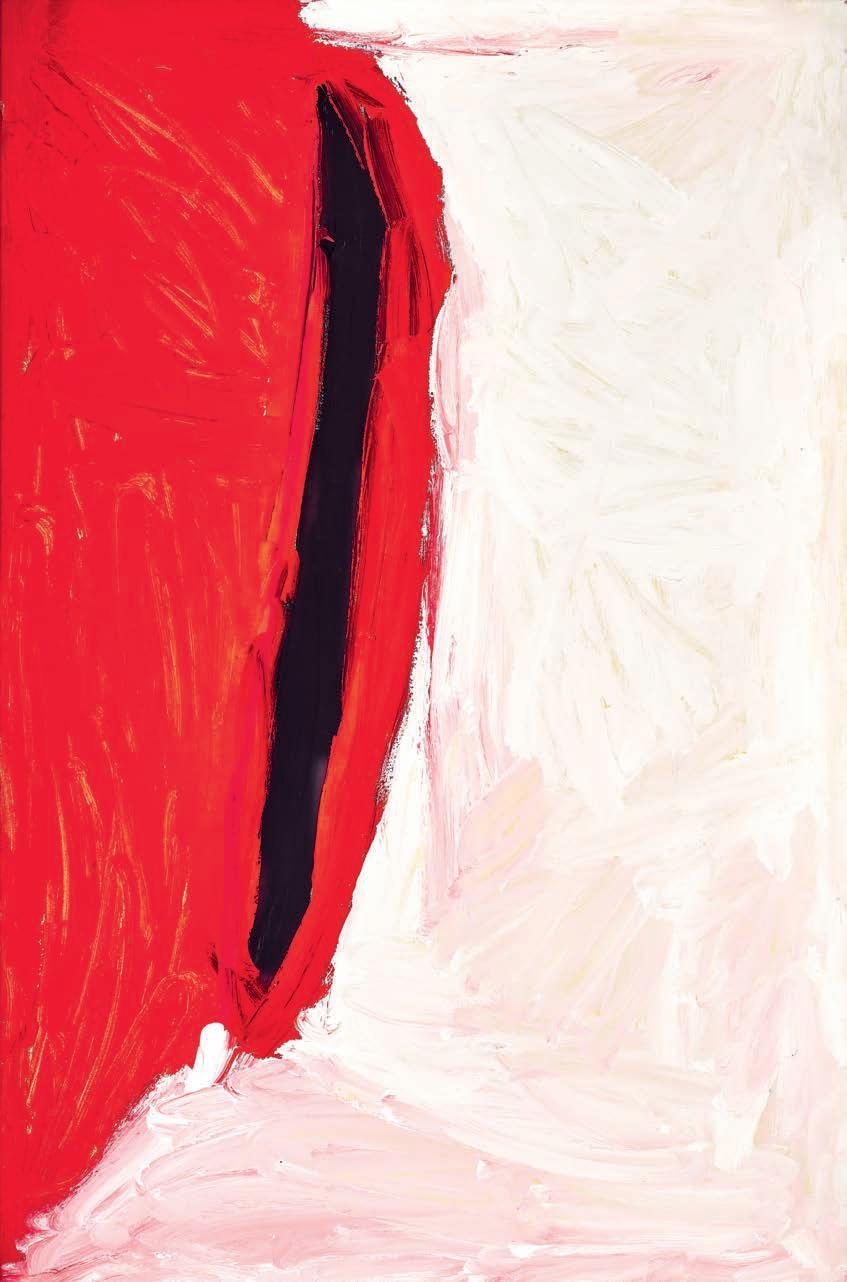
37
MIRDIDINGKINGATHI JUWARNDA SALLY GABORI
(c.1924 – 2015)
MY FATHER’S COUNTRY / THUNDI BIG RIVER, 2008 synthetic polymer paint on linen 196.5 x 100.5 cm bears inscription verso: artist’s name, title, medium, Mornington Island Arts and Crafts cat. 3072–L–SG–0308 and Alcaston Gallery cat. AK19836
ESTIMATE: $30,000 – 40,000
14
PROVENANCE
Mornington Island Arts and Crafts, Mornington Island, Queensland (stamped verso)
Alcaston Gallery, Melbourne (stamped on stretcher bar verso) Private collection, Melbourne, acquired from the above in 2018
EXHIBITED
Kaiadilt Eyes – The Art of Seeing, Alcaston Gallery, Melbourne, 23 May – 16 June 2018, cat. 15
This work is accompanied by a certificate of authenticity from Alcaston Gallery.
Born by a creek in one of Australia’s most isolated areas, Mirdidingkingathi Juwarnda Sally Gabori grew up on Bentinck Island in Northern Queensland, part of the Kaiadilt people who used marine resources to fulfil all their needs and had very little outside contact. An intense drought followed by a tidal surge made the island uninhabitable, and at the age of 24 Mirdidingkingathi (meaning born at Mirdidingki River) Juwarnda (her totem, the dolphin) Sally Gabori and her family were persuaded to move to Mornington Island – a move that prompted feelings of huge loss for the Kaiadilt people. Gabori began her art career late in life, at the age of 85, however unlike many other Aboriginal language groups, the Kaiadilt did not have a tradition of mark making, whether on tools, objects or bark. Taking this cultural background into consideration, Gabori’s style is completely self-made, conjured from maps in her mind of Bentick Island and the country she loved.
My Father’s Country, 2008 is a colourful, gestural and expressive tribute to the landscape and history of this country to the northern tip of Bentinck Island, her father’s country or Thundi. As with much of the Island, this area is characterised by a low-lying landscape with a river that runs into a large salt pan that fills in the wet season and is flanked my mangroves. Adjacent is a ridge of tall sandhills which line the northeastern tip of the Island.1
1. McLean, B., ‘Dulka Warngiid; The Whole World’ in Mirdidingkingathi Juwarnda Sally Gabori Dulka Warngiid; Land of All, Queensland Art Gallery I Gallery of Modern Art, Brisbane, 2016, p. 22
CRISPIN GUTTERIDGE
38 IMPORTANT AUSTRALIAN INDIGENOUS ART

39
FRED GRANT born
1946
TJALTU, 2017
synthetic polymer paint on canvas 200.0 x 237.0 cm
bears inscription verso: artist’s name, date and Spinifex Arts Project cat. 17–307
ESTIMATE: $20,000 – 30,000
PROVENANCE
Spinifex Arts Project, Tjuntjuntjara, Western Australia
RAFT Artspace, Alice Springs, Northern Territory
Private collection, New South Wales
EXHIBITED
Fred and Ned Grant, RAFT Artspace, Alice Springs, 8 – 29 September 2018
Truth: Then Now Everywhen, University of Newcastle Gallery, New South Wales, 1 April – 3 May 2022
This painting is accompanied by a certificate of authenticity from the Spinifex Arts Project.
Born Nguramuta in 1943 at Ukatjatjara, located in north-east Spinifex Country in Western Australia, Fred Grant lived a traditional life on country with his elder brothers Ned (Kungaru) and Ted. Just prior to undergoing initiation in their early teenage years, the brothers were located by missionaries and government officials and transported 600 kilometres west to Cundalee Mission, close to Kalgoorlie. Removed from their country due to an enduring drought and the disturbance of traditional life as a result of the Maralinga atomic bomb testing and the rocket testing at Woomera, Fred subsequently went ‘through’ the Law with older brother and ngalungku (contemporary initiate), Ned, in the ranges north of Laverton. In the early 1990s, Ned and Fred finally returned to their homelands, some fifty years later, and were instrumental in the Spinifex land claim which was granted in the year 2000. Fed Grant was married to fellow artist, Carlene West, until her death in 2021, and now resides on country at Tjuntjuntjara
Fred Grant is the custodian of Kulpara, (the Magpie), who is closely associated with the Wati Kutjara Tjukurpa (Two Men story) – a story whose influence spreads widely across Pitjantjatjara, Ngaanyatjarra and Pintupi lands. As the accompanying certificate explains, Tjaltu 2017 is typical of Fred’s iconographical maps of Country, showing a ‘major site that forms part of the Wati Kutjara Tjukurpa (two Men creation line). This is an epic story that traverses vast amounts of Spinifex Country as it follows two brothers in their search for wives. Mulya maru (black nosed monitor) and tinka (sand goanna) are the creation beings that metamorphosise between animal and man as they shape the landscape, to leave physical and moral reminders of their presence. Here at Tjaltu, are two rock holes representing the brothers and their existence still today. Fred has painted the many sites and travelling tracks that they passed and stopped at on their way to this site.’1
1. See the accompanying Spinifex Arts Project certificate of authenticity.
CRISPIN GUTTERIDGE
40 IMPORTANT AUSTRALIAN INDIGENOUS ART
15

41
NELLIE STEWART
(c.1938 – 2012)
MINYMA KUTJARA, 2011 synthetic polymer paint on linen 200.0 x 200.0 cm bears inscription verso: artist’s name, date and Tjungu Palya Artists cat. TPNS11175
ESTIMATE: $12,000 – 16,000
PROVENANCE
Tjungu Palya Artists, Nyapari, South Australia Private collection, Sydney
Nellie Stewart was a senior Pitjantjatjara woman, born in her father’s country at Pipalyatjara in the Tomkinson Ranges, South Australia sometime in the late 1930s. Her bold and colourful paintings draw on her cultural connection to country as a senior custodian and authoritative teller of the women’s Tjukurpa (Dreaming stories) from this region, particularly the Minyma Kutjara (Two Sisters Creation story). As a young girl Nellie attended school at the Ernabella Mission and later worked in Alice Springs teaching Pitjantjatjara language with her husband. She first began painting in 2007 when she moved to Nyapari with her family.
Minyma Kutjara, 2011 incorporates landmarks shaped during the epic journeys and activities of the creation ancestors. Here the two sisters are at Nyapari during the creation time, the elder sister is teaching the younger sister ceremonial law. They are singing and dancing together as they travel to Punuwara before moving on to Docker River in the Northern Territory. With a limited palette of reds, yellows, and pinks, Nellie Stewart uses a technique of over-painting a dark ground, and uses brushstrokes that evoke ceremonial body painting designs, handling her brush in a manner akin to the way women use their fingers to smear layers of paint onto the bodies of ceremonial dancers.
42 IMPORTANT AUSTRALIAN INDIGENOUS ART
16
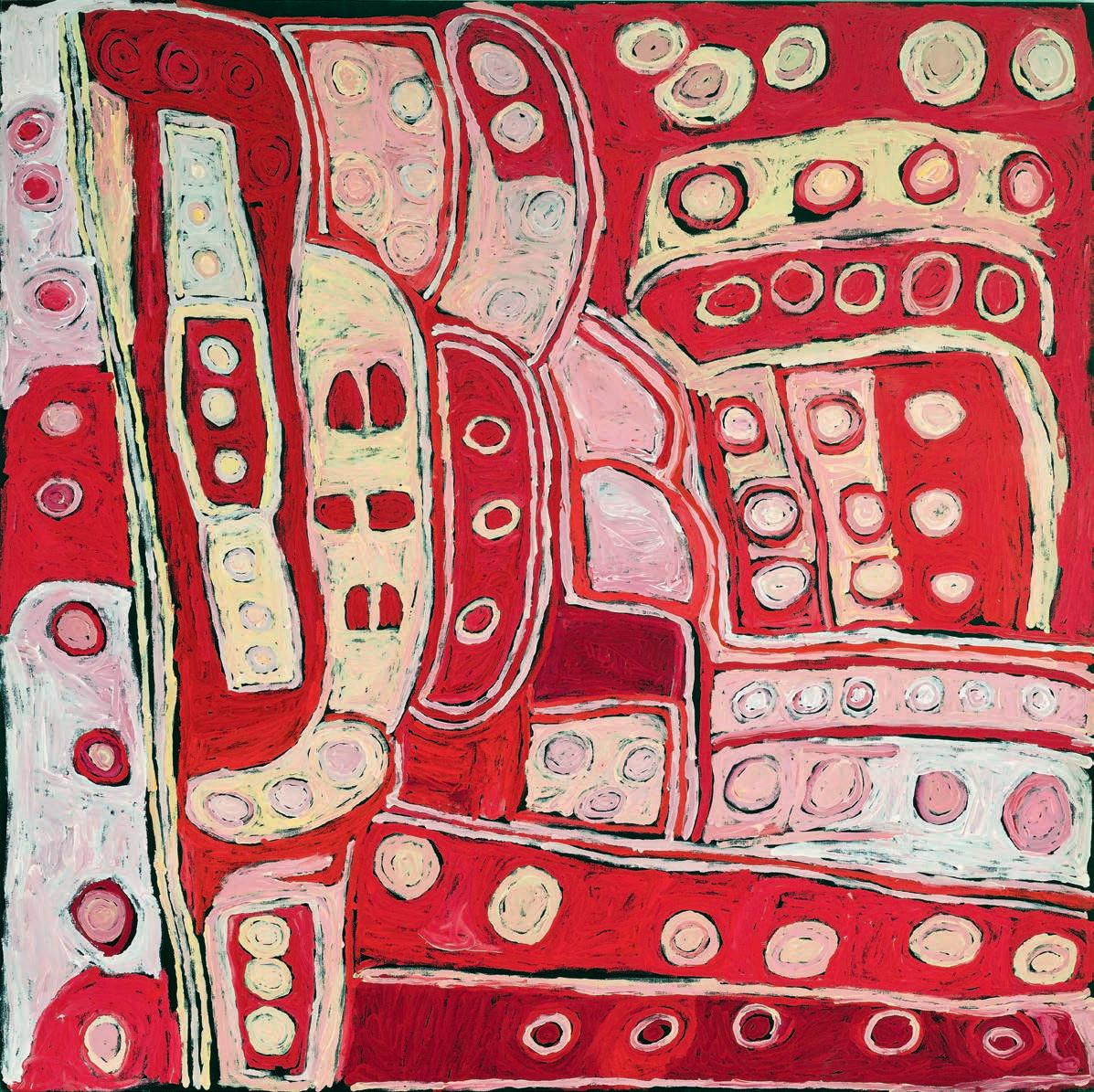
43
JIMMY BAKER
(c.1915 – 2010)
KATATJITA, 2007
synthetic polymer paint on canvas 201.5 x 115.0 cm
bears inscription verso: artist’s name, community, date and Tjungu Palya Artists cat. 07480
ESTIMATE: $14,000 – 18,000
PROVENANCE
Tjungu Palya Artists, Nyapari, South Australia Aboriginal and Pacific Art, Sydney Private collection, Sydney
This work is accompanied by a copy of a certificate from Tjunga Palya Artists which states:
‘This is Katatjitj. It is close to Kanpi. There is a big underground cave here with water inside. It only has a small entrance, but once inside it is a big space. Malilu (a woman from the creation time) dug out this cave to be her home. If you look around inside the cave you can see her bed and chair. There are also rock formations which are the remains (bones) of the kangaroo she was eating. Malilu was a crippled woman and her two daughters had run off, leaving her to fend for herself. It was very hard for her to collect bush foods and water because she had to drag her leg as she walked. Tjukurpa mulapa (this is a true story). Ngayuku (this is my story) Kanpi (for Kanpi).’
44 IMPORTANT AUSTRALIAN INDIGENOUS ART
17

45
BILL WHISKEY TJAPALTJARRI
(c.1920 – 2008)
ROCKHOLES AND COUNTRY NEAR THE OLGAS, 2007 synthetic polymer paint on linen 121.0 x 121.0 cm
bears inscription verso: artist’s name, size and Watiyawanu Artists cat. 03–07–253
ESTIMATE: $15,000 – 20,000
PROVENANCE
Watiyawanu Artists of Amunturrungu, Mount Leibig, Northern Territory
Tony Bond, Adelaide
Private collection, Adelaide
After having watched the women at Amunturrungu (Mount Liebig) paint in the new ‘Watiyuwanu’ art centre for some time, in December 2004, aged 85, Bill Whiskey (Mindinderi) walked in one day, sat down and began to paint. His paintings, executed with an immediate and distinct authority, rapidly drew attention to him and granted him almost instant fame.
In the space of a few short years, he created an astonishing body of paintings that quickly entered major public and private collections, both nationally and abroad. In 2006, and again in 2007, he was also a finalist in the Telstra National Aboriginal and Torres Strait Islander Art Award.
Born around 1920 at Pirupa Akla (Olgas) in Pitjantkatjara country, Whiskey eventually moved to the outstation of Amunturrungu with his wife, Colleen Nampitjinpa, where they both held prominent roles as Ngangari (traditional healers). There are stories that at night Whiskey would leave his body and fly over the landscape; upon his return he would report on what he had seen.
This painting describes events related to the story of the ancestral white cockatoo and her terrible battle to ward off the murderously amorous Crow, an event which took place near the artist’s birthplace at the rock holes of Pirupa Alka (rock holes near the Olgas and Uluru.) The depiction of country is also associated with the journeys Whiskey made as a young man to Areyonga and Haasts Bluff. The variegated surface and mixed palette and the sheer scope of its recording of Country is handled with a virtuosic delicacy evocative of filigree, while the subtlety of the shifting rhythms is controlled on a monumental scale by the density and variety of dotting. The hovering roundels together with the heady use of colour (red, gold and ochre with an extensive overlay of white on a black ground) lend this work a shimmering radiance seen only a small number of the works he executed.
CRISPIN GUTTERIDGE
46 IMPORTANT AUSTRALIAN INDIGENOUS ART
18

47
MIRDIDINGKINGATHI JUWARNDA SALLY GABORI (c.1924 – 2015)
DIBIRDIBI COUNTRY, 2006 synthetic polymer paint on linen 197.0 x 101.0 cm bears inscription verso: artist’s name, title, medium and Mornington Island Arts and Crafts cat. 1246–L–SG–0506
ESTIMATE: $30,000 – 40,000
PROVENANCE
Mornington Island Arts and Crafts, Mornington Island, Queensland (stamped verso)
Private collection, Sydney, acquired from the above in 2007
This painting is accompanied by a certificate from Mornington Island Arts and Crafts which states:
‘This is my husband’s country on Bentinck Island.’
In 1948, following a series of natural disasters, Sally Gabori along with the other inhabitants of Bentinck Island were forced to relocate to Gununa on nearby Mornington Island. Gabori had spent the first few decades of her long life on Bentinck Island, the island of her birth, living off the natural resources of the surrounding ocean and estuaries in the traditions of the Kaiadilt. Although Gabori resided on Mornington Island for the remainder of her long life, her connection to Bentinck Island life and culture was innate, and her success as an artist enabled her to return to country through her paintings.
Dibirdibi Country, 2006 evokes one of Sally Gabori’s favourite subjects, the country of her husband, Kabarrarjingathi Bulthuku Pat Gabori – a subject and location painted more often by the artist than any other. The country of her husband and the Rock Cod Ancestor, this painting shows a large saltpan that runs across her husband’s country close to the site where the liver of Dibirdibi, the Rock Cod Ancestor, was thrown at the sea’s edge, creating a permanent fresh-water spring. A central ovoid form is repeated and surrounded by blocks varied colours, created by strong gestural mark-making, but for Gabori, Dibirdibi is also personal, her husband Pat Gabori was also called Dibirdibi and was custodian of the story, songs and sites associated with Dibirdibi . Her canvases are an expression of both her love for her husband and the landscape of her country.
CRISPIN GUTTERIDGE
48 IMPORTANT AUSTRALIAN INDIGENOUS ART
19

49
MIRDIDINGKINGATHI JUWARNDA SALLY GABORI (c.1924 – 2015)
MY FATHER’S COUNTRY, 2009 synthetic polymer paint on linen 198.0 x 101.0 cm
bears inscription verso: artist's name, title, medium, Mornington Island Arts and Crafts cat. 4556-L-SG-0709 and Alcaston Gallery cat. AK15350
ESTIMATE: $25,000 – 35,000
20
PROVENANCE
Mornington Island Arts and Crafts, Mornington Island, Queensland (stamped verso)
Alcaston Gallery, Melbourne (stamped verso)
Private collection, Melbourne, acquired from the above in 2016
EXHIBITED
Sally Gabori: Painted Island Home , Alcaston Gallery, Melbourne, 5 July – 6 August 2016
This work is accompanied by certificates of authenticity from Alcaston Gallery and Mornington Island Arts and Crafts which states:
'This is the big river at Thundi, my Father's country on Bentinck island.'
50 IMPORTANT AUSTRALIAN INDIGENOUS ART

51
PRINCE OF WALES (MIDPUL) (c.1935 – 2002)
BODY MARKS, 2001
synthetic polymer paint on linen
140.0 x 60.5 cm (each)
140.0 x 121.0 cm (overall)
i. bears inscription verso: artist’s name, date, size and Karen Brown Gallery cat. KB0300
ii. bears inscription verso: artist’s name, date, size and Karen Brown Gallery cat. KB0304
ESTIMATE: $20,000 – 30,000 (2)
PROVENANCE
Commissioned by Karen Brown Gallery, Darwin Private collection, Adelaide, acquired from the above in 2001
Renowned for his unique interpretations of body decorations and markings used in the ceremonial activities of the Larrakia people, Prince of Wales (Midpul) drew inspiration from these traditional activities for the imagery in his contemporary paintings. Born Midpul at Kah’lin (Cullen) Beach, Darwin in 1935, Prince grew up at Belyuen (Dellisaville), a small community on the far side of Darwin Harbour. He was the son of acknowledged Larrakia leader and traditional landowner Imabul (Old King George) and known as Prince of Wales. A custodian and leader of Larrakia ceremonies and dances, a leading didgeridoo player and ceremonial body painter for much of his life, Prince started painting, initially on discarded pieces of wood and cardboard in 1995, and participated in his first exhibition the following year.
‘In taking up painting in 1995, Prince found a medium through which he could retain the essence of his active ceremonial life. His paintings have a musicality imparted by the lively staccato effect of the dots
and intermittent bars, as if to read like sheet music for an improvised symphony. Prince’s uninhibited use of colour belies the origins of these designs which were passed on by his ancestors as marks on the bodies of ceremonial participants.’1
Executed on a white ground, Body Marks , 2001 reinforces the ceremonial body decorations that Prince of Wales wanted to preserve in his painting. Alternate white, bronze and deep marine blue dots of the body marks are contained within an ultramarine-coloured frame that together creates a rhythmic energy within the work. These markings evoke the patterns Prince would have originally painted onto the bodies of his clansmen prior to a ceremonial dance, but here they are transferred as a permanent record for posterity. The work was painted in the final years of his life and as Perkins notes ‘In his last years, Prince ‘upped the ante’, scaling up his Body Marks paintings to assert his cultural authority as a Larrakia elder.’ 2 ‘These paintings... I paint them on bodies... young people and old... ceremony for singing... dance... I make the marks.’3
Prince held his first solo show in Melbourne in 1997 at Gallery Gabrielle Pizzi, and in 2001, he won the painting sections of the Telstra National Aboriginal and Torres Strait Islander Art Award. Prince delighted in the whole process of painting, creating modern minimalist art works characterised by simple geometric forms floating above a sparse ground, with dotting emphasising the forms.
1. Perkins, H., Tradition Today; Indigenous Art in Australia, Art Gallery of New South Wales, Sydney, 2004, p. 166
2. ibid.
3. The artist, cited in ‘Notes on Prince of Wales and the Gwalwa Daraniki Land Movement’, kindly provided by the late Grant Smith of Gallery Gabrielle Pizzi.
CRISPIN GUTTERIDGE
52 IMPORTANT AUSTRALIAN INDIGENOUS ART
21
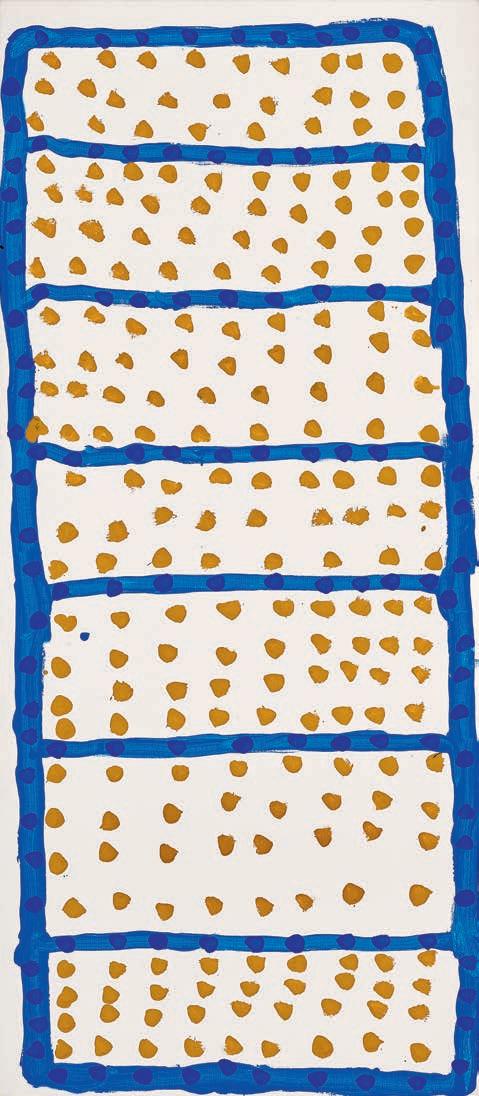
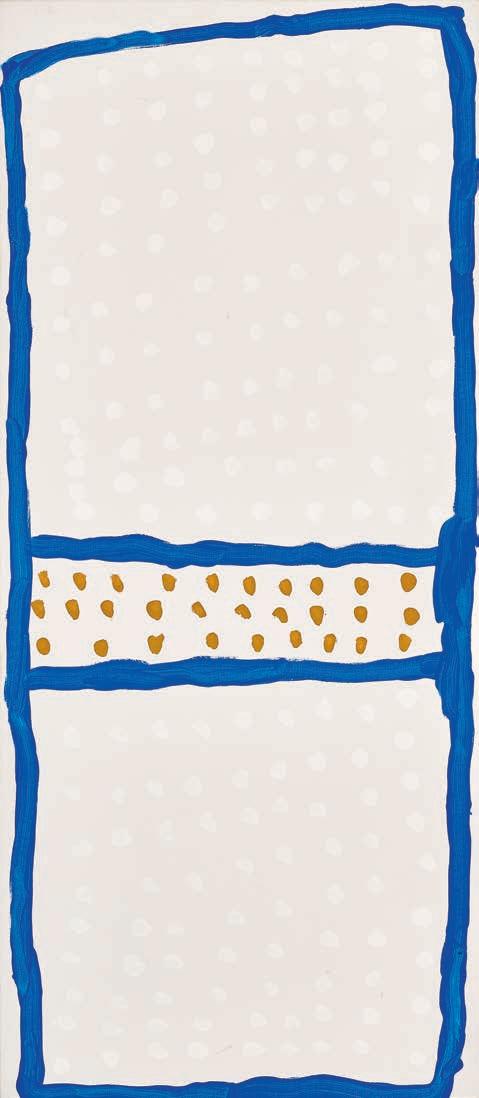
53
ANGELINA NGALE APWERL (PWERLE) born c.1946
ANOOKITJA (BUSH PLUM), 2019 synthetic polymer paint on linen 150.0 x 121.0 cm
bears inscription verso: artist’s name and Delmore Gallery cat. 19J015
ESTIMATE: $40,000 – 60,000
PROVENANCE
Delmore Gallery, Alice Springs, Northern Territory
Maunsell Wickes Gallery, Sydney Private collection, USA
This work is accompanied by a certificate of authenticity from Delmore Gallery which states:
'Angeline Kngale’s artworks are painstaking labours of love. Her attention to detail would sometimes mean she would take several weeks at a time to complete a large masterpiece. Often in summer, the conkerberry bush or wild plum (that she calls anwekety in her Anmatyerre language) inspired her and produced an abundant crop of succulent sweet berries as she completed her paintings. Traditionally, Angeline (sometimes called Angelina) and her older sisters, Polly and Kathleen, would cover their upper bodies with emu oil; using ochre paints they would be decorated with specific designs related to the wild plum (anwekety), then they danced and sang (awelye) the story of the anwekety as a vital part of nature's cycle, to ensure the profundity and continued productivity of this valuable food source. Angelina is a very consistent, meticulous artist who is now in greater demand than ever. This is a wonderful example of her work.'
54 IMPORTANT AUSTRALIAN INDIGENOUS ART
22

55
EMILY KAM KNGWARREYE
(c.1910 – 1996)
UNTITLED, 1994
synthetic polymer paint on linen 150.0 x 90.0 cm
signed verso: Emily bears inscription verso: artist’s name and Delmore Gallery cat. 94C038A
ESTIMATE: $50,000 – 70,000
23
PROVENANCE
Commissioned by Delmore Gallery, via Alice Springs, Northern Territory in March 1994
Private collection, Victoria
56 IMPORTANT AUSTRALIAN INDIGENOUS ART

57
EMILY KAM KNGWARREYE
(c.1910 – 1996)
UNTITLED (ALHALKERE COUNTRY), 1993 synthetic polymer painting on canvas 121.5 x 90.0 cm bears inscription verso: artist’s name and Delmore Gallery cat. 93F068
ESTIMATE: $30,000 – 40,000
PROVENANCE
Commissioned by Delmore Gallery, via Alice Springs, Northern Territory in 1993
Private collection
Gallery one93, Queensland
Private collection, Queensland, acquired from the above
This painting is accompanied by a certificate from Delmore Gallery which states in part:
‘In Alhalkere Country, the progression of colour from the dry earth tones to lush green growth, and then to the delicate colours of wildflowers, is slow after a winter rain. An invigorated mood is all pervading as all life waits for an early glimpse of warmth to give plants that final bit of zest to produce a desert in full carpeted bloom. Once this occurs, the bloom is brief and settles into a dry state. The wild flower may seem sparse, but on close inspection have exceptional colour tones. The colours are sombre, of deep green leaves in misty acacia grey dawns over frosted, dried–off grasses, and small pink and white wild flowers. This wonderful work is an aerial perspective of the winter landscape, celebrating the abundant food source it provided.'
58 IMPORTANT AUSTRALIAN INDIGENOUS ART
24

59
MAKINTI NAPANANGKA
(c.1930 – 2011)
UNTITLED, 2007
synthetic polymer paint on Belgian linen
122.5 x 92.0 cm
bears inscription verso: artist’s name, size and Papunya Tula Artists cat. MN0701158
ESTIMATE: $18,000 – 25,000
PROVENANCE
Papunya Tula Artists, Alice Springs, Northern Territory
Private collection, Melbourne, acquired in 2007
The richly-coloured expressive compositions of senior Pintupi artist Makinti Napanangka act as visual recollections of the artist’s deep cultural understanding and authority, with each of her painterly compositions visually encoded with Pintupi ancestral and ceremonial knowledge. Recurring across her oeuvre Napanangka depicted the designs associated with the rock hole site of Lupulnga, over which she had custodial rights. Through her compositions of sweeping and wavering linear planes in the shades of yellow, orange, blue and white, Napanangka translates elements related to the cultural stories of the Peewee (small bird) Dreaming and the travels of the Kungka Kutjarra (Two Ancestral Women) associated with this ceremonial site of Lupulnga.
Napanangka joined Papunya Tula Artists in 1996 and prior to her death in 2011, was the most senior woman painting with Papunya Tula Artists. Stylistically, as reflected by Hetti Perkins, the visual language of Napanangka’s works owe ‘more to the gesture of handpainting ochre onto the body for women’s ceremonies, than to the meticulous application of dots that characterises men’s ceremonial and contemporary art making.’1
The undulating and twisting forms that denote Untitled , 2007, exemplifies Napanangka’s haptic and rhythmic approach. In this work, Napanangka reflects her mastery in enlivening the gently entwined and flowing gestural linear bands of alternating yellow, white and orange hues, in an artistic gesture to echo the movement of the spun hair-string skirts (nyimparra), worn in Pintupi women’s ceremonies, in reference to the Kungka Kutjarra. As Perkins states ‘the celebratory nature of these performances is expressed in the hedonistic play of colour and form across the painting’s surface.’ 2
1. Perkins, H., Tradition Today: Indigenous Art in Australia, Art Gallery of New South Wales, Sydney, 2004, p. 108
2. ibid.
GEORGIE LATHAM
60 IMPORTANT AUSTRALIAN INDIGENOUS ART
25

61
NAATA NUNGURRAYI
(1932 – 2021)
MARRAPINTI, 2004
synthetic polymer paint on linen 122.0 x 91.5 cm
bears inscription verso: artist’s name, size and Papunya Tula Artists cat. NN0409127
ESTIMATE: $12,000 – 18,000
PROVENANCE
Papunya Tula Artists, Alice Springs, Northern Territory
Tony Bond, Adelaide
Private collection, Adelaide
Born around 1932, senior Pintupi artist Naata Nungurrayi is celebrated for works which act as visual manifestations of her lived experience and intangible cultural knowledge. As the artist describes: ‘I am painting my home, my Country — women’s Kanaputa story. Travelling along Irrututu, Tjuntupul, Marrapinti, Ngami, Wirrul. A long time ago, I travelled all around this Country, from place to place.’1 Across her practice, Nungurrayi visually translated facets of the geographies and topographies of culturally significant sites and designs associated with Kungka (Women) Dreaming – specifically her home of Marrapinti, a sacred waterhole located to the west of Pollock Hills, Western Australia, where a group of travelling ancestral women stopped and made nosebones (known as marrapinti), to be worn in the context of ceremonial occasions by older generations of Pintupi.
Painted in warm hues, the vibrantly coloured composition, Marrapinti, 2004, reflects the way Nungurrayi painted with a ‘singled-minded, trance like’ focus, and ‘an intensity that matches the colours at play in her work’. 2 In this work, the densely layered and modulated fields of warm dotted colour, overlaid with bold gestural lines, typify Nungurrayi’s mastery in rendering the depth and intangible energy of country, with these interconnecting lines representing the living presence of the tali (sandhills) of her Country. As Luke Scholes articulates, ‘Naata is one of Papunya Tula Artists’ most celebrated painters. A quintessential Pintupi eccentric, briming with life and a rare, painterly gift.’ 3
1. Nungurrayi, cited in unDisclosed: 2nd National Indigenous Art Triennial, National Gallery of Australia, Canberra, 2012, p. 99
2. Perkins, H., Art+Soul, The Miegunyah Press, Melbourne, 2010, p. 26
3. Scholes, L., Beyond Sacred: Australian Aboriginal Art: The Collection of Colin and Elizabeth Laverty, Edition II, Kleimeyer Industries Pty Ltd, Melbourne, 2011, p. 58
GEORGIE LATHAM
62 IMPORTANT AUSTRALIAN INDIGENOUS ART
26

63
GINGER RILEY MUNDUWALAWALA
(c.1936 – 2002)
LIMMEN BIGHT COUNTRY, 1995 synthetic polymer paint on canvas 188.0 x 196.0 cm bears inscription verso: artist’s name, date and Alcaston Gallery cat. AK3314
ESTIMATE: $50,000 – 70,000
PROVENANCE
Painted at Borroloola, Northern Territory Alcaston Gallery, Melbourne
Private collection, Melbourne, acquired from the above
This painting is accompanied by a certificate from Alcaston Gallery.
‘My mother’s country is in my mind.’1
Distinguished by their daring palette, dynamic energy and strongly flattened forms, Riley’s bold, brilliantly coloured depictions celebrating the landscape and mythology of his mother’s country are admired among the finest in contemporary Indigenous art. Emerging at a time when barks were the familiar output for his Arnhem Land country and Papunya Tula paintings were considered the norm, his striking interpretations not only challenged, but irrevocably changed, preconceived notions of Indigenous art – thus earning him the moniker ‘the boss of colour’ by artist David Larwill. Notably influential upon such idiom was Riley’s chance encounter during his adolescence with celebrated watercolourist Albert Namatjira, whose non-traditional aesthetic and concept of ‘colour country’ left an indelible impression upon the young artist. Encouraged by ‘…the idea that the colours of the land as seen in his imagination could be captured in art with munanga (white fella) paints’, 2 it was not, however, until three decades later that Riley would have the opportunity to fully explore his talent when the Northern Territory Open College of TAFE established a printmaking workshop in the Ngukurr Aboriginal Community (formerly known as the Roper River Mission). Notwithstanding his mature age of 50, Riley rapidly developed his own highly sophisticated style and distinct iconography and, after initially exhibiting with the other Ngukurr-based painters, soon established an independent career at Alcaston Gallery. Enjoying tremendous success both locally and abroad over the following sixteen years before his untimely death in 2002, Riley received a plethora of awards including the inaugural National Heritage Commission Aboriginal and Torres Strait Islander Art Award in 1993 and an Australia Council
Fellowship in 1997 – 98, and in 1997, was the first living indigenous artist to be honoured with a retrospective at the National Gallery of Victoria, Melbourne.
Capturing the saltwater area extending from the coast of the Gulf of Carpentaria along the Limmen Bight River to the weather-worn rocky outcrops known as the ‘Four Archers’, Limmen Bight Country, 1995 offers a stunning example of Riley’s heroic landscapes. Pivotal to the composition is Garimala, the mythological Taipan who, according to the ancestral dreaming, created the Four Archers – an area regarded as ‘… the centre of the earth, where all things start and finish’3 – and lives in the waterhole nearby. Here the mythological serpent is depicted as a pair of snakes (a typical convention to denote him travelling), while the Four Arches are envisaged in multiple, emphasising their significance and reflecting different viewpoints. A dominant motif of Riley’s oeuvre, such aerial overview is informed by the artist’s strong sense of place; as he observes, he often paints ‘…on a cloud, on top of the world looking down… In my mind, I have to go up to the top and look down to see where I’ve come from, not very easy for somebody else, but all right for me. I just think in my mind and paint from top to bottom, I like that’.4 Similarly presiding over the landscape here is the totemic white-breasted sea eagle, Ngak Ngak who, depicted mid-flight, typically fulfils the role of a sentinel or guardian protecting the country, while weaving its way through the centre of the composition, the Limmen Bight River appears as an intense blue undulating ribbon, offering not only a dramatic visual accent but poignantly anchoring the work to the artist’s mother country.
A vibrant celebration of the joy of belonging to the saltwater country of the Mara people, indeed the work embodies Riley’s powerful vision of his mother’s country as a mythic space – a mindscape whose kaleidoscope of dazzling colours and icons continually evoke wonder and mystery in the viewer with each new encounter.
1. Riley, cited in Ryan, J., Ginger Riley, National Gallery of Victoria, Melbourne, 1997, p. 15
2. Riley, cited ibid.
3. Riley, ibid., p. 29
4. Riley, ibid., p. 27
64 IMPORTANT AUSTRALIAN INDIGENOUS ART
27
VERONICA ANGELATOS

65

watercolours by Albert Namatjira
‘…Many years ago, an Aboriginal man from central Australia, Albert Namatjira, became very famous as a painter. Using Western watercolour techniques he painted many landscapes. But what nonaboriginal people didn’t understand, or chose not to understand, was that he was painting his country, the land of the Arrernte people. He was demonstrating to the rest of the world the living title held by his people to the lands they had been on for thousands of years.’1
Although an accomplished craftsman producing poker work decorated woomeras, boomerangs and wooden plaques, it was not until viewing an exhibition of watercolours by Victorian artists Rex Battarbee and John Gardner at the Hermannsburg Mission in 1934, that Albert Namatjira truly embarked upon painting as a profession. Immediately captivated by the medium, he pleaded to be taught watercolour techniques and eventually Battarbee agreed to Namatjira accompanying him on two month-long expeditions in 1936 through the Palm Valley and MacDonnell Range areas. And thus began the cultural exchange that was to become a defining feature of their long relationship; Battarbee instructing Namatjira about the Western technique of watercolour painting, and in turn, Namatjira imparting his sacred knowledge about the subjects they were to paint, namely the land of the Western Arrente people, his ‘Dreaming’ place. So impressive was Namatjira’s skill that Battarbee remarked after only a brief period, ‘I felt he had done so well that he had no more to learn from me about colour’. 2 Success and recognition soon followed and Namatjira was launched into the spotlight as a cultural ‘icon’ – internationally acclaimed and admired for his innovative, vibrantly coloured desert landscapes that encouraged ‘new ways of seeing the Centre.’
Lots 28 – 32 popularity and fame continuing throughout his lifetime, praise for Namatjira’s skilful adaptation of a Western medium was inevitably accompanied by a bitter twist; his paintings ‘…were appreciated because of their aesthetic appeal, but they were at the same time a curiosity and sign that Aborigines could be civilised’. 3 Ironically such perceived ‘assimilation’ would later bring his art into disrepute with Namatjira virtually ignored by the Australian art establishment during the 1960s and 70s. Fortunately, the Papunya Tula Aboriginal art ‘renaissance’ and cultural politics of reconciliation during the 80s prompted long overdue reassessment of Namatjira’s unique contribution, and more recently, he has received the recognition he so deserves with three biographies published, and three major exhibitions mounted by public galleries, including a retrospective at the National Gallery of Australia in 2002 to celebrate the centenary of his birth, Seeing the Centre: The Art of Albert Namatjira 1902 – 1959
If today it is synonymous with our vision of the Australian outback, Namatjira’s art nevertheless suffered various vicissitudes over the course of the last century. Although his first solo exhibition in 1938 at the Fine Arts Society in Melbourne was a sell-out success, with
Opposite:
ALBERT NAMATJIRA
(1902 – 1959)
Ghost Gums, North MacDonnell Ranges (detail)
Capturing the landscape west of Alice Springs – and specifically, his favoured western Arrernte sites of the MacDonnell Ranges (Tjoritja), Simpson’s Gap (Rungutirpa) and Jay Creek – indeed the following five lots offer superb examples of Namatjira’s achievements in their brilliantly-coloured palette and distinctive, Western-style topographical format. Beyond their striking aesthetic appeal however, such works also resonate with important personal symbolism as statements of belonging – coded expressions embodying the memory and sacred knowledge of a traditional ancestral site, Namatjira’s ‘dreaming’ or totem place. As such, they encapsulate the unique vision that has subsequently inspired generations of Indigenous and non-Indigenous people alike across Australia – ‘Albert’s Gift’ which was more far-reaching than simply the tangible legacy of his art, ‘… more than the sum parts of watercolour paints on paper.’ As Belinda Croft elucidates, ‘It is an essence that resides in the strength of Namatjira’s work – his courage, his sorrow, his spirituality – in these days of ‘reconciliation’, but most of all, in the spiritual heritage of every indigenous person in Australia.’4
1.
2.
3.
4.
67
Galarrwuy Yunupingu cited in ‘The black/white conflict’ in Caruana, W. (ed.), Windows on the Dreaming, Australian National Gallery, Canberra, Ellsyd Press, Sydney, 1989, p. 14
Morphy, H., Aboriginal Art, Phaidon Press, London, 1998, p. 268
ibid., p. 270
Croft, B., ‘Albert’s Gift’ in French, A., Seeing the Centre: The Art of Albert Namatjira, 1902 – 1959, National Gallery of Australia, Canberra, 2002, p. 148
VERONICA ANGELATOS
ALBERT NAMATJIRA (1902 – 1959)
RANGES WEST SIMPSONS GAP
watercolour and pencil on paper 34.0 x 51.0 cm
signed lower right: ALBERT NAMATJIRA signed and inscribed with title verso: Ranges West Simpsons Gap / Albert Namatjira
ESTIMATE: $40,000 – 60,000
PROVENANCE
Dinah Krongold, Melbourne
Thence by descent
Private collection, Melbourne

68 IMPORTANT AUSTRALIAN INDIGENOUS ART
Albert Namatjira painting at Hermannsburg Mission, April 1952
photographer: M. Lockett
State Library of South Australia, Adelaide
28

69

ALBERT NAMATJIRA
(1902 – 1959)
RANGES NEAR JAY CREEK, c .1950
watercolour on paper 25.0 x 35.0 cm
signed lower right: ALBERT NAMATJIRA
signed and inscribed with title verso: Ranges Near Jay Creek / Albert Namatjira
ESTIMATE: $30,000 – 40,000
29
PROVENANCE
Private collection, Queensland
Brisbane Galleries, Brisbane
Isles Love Auction Centre, Brisbane, 7 April 1989, lot 16
Private collection, Queensland
70 IMPORTANT AUSTRALIAN INDIGENOUS ART
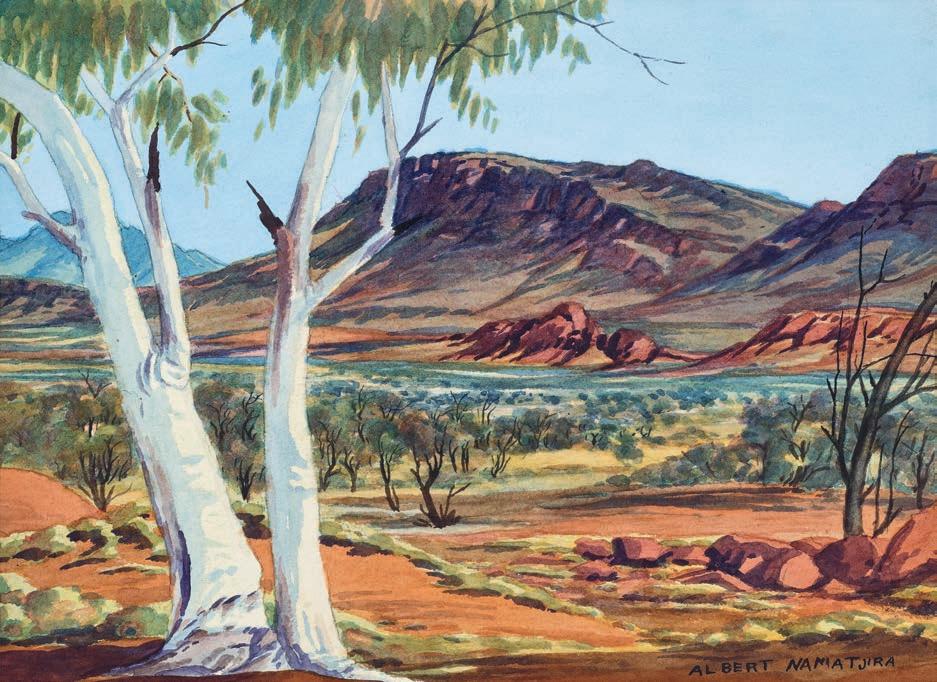
ALBERT NAMATJIRA
(1902 – 1959)
GHOST GUMS, NORTH MACDONNELL RANGES
watercolour and pencil on paper
28.5 x 38.5 cm
signed lower right: ALBERT NAMATJIRA
signed and inscribed with title verso: North Mc Donnells’ / Albert Namatjira
ESTIMATE: $30,000 – 40,000
PROVENANCE
Dinah Krongold, Melbourne
Thence by descent
Private collection, Melbourne
71
30

ALBERT NAMATJIRA
(1902 – 1959)
SOUTH RANGES FROM JAY CREEK, c .1951
watercolour and pencil on paper 31.0 x 48.0 cm
signed lower right: ALBERT NAMATJIRA
signed and inscribed with title verso: South Ranges from Jay Creek / Albert Namatjira
ESTIMATE: $28,000 – 35,000
31
PROVENANCE
Private collection, Melbourne, acquired at an exhibition in Melbourne in the mid 1950s
Thence by descent
Private collection, Melbourne
72 IMPORTANT AUSTRALIAN INDIGENOUS ART
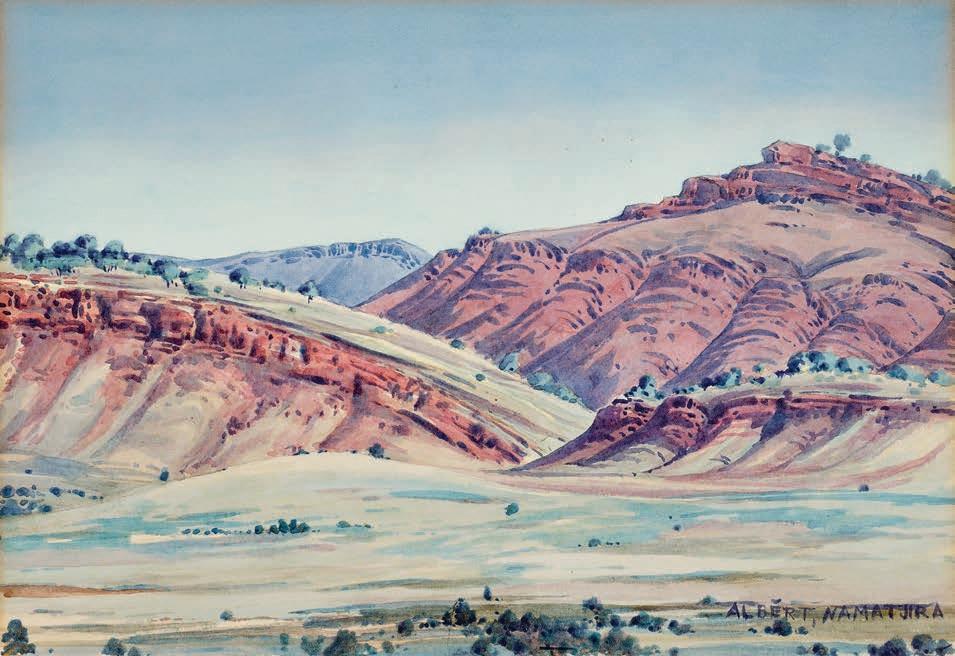
ALBERT NAMATJIRA
(1902 – 1959)
UNTITLED (CENTRAL AUSTRALIAN LANDSCAPE), c .1951
watercolour and pencil on paper on card 24.5 x 36.0 cm
signed lower right: ALBERT NAMATJIRA
ESTIMATE: $18,000 – 25,000
PROVENANCE
Grand Central Gallery, Brisbane
Private collection, Queensland, acquired from the above in 1967
Thence by descent
Private collection, New South Wales
73
32

Opposite:
EMILY KAM KNGWARREYE (c.1910 – 1996)
Alagura Landscape 1, 1994 (detail)
Important Australian Indigenous Art
Property of various vendors
Lots 33 – 66
75
MICHAEL COOK
born 1968
NATURES MORTES, 2021
suite of 8 inkjet prints on canvas 140.0 x 200.0 cm (each)
edition: 3/3
each signed, numbered and inscribed with title on artist’s stamped label verso
ESTIMATE: $60,000 – 80,000 (8)
PROVENANCE
Private collection, Brisbane, acquired directly from the artist in 2021
EXHIBITED
Natures mortes, Andrew Baker Art Dealer, Brisbane, 17 March – 1 May 2021 (another example)
Natures mortes, Living Country, Deletaille Gallery, Brussels, Belgium, 11 February – 28 May 2022 (another example)
MICHAEL COOK : NATURES MORTES , Noosa Regional Gallery, Queensland, 16 July – 4 September 2022 (another example)
HOTA Collects: Punching Up | 21st Century Indigenous Photography, HOTA Gallery, Gold Coast, Queensland, 19 October – 20 November 2022 (another example)
Still Life Now, Queensland Art Gallery | Gallery of Modern Art, Brisbane, 24 September 2022 – 19 February 2023 (other examples of Nature Morte (Agriculture) and Nature Morte (Blackbird))
RELATED WORK
Another example of this suite is held in the collection of HOTA Gallery, Gold Coast, Queensland
Other examples of images from this suite are held in the collections of Queensland Art Gallery | Gallery of Modern Art, Brisbane, and Yarilla Arts and Museum, Coffs Harbour, New South Wales
76 IMPORTANT AUSTRALIAN INDIGENOUS ART
33
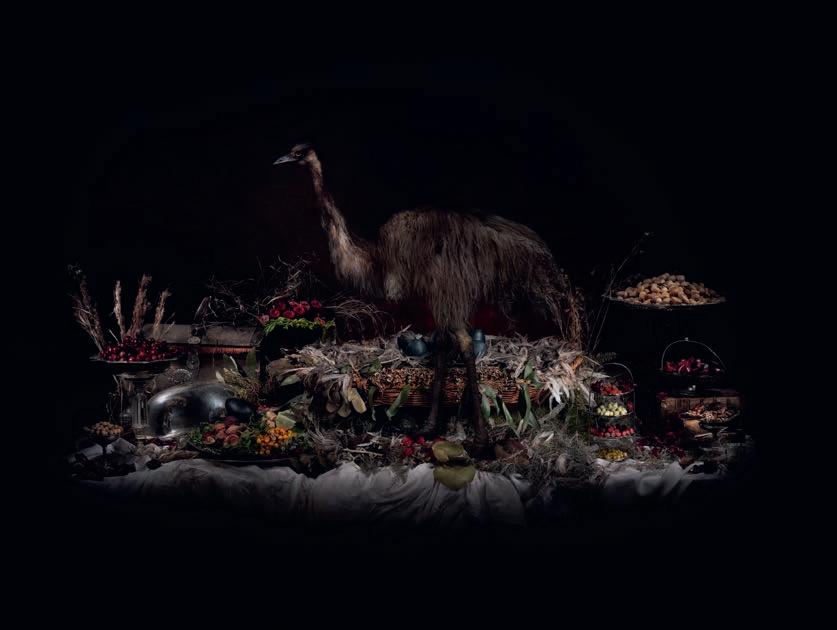

77
Nature Morte (Aliment)
Nature Morte (Veiled Bird)
Brisbane-based artist Michael Cook’s photographic works, always sumptuously presented and carefully staged, address personal and socio-political issues of post-colonial identity in Australia. The figurative works which brought him critical acclaim early in his career – Undiscovered, 2010; Civilised, 2013; Majority Rule, 2014; Object, 2014, and Invasion, 2017 – oscillated between different cultural perspectives and introduced surreal and imaginary imagery in order to disarm and amuse viewers. The recent Natures Mortes, 2021 presents a departure from this technique, concealing behind its polished traditional veneer an incisive and mournful perspective on the cumulative devastation wrought by Australian colonisation. Produced in the midst of rolling COVID pandemic lockdowns where life stood still, Cook’s suite of eight Natures Mortes are dense allegorical tableaux whose stillness and glistening penumbra lure the viewer to slowly consider the incongruous objects and their relationships – unlocking multiple layers of symbolic social commentary.
In Natures Mortes, Michael Cook borrows artistic conventions from 17th century Europe and applies these to bountiful and dramatically lit arrangements of native Australian flora and fauna. The term Natures Mortes is borrowed from French, designating the artistic form of still life with the literal meaning of ‘dead nature’. Cook appropriates the aesthetic codes of Golden Age Dutch still life painting funded by preindustrial and colonial expansion, where painters warned in their vanitas and memento mori paintings of the perils of greed and pride, and the inevitable transience of life. Now, over two hundred years later, and from an opposing post-colonial perspective, Cook reuses these stylistic codes to address similar, updated social issues, addressing them in separate individual vignettes: climate responsibility, biodiversity, religion, addiction and natural resource depletion.
Exploitation’s mouth-watering display of oil-slicked seafood, inedible for the native heron in the centre of the composition, addresses an unsustainable depletion of fossil fuels and its environmental implications. Colonisation , however, is more literal in its symbolic accoutrements of the European age of enlightenment (books, maps, inkwell, swords, spy glasses), which the artist has juxtaposed with a damaged shield standing in for the lost Gweagal shield, witness to violent encounters at the British landing in Botany Bay.1 Agriculture, in its arid and beige arrangement, shows the damage caused by land reclamation and unsustainable farming practices upholding the false god of a baked
loaf of bread. Around this central image introduced predators and pests like the barn owl, beetles and mice feast on broken blades of native Kangaroo Grass. The influence of Bruce Pascoe’s 2014 book, Dark Emu, detailing the misconceptions about indigenous agricultural land management is perceptible in this image, and quotes from the text were reprinted in the catalogue essay for first exhibition of Natures Mortes at Andrew Baker Gallery. Blackbird is a devastating memento mori, recounting the practice of ‘blackbirding’: the entrapment, lured by music, of South Sea Islanders who were forced into indentured servitude in the burgeoning sugar Queensland plantations of the 18th and 19th century. Veiled Bird, shrouded with the leaves of the dried native lily, abandons her glistening eggs, waylaid by the temptations of substance abuse, symbolised by the broken poppy stems, a snuffed out candle and mysterious phials lurking on the edges of the velvety darkness.
Using his twenty years’ experience as a commercial fashion photographer to orchestrate each of these stylised table-top cornucopias, Cook populates these still lives with native fauna, in heroic positions in the centre of each image. Under the auspices of Artspace’s collaborative project 52 Actions , Cook presented a 23 second timelapse video of the creative process of the studio photography Blackbird, Flora, Aliment 2 In it, we can deduce that the animals within Blackbird (red and yellow-tailed black cockatoos and a cane toad) and Aliment (an emu), were not physically present in either a live or taxidermised form, but were masterfully digitally introduced into the image in postproduction.
Natures Mortes is reported to have been Cook’s most successful body of work to date, with all three edition sizes sold out. 3 The works are well represented in Cook’s home state of Queensland, with examples acquired by the Queensland Gallery of Modern Art and a full suite acquired by the new HOTA Gallery at Surfers Paradise. Significantly, Veiled Bird, was also the winner of 2021 acquisitive National Still Life Award at Yarilla Art and Museum, in Coffs Harbour.
1. Fairley, G., ‘Exhibition Review: Michael Cook Natures Mortes at Andrew Baker Art Dealer (QLD)’, ArtsHub, 7 April 2021
2. 52 Actions, Artspace, Sydney, 2021; see https://www.artspace.org.au/52-actions/52-actions/ michael-cook (accessed February 2024)
3. Hawkins, S., ‘Michael Cook’, Head On Foundation Magazine, 26 November 2021: see https:// headon.org.au/magazine/michael-cook (accessed February 2024) and Michael Cook, Natures Mortes at https://www.michaelcook.net.au/projects/natures-mortes (accessed February 2024)
LUCIE REEVES SMITH
78 IMPORTANT AUSTRALIAN INDIGENOUS ART


Nature Morte (Agriculture)

Nature Morte (Religion)

Nature Morte (Colonisation)

Nature Morte (Exploitation)

Nature Morte (Flora)
79
Nature Morte (Blackbird)
PROVENANCE
DARREN SIWES born
34
1968
BRONZE GIRL, SILVER GIRL, GOLD GIRL, 2008 from the OZ OMNIUM REX ET REGINA series suite of 3 Type C prints on Kodak Endura Metallic paper 90.0 x 120.0 cm (each) edition: 7/10
each signed on gallery label verso: D Siwes each bears inscription on gallery label verso: artist’s name, title, date, edition, medium and size
ESTIMATE: $10,000 – 15,000 (3)
Greenaway Art Gallery, Adelaide (label attached verso) Private collection, Adelaide
EXHIBITED
Oz Omnium Rex Et Regina, Greenaway Art Gallery, Adelaide, 25 July – 17 August 2008
With his enduring interest in issues of class, culture, place and identity – and the inequities pervading these systems – acclaimed Adelaideborn artist, Darren Siwes, is fast becoming one of the most highly sought-after photographic artists of his generation. A Ngalkban man of Indigenous and Dutch descent, Siwes completed a Bachelor of Visual Arts (Hons) at the University of South Australia in 1996, and subsequently a Graduate Diploma of Education in 1997. In 2002, he was awarded a Samstag International Visual Arts Scholarship which enabled him to undertake a Master of Fine Art at the Chelsea School of Art in London, and today his work is held in numerous major public collections, both nationally and abroad, including The Art Gallery of South Australia, Adelaide; the National Gallery of Australia, Canberra; and the Museo Nacional Centro de Arte Reina Sofia Madrid, Spain.
Inspired by contemporary Indigenous artists such as Tracey Moffatt and Gordon Bennett, Siwes’ work similarly explores space, place and identity, highlighting racial tensions and the reality of the perceptions of Aboriginal people. In particular, he has achieved acclaim for his nocturnal images of ethereal figures, created using time-lapse photography and shot in recognisable landmarks around Adelaide, the United Kingdom and most recently, Perth. Invariably featuring either
Siwes or his wife as models, the resultant eerily lit photographs of ghostly Aboriginal figures thus allude to Indigenous people’s integration within white society – but also, their simultaneous alienation and detachment from it.
Belonging to his earlier photographic series, Oz Omnium Rex Et Regina, first unveiled at Greenaway Art Gallery in July – August 2008, the three photographic portraits offered here similarly explore such abiding concerns. Drawing upon the symbol of the coin to signify financial and cultural exchange and the enduring power of representation, the images thus wittingly demonstrate the way in which class delineations and ingrained hierarchical systems could mean the difference between a mug shot or a head of state. Painted in colours of power – bronze, silver and gold – thus each Indigenous figure is a portrait of optimism, with Siwes suspending reality to posit hypothetical ‘realities’, including equality for all. What if Aboriginal men and women were appointed heads of state? If an Aboriginal woman was Queen, would she be revered? Prompting contemplation of what actually is, what is constructed and what can be, the portraits moreover emphasise the body as a site of politics, marked by culture and society, and its specific implications for Indigenous Australians.
As Siwes reflects, ‘…I don’t see my role is to change the world – but I do think that art can influence society both in a good or bad way in relation to their perceptions of superiority and class. I also don’t want to make people feel guilty about the class they may well be fortunate enough to be in, or guilty of – as some ‘post-colonial artists’ do – the past mistakes resulting in the tragedy which happened to the Aboriginal people. As an artist I am happy to just create work which comments on the differences in our classes and societies, and in the inequalities that exist.’1
1. Siwes, cited at https://www.turnergalleries.com.au/artists/darren_siwes.php (accessed February 2024)
VERONICA ANGELATOS
80 IMPORTANT AUSTRALIAN INDIGENOUS ART


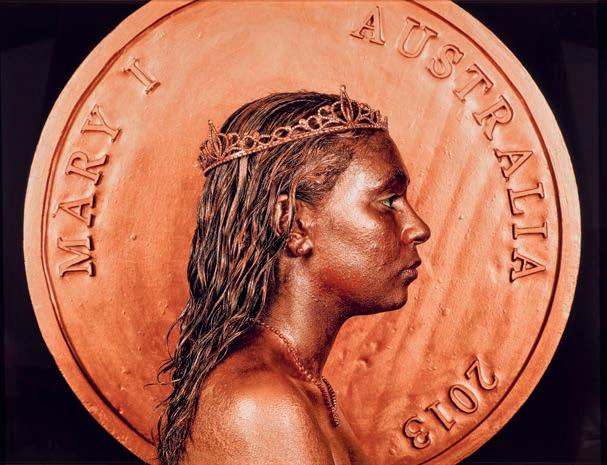
81
EMILY KAM KNGWARREYE
(c.1910 – 1996)
ALAGURA LANDSCAPE I, 1994
synthetic polymer paint on linen 90.0 x 150.0 cm
bears inscription verso: artist’s name and Delmore Gallery cat. 94A042
ESTIMATE: $50,000 – 70,000
PROVENANCE
Commissioned by Delmore Gallery, via Alice Springs, Northern Territory
The Holt Collection, Alice Springs, Northern Territory
Private collection, Sydney acquired from the above
LITERATURE
Isaacs, J., Smith, T., Ryan, J., Holt, D., and Holt, J., Emily Kngwarreye Paintings , Craftsman House, Sydney, 1998, pl. 43, pp. 112 – 113 (illus.), 197
82 IMPORTANT AUSTRALIAN INDIGENOUS ART
35

83
KITTY KANTILLA (KUTUWULUMI PURAWARRUMPATU) (c.1928 – 2003)
UNTITLED, 2000
natural earth pigments and synthetic binder on canvas 100.5 x 81.0 cm
bears inscription and stamp verso: artist’s name and Jilamara Arts cat. 140-00
ESTIMATE: $20,000 – 30,000
PROVENANCE
Jilamara Arts, Melville Island, Northern Territory (stamped verso)
Aboriginal and Pacific Art, Sydney Private collection, Sydney
EXHIBITED
Kitty Kantilla ; New Works on Paper and Canvas , Aboriginal and Pacific Art, Sydney, 7 – 23 December 2000
Meridian: Focus on Contemporary Australian Art, Museum of Contemporary Art, Sydney, 28 February 2002 – 23 February 2003
Kitty Kantilla, National Gallery of Victoria, Melbourne, 27 April – 19 August 2007; Art Gallery of New South Wales, Sydney, 7 December 2007 – 21 January 2008, cat. 60 (label attached verso)
LITERATURE
Ryan, J., Kitty Kantilla, National Gallery of Victoria, Melbourne, 2007, p. 46 (illus.)
In response to her solo exhibition in December 2000 held at Aboriginal and Pacific Art in Sydney, art critic Sebastian Smee lauded the art of Kitty Kantilla as reminiscent of Italian still life painter Giorgio Morandi: ‘Her brilliant and original works vibrate with a moment-to-moment immediacy: nothing is allowed to settle into monotony… as well, she knows how leave things out... she lets the various elements breathe.’1
Reproduced on the invitation for the December 2000 Sydney exhibition and painted on a black ground, Untitled, 2000 encompasses all the elements of the artist’s lexicon. Pwanga (dots), marlipinyini (lines), and turtiyangimari (colours including white, red, yellow and black) all feature, however here the painting opens up with rhythmic movement –blocks of ochre dots separated by vertical lines are contained between wide horizontal bands of red and yellow ochre and smokey white clay. Although seemingly abstract in appearance, Kantilla’s mark making is far from arbitrary; rather her designs evoke cultural history and ritual, particularly the Pukumani ceremony, where the Tiwi gather to farewell the dead and performers in full body decoration participate in a cycle of song and dance.
In the catalogue to Kantilla’s National Gallery of Victoria retrospective in 2007, Judith Ryan describes Kantilla’s approach: ‘She is able to distil and pare back figurative elements so that her work, like an analytic cubist still life, reduces form to structure and partakes of the quality of inwardness. The balancing patterns of red, yellow and white ochre in counterpoise with constant rows of alternating ochre dots on black or white, results in work of overriding presence and great beauty, borne of restraint and imbued with adagio rhythm.’ 2
1. Smee, S., ‘The Poet of Small things’, Sydney Morning Herald, 22 December 2000 p. 22, cited in Ryan, J., Kitty Kantilla, National Gallery of Victoria, Melbourne, 2007 p. 81 2 Ryan, ibid., p. 82
84 IMPORTANT AUSTRALIAN INDIGENOUS ART
36
CRISPIN GUTTERIDGE

85
DEAF TOMMY MUNGATOPI
(1923 – 1985)
CORAL, c .1965
natural earth pigments on eucalyptus bark
62.0 x 38.5 cm (irregular)
ESTIMATE: $20,000 – 30,000
PROVENANCE
Painted at Bathurst or Melville Islands, Northern Territory Private collection
Sotheby's, Melbourne, 22 – 23 November 1999, lot 406 (attributed to 'Artist Unknown') The Kelton Collection, Santa Monica, USA Private collection, Melbourne
RELATED WORKS
Coral Design, c.1965, natural pigments on bark, 84.5 x 44.0 cm (irregular), in the collection of the Art Gallery of New South Wales, Sydney
Coral Reef, c.1967, natural earth pigments on eucalyptus bark, 71.0 x 50.0 cm, private collection, illus. in Isaacs, J., Tiwi: Art/History/Culture , The Miegunyah Press, Melbourne University Publishing, Carlton 2012, p. 17 Coral, c.1972, earth pigment on bark, 80.0 x 30.0 cm, in the collection of Thomas Vroom, illus. in Isaacs, J., Tiwi: Art/History/Culture , The Miegunyah Press, University Publishing, Carlton, 2012, p. 142
Often commissioned to make Pukumani Poles for funeral ceremonies, Deaf Tommy Mungatopi was renowned for his fine attention to detail and inventive patterning. His signature style consists of a double set of webbed, slightly ovoid concentric circles, connected and infilled by delicately painted patterns of dots applied with the pwoja comb.1 As with the related works cited above, this painting on bark is an evocative interpretation of light reflecting off the coral reefs on the eastern side of Melville Island – a subject to which he returned many times.
1. Isaacs, J., Tiwi, Art / History / Culture, 2012, The Miegunyah Press, Melbourne University Publishing, Carlton, p. 142
CRISPIN GUTTERIDGE
86 IMPORTANT AUSTRALIAN INDIGENOUS ART
37

87
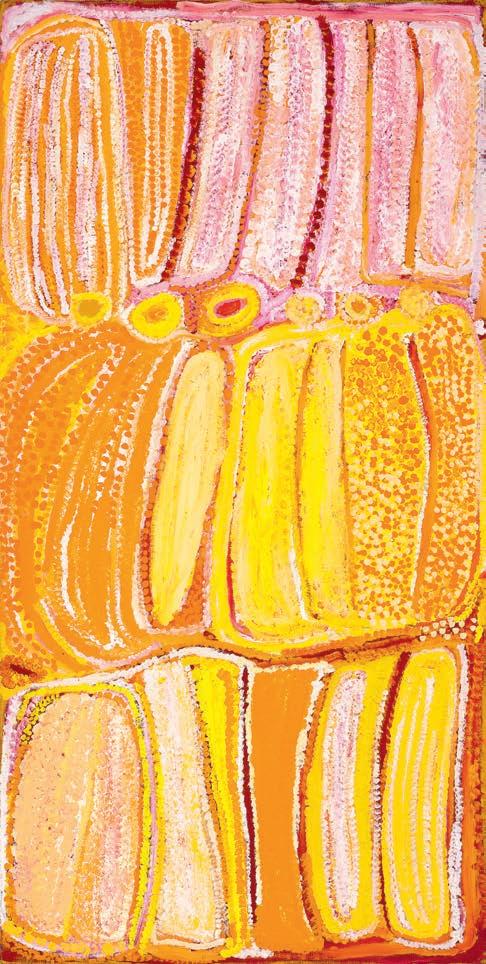
ESTIMATE: $10,000 – 15,000
38
PROVENANCE
Warlayirti Artists, Balgo Hills, Western Australia
Alcaston Gallery, Melbourne
Private collection, Sydney
Lawson-Menzies, Sydney, 30 May 2006, lot 52
Private collection, Melbourne
EXHIBITED
Eubena Nampitjin, Alcaston Gallery, Melbourne, 31 May – 21 June 2002 (illus. in exhibition catalogue p. 16)
88 IMPORTANT AUSTRALIAN INDIGENOUS ART
EUBENA NAMPITJIN (c.1921 – 2013)
MINDIKI KARU, 2002 synthetic polymer paint on linen 150.0 x 75.0 cm
bears inscription verso: artist’s name, size, Warlayirti Artists cat. 131/02 and Alcaston Gallery cat. AK7701
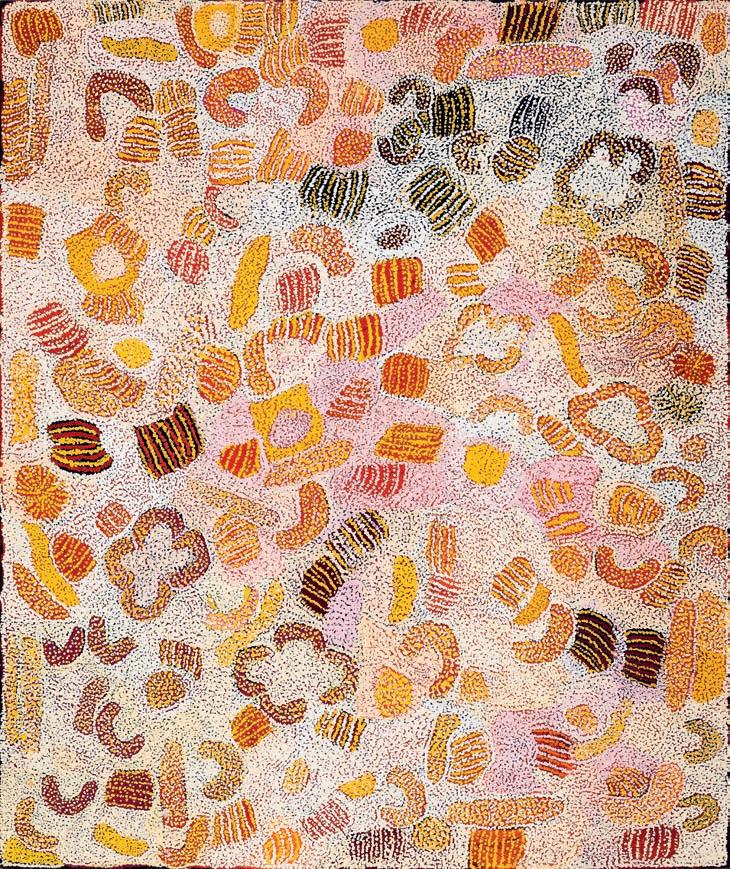
ELIZABETH NYUMI NUNGURRAYI (1947 – 2019)
PARWALLA, 2003 synthetic polymer paint on linen 180.5 x 150.5 cm bears inscription verso: artist’s name, size and Warlayirti artist’s cat. 1009/03
ESTIMATE: $12,000 – 18,000
PROVENANCE
Warlayirti Artists, Balgo Hills, Western Australia
GrantPirrie, Sydney
Private collection, Sydney
EXHIBITED
Balgo a Go Go, GrantPirrie, Sydney, June 2004
This work is accompanied by a copy of the certificate of authenticity from Warlayirti Artists which states in part:
'This painting depicts the country known as Parwalla which is Nyumi's father's country. This country is south of Balgo in the Great Sandy Desert, west Kiwirrkurra. The landscape of the area is dominated by tali, or sand dunes. The Parwalla area is a swampy area, filling a huge area with water after the wet season rain. The majority of the painting shows the different bush foods, including kantjili, or bush raisin, and minyili.
89
39
FREDDY WEST TJAKAMARRA (1935 – 1994)
TINGARRI AT KAMPANGUTJANANYA, 1978
synthetic polymer paint on linen 171.5 x 100.5 cm
bears inscription verso: Papunya Tula Artists cat. FW781104
ESTIMATE: $25,000 – 35,000
PROVENANCE
Papunya Tula Artists, Alice Springs, Northern Territory Aboriginal Arts Board, Australia Council, Sydney
The Kelton Collection, USA, acquired from the above Private collection, Switzerland Private collection, Melbourne
EXHIBITED
Past and Present Art of the Australian Aborigines, from The Kelton Foundation Collection, Pacific Asia Museum, Pasadena, California, 24 September 1980 – 4 January 1981
Dreamtime: Art of the Australian Aborigine, Pt. 1 Land and Tradition, California State University, Northridge, California, 12 September – 14 October 1988
Abstract Reality: Australian Dreamtime Art, Modern Museum of Art, Santa Ana, California, 17 January – 16 April 1989
The Evolving Dreamtime: Contemporary Art by Indigenous Australians – Part I, Pacific Asia Museum, Pasadena, California, 3 August 1994 – 22 January 1995
This painting is accompanied by a copy of the certificate of authenticity from Papunya Tula Artists which states:
'The Mythological travels of a group of Tingari Men to the lake site Kampangutjanganynga far, far to the west of Alice Springs are celebrated in this depiction. The Tingari is a mytho-ritual complex or series of traditions of deep religious significance. They are widely distributed through the Western Desert and are basically secret-sacred. For this reason, details relating to Tingari myths, songs and rituals may not be publicly revealed. In this particular episode, the Tingari had come from the north east and had camped at Kampangutjanganya in order to hold ceremonies of instruction for the post initiate novices or Maliki with whom they were travelling. Here they met a lone old man. While camped at this site they prepared seed cakes for the Maliki. These seed cakes were prepared from the ground flour of the wild grasses of the area. A bushfire suddenly emerged and the Tingari Men were forced to cut short their stay and flee to the south west. All the sets of concentric circles indicate specific sites in the vicinity of Kampangutjanganya, such as the place where the Tingari met the old man, the camps where the Maliki were held during their instruction and the place where the seed cake was made. The interconnecting sinuous lines indicate the paths of the Tingari between these various sites. The areas enclosed by the main configuration (with the exception of one) indicates the water on the lakes surface. The area (marked on the diagram) represents the stone on which the seeds were ground into flour for the damper. The black dots that surround the composition indicate Tjiparinypa, the grass from which the seeds were collected.'
90 IMPORTANT AUSTRALIAN INDIGENOUS ART
40

91
RONNIE TJAMPITJINPA (c.1943 – 2023)
WALUNGURRU, 2011
synthetic polymer paint on linen 121.0 x 90.5 cm
bears inscription verso: artist’s name, size and Papunya Tula Artists cat. RT1108008
ESTIMATE: $15,000 – 20,000
PROVENANCE
Painted at Kintore, Northern Territory, in 2011
Papunya Tula Artists, Alice Springs, Northern Territory
Harvey Art Projects, Ketchum, Idaho, USA
The Luczo Family Collection, USA
Deutscher and Hackett, Melbourne, 19 October 2016, lot 43
Private collection, Victoria
EXHIBITED
Papunya Tula Artists 40 Years: Celebrating 40 Years of the Western Desert Art Movement, Harvey Art Projects, Ketchum, Idaho, USA, 14 February – 20 April 2012, cat. 2
This painting is accompanied by a certificate of authenticity from Papunya Tula Artists that states:
‘This painting depicts body paint designs associated with the site of Walungurru or Kintore. In ancestral times a ngintaka (perentie) came to this site from the west. Two women tracked the ngintaka to Kintore and eventually found it. When the ngintaka died, it turned to stone and became the mountain, a very prominent landmark next to the Kintore community. This site is associated with the Tingari song cycle.’
92 IMPORTANT AUSTRALIAN INDIGENOUS ART
41
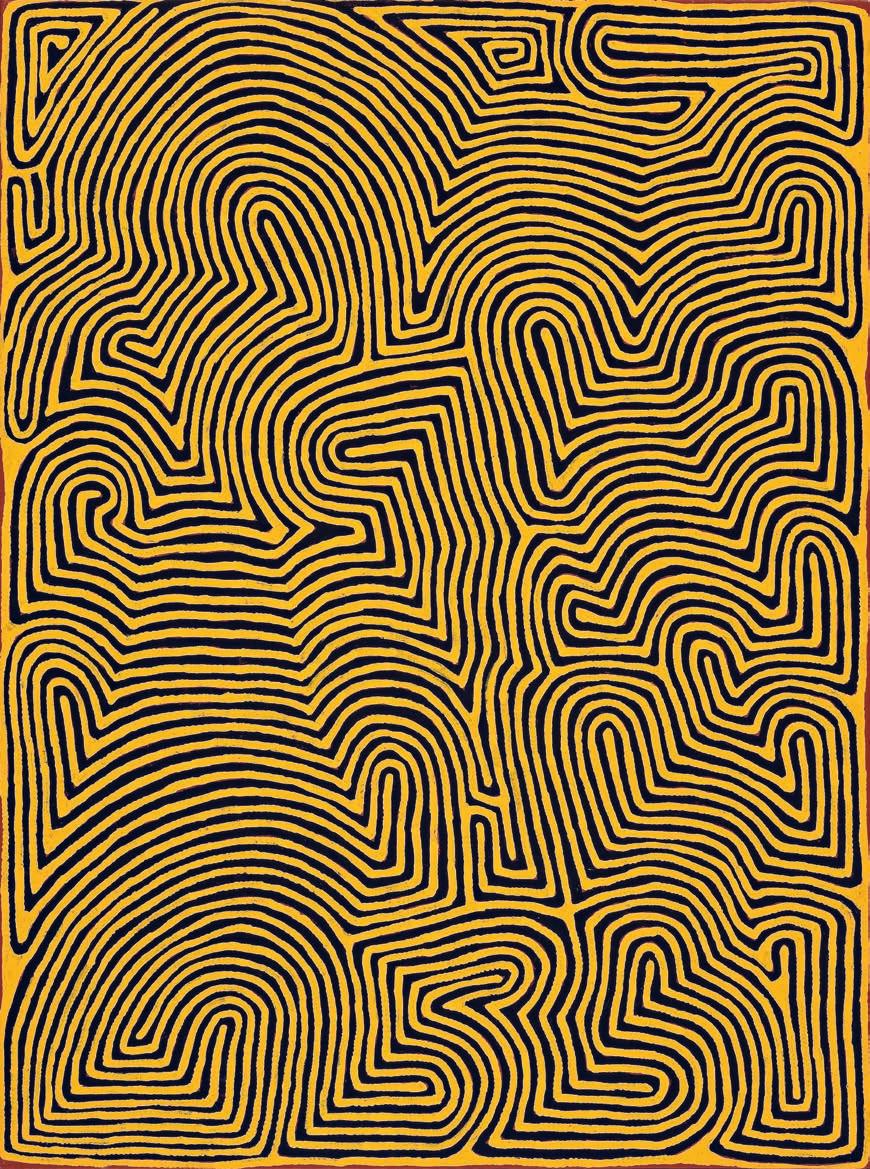
93

PADDY NYUNKUNY BEDFORD
(c.1922 – 2007)
UNTITLED, 2004
gouache on crescent board
50.5 x 76.0 cm
bears inscription verso:
Jirrawun Aboriginal Arts cat. PB WB 3 2004.198
ESTIMATE: $8,000 – 12,000
42
PROVENANCE
Jirrawun Arts, Kununurra, Western Australia
The Estate of Paddy Bedford
William Mora Galleries, Melbourne
Private collection, Melbourne
Deutscher and Hackett, Melbourne, 18 May 2011, lot 41
Private collection, Melbourne
LITERATURE
Storer, R., Paddy Bedford, Museum of Contemporary Art, Sydney, 2006, p. 177 (illus.)
94 IMPORTANT AUSTRALIAN INDIGENOUS ART

PADDY NYUNKUNY BEDFORD
(c.1922 – 2007)
UNTITLED, 2004
gouache on crescent board
50.5 x 76.0 cm
bears inscription verso: Jirrawun Aboriginal Arts cat. PB WB 3 2004.181
ESTIMATE: $10,000 – 15,000
43
PROVENANCE
Jirrawun Arts, Kununurra, Western Australia
The Estate of Paddy Bedford
William Mora Galleries, Melbourne
Private collection, Melbourne
Deutscher and Hackett, Melbourne, 18 May 2011, lot 42
Private collection, Melbourne
LITERATURE
Storer, R., Paddy Bedford, Museum of Contemporary Art, Sydney, 2006, p. 176 (illus.)
95

FREDDIE TIMMS
(c.1946 – 2017)
UNTITLED, 2008
natural earth pigments with synthetic binder on linen 130.0 x 130.0 cm
bears inscription verso: artist’s name, Jirrawun Arts cat. FT2008–07–316 and cat. JA153/08
ESTIMATE: $10,000 – 15,000
44
PROVENANCE
Jirrawun Arts, Wyndham, Western Australia
The Estate of Freddie Timms
96 IMPORTANT AUSTRALIAN INDIGENOUS ART

BILLY THOMAS JOONGOORRA
(c.1920 – 2012)
WATERHOLES AND SANDHILLS
IN THE GREAT SANDY DESERT, 2002 natural earth pigments and synthetic binder on canvas 100.0 x 80.0 cm bears inscription verso: artist’s name, date, size and Red Rock Art cat. KP1661
ESTIMATE: $7,000 – 9,000
PROVENANCE
Red Rock Art, Kununurra, Western Australia Aboriginal and Pacific Art, Sydney Private collection, Sydney
45 This work is accompanied by a copy of a certificate of authenticity from Red Rock Art which states:
‘Throughout the artist country in the Great Sandy Desert, waterholes (soaks and rockholes) exist. Knowledge of these places was crucial to the artist’s ability to lead a traditional lifestyle. It was at these places that most ceremony and law was undertaken. This painting shows a typical waterhole (soak) amongst the rolling sand dunes (large curved shapes) of the desert. All of this sandhill country was made in the dreamtime by Gunambalayi– the Black Snake.’
97
ROVER THOMAS (JOOLAMA) (c.1926 – 1998)
TEXAS DOWNS COUNTRY – GOWARRI, 1989
natural earth pigments and bush gum on canvas 60.0 x 105.0 cm
bears inscription verso: 1989 and cat. ABOP397
ESTIMATE: $35,000 – 45,000
PROVENANCE
Painted for Mary Macha in 1989 (code 29889)
Private collection
Lawsons, Sydney, 13 September 1994, lot 107 (as ‘Gowarri’)
The Kelton Collection, Santa Monica, USA
The Kelton Collection, Abell Auctions, Los Angeles, USA, 22 June 2023, lot 315 (as ‘Gowarri Dreaming’)
Private collection, Perth
This work is accompanied by a copy of the original cataloguing note from Mary Macha.

98 IMPORTANT AUSTRALIAN INDIGENOUS ART
46

99

BOXER MILNER TJAMPITJIN (c.1934 – 2009)
PURKITJI, 2006 synthetic polymer paint on canvas 90.0 x 60.0 cm bears inscription verso: artist’s name, size and Warlayirti Artists cat. 652/06
ESTIMATE: $3,000 – 4,000
47
PROVENANCE
Warlayirti Artists, Balgo Hills, Western Australia
Aboriginal and Pacific Art, Sydney
Private collection, Sydney
This work is accompanied by a copy of a certificate of authenticity from Warlayirti Artists which states:
‘Boxer has painted some of his country, found along the middle stretches of Purkitji (Sturt Creek) north of Balgo. Boxer knows all facets of this country and the seasonal changes that occur to the river each year. Purkitji and its many inter–connecting smaller tributories are depicted as well as the surrounding country.’
100 IMPORTANT AUSTRALIAN INDIGENOUS ART

WAKARTU CORY SURPRISE (c.1929 – 2011)
UNTITLED, 2010
synthetic polymer paint on canvas 117.0 x 117.0
bears inscription verso: artist’s name, size and Mangkaja Arts cat. 549/10
ESTIMATE: $8,000 – 12,000
48
PROVENANCE
Mangkaja Arts, Fitzroy Crossing, Western Australia
Private collection, Sydney
This work is accompanied by a certificate of authenticity from Mangkaja Arts, Fitzroy Crossing.
101

HELICOPTER TJUNGURRAYI
born c.1946
UNTITLED, 2004
synthetic polymer paint on linen 180.0 x 100.0 cm
bears inscription verso: artist’s name, size, Warlayirti Artists cat. 98/04 and Alcaston Gallery cat. AK11958
ESTIMATE: $4,000 – 6,000
49
PROVENANCE
Warlayirti Artists, Balgo Hills, Western Australia
Alcaston Gallery, Melbourne
Private collection, Melbourne
102 IMPORTANT AUSTRALIAN INDIGENOUS ART
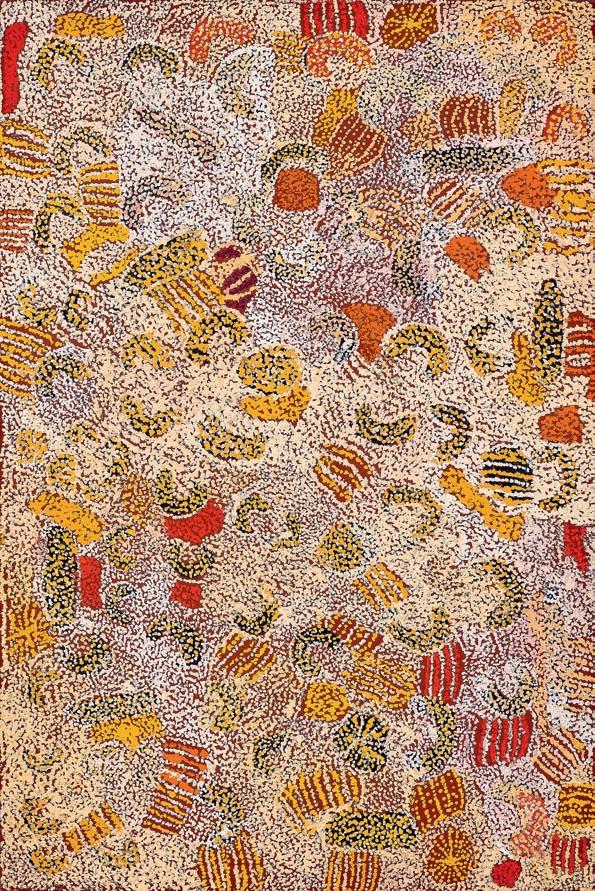
ELIZABETH NYUMI NUNGURRAYI
(1947 – 2019)
PARWALLA, 2004
synthetic polymer paint on linen 150.5 x 100.5 cm
bears inscription verso: artist’s name, size and Warlayirti Artists cat. 823/04
ESTIMATE: $12,000 – 15,000
PROVENANCE
Warlayirti Artists, Balgo Hills, Western Australia
Private collection, Melbourne
Sotheby’s, Melbourne, 24 July 2007, lot 173
Private collection, Melbourne
This work is accompanied by a certificate of authenticity from Warlayirti Artists which states:
‘This painting depicts the country known as Parwalla, which is Nyumi’s father’s country. This country is far to the south of Balgo in the Great Sandy Desert, west of Kiwirrkurra, and is dominated by tali (sand hills). Parwalla is a large swampy area, which fills with water after the wet season rain and consequently produces an abundance of bush foods. The majority of Nyumi’s painting shows the different bush foods, including kantjilyi (bush raisin), pura (bush tomato) and minyili (seed). Women, shown as the U shapes, with their wana (digging sticks) and coolamons gathering the foods are also depicted. The whitish colours, which dominate the painting, represent the spinifex that grows strong and seeds after the wet season rains. These seeds are white in colour, and grow so thickly they obscure the ground and other plants below.’
103
50
MAKINTI NAPANANGKA (c.1930 – 2011)
KUNGKA KUTJURRA, 2001
synthetic polymer paint on Belgian linen 107.0 x 91.0 cm
bears inscription verso: artist’s name, size and Papunya Tula Artists cat. MN0104123
ESTIMATE: $14,000 – 18,000
PROVENANCE
Papunya Tula Artists, Alice Springs, Northern Territory Ochre Gallery, Melbourne
Private collection, Melbourne, acquired from the above
This work is accompanied by a certificate of authenticity from Papunya Tula Artists which states:
'This painting depicts designs associated with the travels of the Kungka Kutjarra (Two Women) to a site on the south side of Lake MacDonald. The two women were digging for the small animal Kunungka (Western Quoll). These animals usually live in burrows which were dug by other animals such as the Burrowing Bettong or Rabbits and occasionally in hollow logs. The women later continued their travels to the east.’
104 IMPORTANT AUSTRALIAN INDIGENOUS ART
51

105

LORNA NAPANANGKA
born 1961
UNTITLED, 2004
synthetic polymer paint on linen 153.0 x 122.0 cm
bears inscription verso: artist’s name, size and Papunya Tula Artists cat. LN0404179
ESTIMATE: $8,000 – 12,000
52
PROVENANCE
Papunya Tula Artists, Alice Springs, Northern Territory
Gallery Gabrielle Pizzi, Melbourne (label attached verso)
Private collection, Melbourne
106 IMPORTANT AUSTRALIAN INDIGENOUS ART

ELIZABETH MARKS NAKAMARRA
born 1959
UNTITLED, 2002 synthetic polymer paint on linen 122.0 x 122.0 cm bears incription verso: artist’s name, size and Papunya Tula Artists cat. EM0209082
ESTIMATE: $5,000 – 7,000
53
PROVENANCE
Papunya Tula Artists, Alice Springs, Northern Territory Palya Art, Darwin, Northern Territory (cat. C–0684) Collection of James Smeaton, Melbourne, acquired from the above in 2002
This work is accompanied by a certificate of authenticity from Papunya Tula Artists which states:
‘In this painting the artist has painted designs associated with the rockhole site of Kalipinpa, a major water dreaming place, north of Sandy Blight Junction. The lines are the rocky outcrops and sandhills in the vicinity of the site. A group of women gathered at the rockhole to perform the dances and sing the songs associated with the area.’
107

born 1944
ESTIMATE: $5,000 – 7,000
54
PROVENANCE
Aboriginal and Pacific Art, Sydney
Private collection, Sydney, acquired from the above
EXHIBITED
Riverland: Yvonne Koolmatrie, Art Gallery of South Australia, Adelaide, 8 October 2015 – 10 January 2016, as part of the TARNANTHI festival
LITERATURE
Riverland: Yvonne Koolmatrie, Art Gallery of South Australia, Adelaide, 2015, p. 103 (illus.)
108 IMPORTANT AUSTRALIAN INDIGENOUS ART
YVONNE KOOLMATRIE
YABBIE TRAP, 2008 woven sedge rushes 50.0 x 55.0 x 72.0 cm
OWEN YALANDJA
born 1960
YAWK YAWK, 2008
ochre and pigments with PVA fixative on carved kurrajong 210.0 cm height
ESTIMATE: $5,000 – 7,000
PROVENANCE
Maningrida Arts and Culture, Maningrida, Northern Territory (cat. 4231–08)
Private collection, Sydney
This work is accompanied by a certificate of authenticity from Maningrida Arts and Culture which states in part:
'The female water spirits Yawkyawk or Ngalkunburriyaymi are perhaps the most enigmatic of mythological themes. Sometimes compared to the European notion of mermaids, they exist as spiritual beings living in freshwater streams and rock pools, particularly those in the stone country. The spirit Yawkyawk is usually described and depicted with the tail of a fish. Thus the Kuninjku people sometimes call them ngalberddjenj which literally means 'the young woman who has a tail like a fish'. They have long hair, which is associated with trailing blooms of green algae (called man-bak in Kinunjku). At times they leave their aquatic homes to walk about on dry land, particularly at night.'

55 109

56 YIRAWALA
(c.1895 – 1976)
EMU, c .1968
natural earth pigments on eucalyptus bark 32.0 x 73.0 cm (irregular) bears inscription verso: artist's name, title, location and language group bears inscription verso: FROM / BILL DONLLY / TO / KEN / ... OF / BUINDIARA
ESTIMATE: $6,000 – 8,000
PROVENANCE
Executed at Minjilang, Croker Island, Western Arnhem Land
Private collection, Northern Territory
Raffan Kelaher & Thomas, Sydney, 21 June 2010, lot 39
Private collection, Sydney
110 IMPORTANT AUSTRALIAN INDIGENOUS ART
57
JOHN MAWURNDJUL
born 1952
MARDAYIN AT KAKODBEBULDI, 2002
natural earth pigments on stringybark (Eucalyptus tetradonta)
99.0 x 55.0 cm (irregular) bears inscription on label verso: artist’s name, medium, size, language group and Maningrida Arts and Culture cat. 6349-02
ESTIMATE: $14,000 – 18,000
PROVENANCE
Maningrida Arts and Culture, Maningrida, Northern Territory
Short Street Gallery, Broome
Private collection, Melbourne
This work is accompanied by certificates of authenticity from Short St Gallery, and Maningrida Arts and Culture which states:
‘This work by the artist concerns a major patrimoiety ceremony of a secret and sacred nature called ‘Mardayin’. Much of the meaning of the iconography in the painting is not in the domain of public knowledge and so it cannot be explained in detail here. The painting refers to a site, Kakodbebuldi, which is an outstation in Dangkorlo clan estate in the Mann River region. Kakodbebuldi is a Mardayin ceremony performance site and is located on a large billabong covered in waterlilies. This place is about 50km south of Maningrida in Central North Arnhem Land.’

111

NAMERREDJE GUYMALA (1926 – 1978)
NGALYOD AND FEMALE SPIRIT NGALKUNBURRIYA, c.1972
natural earth pigments on eucalyptus bark 84.0 x 56.0 cm (irregular) bears inscription verso: cat. E.78
ESTIMATE: $6,000 – 9,000
PROVENANCE
Painted in Western Arnhem Land, Northern Territory
Rothmans of Pall Mall, Canada
The McIntosh Gallery, Ontario, Canada (cat. 1978.0016)
Sotheby’s, Sydney, 29 July 2003, lot 248 (as ‘The Rainbow Serpent and Female Spirit Ngalkunburriya’)
The Peter and Renate Nahum Collection of Aboriginal Art, London
Deutscher and Hackett, Melbourne, 15 July 2020, lot 82 Private collection, New South Wales
The estate of Alan Cardy, New South Wales
58
EXHIBITED
Art of Aboriginal Australia, Rothmans Art Gallery of Stratford, Ontario, June – September 1974; The Glenbow–Alberta Institute, Alberta, September – October 1974; The Mendel Art Gallery, Saskatchewan, November – December 1974; The Vancouver Centennial Museum, British Columbia, December 1974 – January 1975; The Edmonton Art Gallery, January – February 1975; The Art Gallery of Hamilton, Ontario, March 1975; Musée du Quebec, April – May 1975; Musée d’Art Contemporain, Montreal; Dalousie University Art Gallery, Nova Scotia, June – July 1975; Memorial University Art Gallery, Newfoundland, August 1975; Confederation Art Gallery and Museum, Prince Edward Island, September – October 1975; Agnes Etherington Art Gallery, Ontario, October – November 1975; The Royal Ontario Museum, Ontario, April – May 1976, cat. 78
LITERATURE
Edwards, R., Art of Aboriginal Australia presented by Rothmans of Pall Mall, Rothmans of Pall Mall Canada Ltd., Canada, 1974, cat. 78, p. 51 (illus.)
112 IMPORTANT AUSTRALIAN INDIGENOUS ART
NARRITJIN MAYMURU (1922 – 1981)
GUWAK, MARNGU AND BIYAY AT DJARRAKPI, c.1960 natural earth pigments on eucalyptus bark 40.0 x 9.0 cm (irregular)
ESTIMATE: $3,000 – 4,000
PROVENANCE
Collected in 1961
James A. Davidson, Melbourne
Private collection, Melbourne
Deutscher and Hackett, Melbourne, 14 October 2009, lot 30
Private collection, New South Wales
RELATED WORK
Djert (The Sea Eagle), c.1960, natural earth pigments on eucalyptus bark, 90.0 x 47.0 cm, sold by Sotheby’s, Melbourne, 28 June 1999, lot 46
This painting depicts totemic animals associated with the site of Djarrakpi in Manggalili country on Cape Shield. The central figure with leaves is a kanyawu native cashew tree with a guwak (Koel) at the top. You can see a marngu possum climbing up the tree to the right and a garanyirryirr cicada and at the bottom biyay goannas. The snake is a Yirritja moiety snake that swims along the coast off Djarrakpi

113
59

JAN BILLYCAN (DJAN NAMUNDIE)
(c.1930 – 2015)
UNTITLED, 2005
synthetic polymer paint on canvas 70.0 x 55.0 cm bears inscription verso: artist’s name, date, medium, size and Short Street Gallery cat. 3322
ESTIMATE: $4,000 – 6,000
60
PROVENANCE
Short Street Gallery, Broome, Western Australia Collection of James Smeaton, Melbourne, acquired from the above in 2005
114 IMPORTANT AUSTRALIAN INDIGENOUS ART

born 1934
MITUNA, 2021
synthetic polymer paint on canvas 76.0 x 62.0 cm
bears inscription verso: artist’s name, date and Spinifex Arts Project cat. 21–104
ESTIMATE: $3,000 – 4,000
61
PROVENANCE
Spinifex Arts Project, Tjuntjuntjara, Western Australia
RAFT Artspace, Alice Springs, Northern Territory
Private collection, New South Wales
EXHIBITED
Tjilpi Kutjara, Simon Hogan and Lawrence Pennington, RAFT Artspace, Alice Springs, 11 – 25 September 2021
This work is accompanied by a certificate of authenticity from Spinifex Arts Project.
115
LAWRENCE PENNINGTON
BILLY STOCKMAN TJAPALTJARRI (c.1927 – 2015)
YAM DREAMING, 1971 poster paint with PVA Bondcrete glue on fruit box end 28.5 x 28.0 cm
ESTIMATE: $10,000 – 15,000
PROVENANCE
Geoffrey Bardon, Sydney
Aboriginal and Pacific Art, Sydney
Private collection, Sydney, acquired from the above in 2001 D’Lan Contemporary, Melbourne (label attached verso) Private collection, Melbourne
EXHIBITED
On long term loan from Geoffrey Bardon to the National Gallery of Victoria, Melbourne, 1994 (label attached verso), and the National Gallery of Australia, Canberra, 1995 – 2000
LITERATURE
Bardon, G., and Bardon, J., Papunya: A Place Made After the Story – The Beginnings of the Western Desert Painting Movement, The Miegunyah Press, Melbourne, 2004, p. 312 (illus.)
This work is accompanied by a hand drawn diagram of the work identifying notations and a statement from Geoffrey Bardon:
‘This work was completed on a fruit box end during the first several months of my involvement at Papunya. Bill later was most helpful when asked not to paint anything secret. This small design in May 1971 followed what I had asked of him. The design here is a variant of the popular Yam Dreaming. The concentric circles are yam plants, the ovals are the actual yams and the very small circles are the yam seeds. The curved shapes are boomerangs and the spiralling line is running water.
I was always moved by the transition from terrible squalor to majestic beauty, as happened with paintings such as this.’
116 IMPORTANT AUSTRALIAN INDIGENOUS ART
62

117
63
RONNIE TJAMPITJINPA
(c.1943 – 2023)
TJANPANLAKANYA ROCKHOLE, 1995
synthetic polymer paint on linen 137.0 x 60.0 cm
bears inscription verso: artist’s name, size and Papunya Tula Artists cat. RT950164
ESTIMATE: $5,000 – 7,000
PROVENANCE
Painted at Kintore, Northern Territory, in 1995
Papunya Tula Artists, Alice Springs, Northern Territory
Private collection
Sotheby’s, Melbourne, 20 July 2009, lot 149
Private collection, Melbourne
This work is accompanied by a certificate of authenticity from Papunya Tula Artists which states:
'This painting depicts the mythology of a small grey bird at the rockhole site of Tjanpanlakanya south of Lake Mackay. The ceremonies associated with this mythology form part of the secret Tingari Cycle therefore no further detail was given.
Generally, the Tingari are a group of mythical characters of the Dreaming who travelled over vast stretches of the country, performing rituals and creating and shaping particular sites. The Tingari Men were usually followed by Tingari Women and accompanied by novices and their travels and adventures are enshrined in a number of song cycles. These mythologies form part of the teachings of the post initiatory youths today as well as providing explanations for contemporary customs.’

118 IMPORTANT AUSTRALIAN INDIGENOUS ART

BRANDY TJUNGURRAYI
(1927 – 2012)
UNTITLED, 1998
synthetic polymer paint on linen 122.0 x 91.5 cm
bears inscription verso: artist’s name, size and Papunya Tula Artists cat. BT9810106
ESTIMATE: $5,000 – 7,000
64
PROVENANCE
Papunya Tula Artists, Alice Springs, Northern Territory Collection of James Smeaton, Melbourne, purchased from the above in 2000
119

KAAPA TJAMPITJINPA (c.1926 – 1989)
WATER DREAMING AT MIKANTJI, 1983 synthetic polymer paint on linen 100.5 x 61.0 cm bears inscription verso: Papunya Tula Artists cat. K830403
ESTIMATE: $8,000 – 12,000
PROVENANCE
Papunya Tula Artists, Alice Springs, Northern Territory Gallery Gabrielle Pizzi, Melbourne Private collection, Victoria
65
This work is accompanied by a certificate of authenticity from Papunya Tula Artists which states:
‘This painting depicts a ground design for the celebration of the Water Dreaming at a site called Mikantji, west of Yuendumu Settlement. The mythological Rain Dreaming trails can be traced over hundreds of kilometres. It is “marked” by a series of rockholes, claypans and soakage waters, and each site is considered to have come into being at the time of the ancestral creative storms. The arcs represent boomerangs and the straight bars are ceremonial body scars.’
120 IMPORTANT AUSTRALIAN INDIGENOUS ART
WILLY TJUNGURRAYI
born c.1930
TALI, 2001
synthetic polymer paint on linen 168.0 x 45.5 cm
bears inscription verso: artist’s name, size, Papunya Artists cat. WT0102072 and Palya Art cat. C–0307
ESTIMATE: $5,000 – 7,000
PROVENANCE
Papunya Tula Artists, Alice Springs, Northern Territory
Palya Art, Darwin, Northern Territory Collection of James Smeaton, Melbourne, acquired from the above in 2001
This work is accompanied by a certificate of authenticity from Papunya Tula Artists which states:
‘This painting represents events at the site of Nginkulkulngya, a soakage water site on the western side of Lake MacDonald. In mythological times a fight broke out between an eagle and a group of Tingari men. The eagle was hit by a spear and crashed to the ground creating the soakage.
Since events associated with the Tingari Cycle are of a secret nature no further detail was given.
Generally, the Tingari are a group of mythical characters of the Dreaming who travelled over vast stretches of the country, performing rituals and creating and shaping particular sites. The Tingari Men were usually followed by Tingari Women and accompanied by novices and their travels and adventures are enshrined in a number of song cycles. These mythologies form part of the teachings of the post initiatory youths today as well as providing explanations for contemporary customs.’

121
66
prospective buyers and sellers guide
ALL PARTIES ARE STRONGLY URGED TO READ THE CONDITIONS OF AUCTION AND SALE INCLUDED IN THIS CATALOGUE
1. PRIOR TO AUCTION
CATALOGUE SUBSCRIPTIONS
Catalogues can be obtained at Deutscher and Hackett offices or by subscription (see the Catalogue Subscription Form at the back of this catalogue or online for more information).
PRE-SALE ESTIMATES
The price range estimated against each lot reflects the opinion of our art specialists as to the hammer price expected for the lot at auction and is informed by realised prices for comparable works as well as the particularities of each lot including condition, quality, provenance and rarity. While presale estimates are intended as a guide for prospective buyers, lots can be sold outside of these ranges. Pre-sale estimates include GST (if any) on a lot but do not include the buyer’s premium or other charges where applicable.
RESERVES
The reserve is the minimum price including GST (if any) that the vendor will accept for a lot and below which the lot will not normally be sold.
PRE-AUCTION VIEWINGS
In both Sydney and Melbourne pre-auction viewings are scheduled for several days in advance of each auction. Deutscher and Hackett specialists are available to give obligation free advice at viewings or by appointment and prospective buyers are strongly encouraged to thoroughly examine and request condition reports for potential purchases. Pre-auction viewings are open to the public and are free to attend.
SYMBOL KEY
▲ Unless ownership is clearly stated in the provenance, this symbol is used where a lot is offered which Deutscher and Hackett owns in whole or in part. In these instances, Deutscher and Hackett has a direct financial interest in the property or means that Deutscher and Hackett has guaranteed a minimum price.
● Used to indicate lots for sale without a reserve.
EXPLANATION OF CATALOGUING PRACTICE AND TERMS
All information published in Deutscher and Hackett catalogues represent statements of opinion and should not be relied upon as fact. All dimensions are listed in centimetres, height before width and are approximate. All prices are in Australian dollars.
ARTIST’S NAMES
All reference to artists make use of common and not full names in accordance with the standards outlined in the National Gallery of Australia reference publication Australian Art: Artist’s working names authority list. For instance, John Brack rather than Cecil John Brack; Roy de Maistre rather than Leroy Leveson Laurent De Maistre; Rosalie Gascoigne rather than Rosalie Norah Gascoigne.
Terms used in this catalogue have the meanings ascribed to them below:
a. NICHOLAS CHEVALIER: in the opinion of Deutscher and Hackett, a work by the artist.
b. Attributed to NICHOLAS CHEVALIER: in the opinion of Deutscher and Hackett, probably a work by the artist, in whole or in part.
c. Circle of NICHOLAS CHEVALIER: in the opinion of Deutscher and Hackett, a work showing the influence and style of the artist and of the artist’s period.
d. Studio/Workshop of NICHOLAS CHEVALIER: in the opinion of Deutscher and Hackett, a work possibly executed under the supervision of the artist.
e. School of NICHOLAS CHEVALIER: in the opinion of Deutscher and Hackett, a work by a follower or student of the artist.
f. Manner of NICHOLAS CHEVALIER: in the opinion of Deutscher and Hackett, a work created in the style, but not necessarily in the period, of the artist.
g. After NICHOLAS CHEVALIER: in the opinion of Deutscher and Hackett, a copy of a work by the artist.
h. “signed” / “dated” in the opinion of Deutscher and Hackett, the work has been signed/dated by the artist.
i. “bears signature” / “bears date” in the opinion of Deutscher and Hackett, the work has possibly been signed/dated by someone other than the artist.
122
PROVENANCE
Where appropriate, Deutscher and Hackett will include the known provenance, or history of ownership of lots. Non disclosure may indicate that prior owners are unknown or that the seller wishes to maintain confidentiality.
2. THE AUCTION
Auctions are open to the public and are free to attend. Deutscher and Hackett may exclude any person at any time in its discretion.
REGISTRATION
Bidders must register to bid prior to the commencement of an auction. Deutscher and Hackett may impose other obligations on the registration of bidders in its discretion.
CONDUCT OF AUCTION
Lots are offered for sale on a consecutive basis. Deutscher and Hackett will determine the conduct of the auction in its absolute discretion, including the regulation of bidding. Consecutive or responsive bids may be placed by the auctioneer on behalf of the vendor up to the reserve.
ABSENTEE OR COMMISSION BIDS AND TELEPHONE BIDS
As a courtesy service, Deutscher and Hackett will make reasonable efforts to place bids for prospective buyers in absentia provided written or verbal instructions (as indicated on absentee bid forms included at the back of this catalogue or online) are received 24 hours prior to auction. Where successful, lots will be purchased at the lowest possible bid and in the event of identical absentee bids, the bid received earliest will take precedence. Deutscher and Hackett accepts no responsibility for errors and omissions in relation to this courtesy service and reserves the right to record telephone bids.
RESERVE
Unless indicated otherwise, all lots are subject to a confidential reserve price determined by the vendor. Deutscher and Hackett or the auctioneer may place any number of bids on behalf of the vendor below the reserve price and is not obliged to identify that the bids are being placed on behalf of the vendor.
BIDDING INCREMENTS
Bidding usually opens below the listed pre-sale estimate and proceeds in the following increments (the auctioneer may vary the bidding increments at his or her discretion):
$500 – 1,000 by $50
$1,000 – 2,000 by $100
$2,000 – 3,000 by $200
$3,000 – 5,000 by $200 / $500 / $800
$5,000 – 10,000 by $500
$10,000 – 20,000 by $1,000
$20,000 – 30,000 by $2,000
$30,000 – 50,000 by $2,000 / $5,000 / $8,000
$50,000 – 100,000 by $5,000
$100,000 – 200,000 by $10,000
$200,000 – 300,000 by $20,000
$300,000 – 500,000 by $20,000 / $50,000 / $80,000
$500,000 – 1,000,000 by $50,000
$1,000,000+ by $100,000
SUCCESSFUL BIDS
The fall of the auctioneer’s hammer indicates the final bid and the buyer assumes full responsibility for the lot from this time.
UNSOLD LOTS
Where a lot is unsold, the auctioneer will announce that the lot is “bought in”, “passed”, “withdrawn” or “returned to owner”.
3. AFTER THE AUCTION PAYMENTS
Payment must be made within seven days of the date of sale in Australian dollars by cash, cheque, direct deposit, approved credit cards or electronic funds transfer. If payment is made by credit card the price will increase by any merchant fees payable by Deutscher and Hackett (1.15% (including GST) for Visa and Mastercard and 1.65% (including GST) for American Express). In certain circumstances, extension of payment may be granted at the discretion of Deutscher and Hackett. Cleared funds will be held in an interest bearing trust account by Deutscher and Hackett until remitted to the vendor. Deutscher and Hackett will be entitled to retain any interest earned during this period. Payment by the vendor of any charge to Deutscher and Hackett is to be made within fourteen days of invoice.
PURCHASE PRICE AND BUYER’S PREMIUM
The purchase price will be the sum of the final bid price (including any GST) plus a buyer’s premium set at 25% (inclusive of GST) of the final bid price. Buyers may be liable for other charges reasonably incurred once ownership has passed.
GOODS AND SERVICES TAX
Buyers are required to pay a 10% G.S.T which sum is:
a. included in the final bid prices where buying from a GST registered vendor; and
b. included in any additional fees charged by Deutscher and Hackett; and
c. included in the buyer’s premium.
Where GST applies to some lots the final bid price will be inclusive of the applicable GST. If a buyer is classified as a “non-resident” for the purpose of GST, the buyer may be able to recover GST paid on the final purchase price if certain conditions are met.
COLLECTION
Lots paid for in full may be collected from Deutscher and Hackett premises the day after the auction occurs but lots paid for by cheque may not be collected until all funds have cleared. Proof of identification is required upon collection and lots not collected within seven days of the sale may incur costs associated with external storage and freight.
LOSS OR DAMAGE
Risk in the lot, including risk of loss or damage, will pass to the buyer on either the date payment is due, whether or not it has been made, or on collection by the buyer, whichever is earlier. The buyer is therefore encouraged to make arrangements to ensure comprehensive cover is maintained from the payment due date.
TRANSPORT AND SHIPPING
Deutscher and Hackett directly offers services including storage, hanging and display, appraisals and valuations, collection management and research and in all instances will endeavour to coordinate or advise upon shipping and handling, insurance, transport, framing and conservation at the request and expense of the client. Deutscher and Hackett does not accept liability for the acts or omissions of contracted third parties.
EXPORT
Prospective bidders are advised to enquire about export licences — including endangered species licences and cultural heritage permits, where relevant — prior to bidding at auction. Telephone the Cultural Property and Gifts Section, Museums Section, Ministry for the Arts, on 1800 819 461 for further information. The delay or denial of such a licence will not be grounds for a rescission of sale.
COPYRIGHT
The copyright in the images and illustrations contained in this catalogue may be owned by third parties and used under licence by Deutscher and Hackett. As between Deutscher and Hackett and the buyer, Deutscher and Hackett retains all rights in the images and illustrations. Deutscher and Hackett retains copyright in the text contained in this catalogue. The buyer must not reproduce or otherwise use the images, illustrations or text without prior written consent.
123
conditions of auction and sale
ALL PARTIES ARE STRONGLY URGED TO READ THE CONDITIONS OF AUCTION AND SALE INCLUDED IN THIS CATALOGUE
The terms and conditions of business set forth below are subject to amendment by verbal or written notice prior to and during the auction and sale. They constitute the entire contractual agreement with the buyer in respect to any lot offered at auction. By bidding at auction in any manner compliant with bidding procedures, the buyer and all bidders agree to be bound by these terms and conditions and the terms of the prospective buyers and sellers guide contained in this catalogue, as amended. To the extent that an agent acts on behalf of the buyer, liability for obligations arising from these conditions of business will pass to the buyer. Multiple buyers are jointly and severally liable for obligations arising from this agreement.
DEFINITIONS
1. Definition of terms:
a. The ‘buyer’ refers to the party with the highest accepted bid for any lot at auction and/or such party’s principal where bidding as agent.
b. The ‘vendor’ refers to the party consigning property for sale and/or such party’s principal where acting as agent.
c. ‘Deutscher and Hackett’ refers to Deutscher and Hackett Pty Ltd ACN 123 119 022, its subsidiaries, officers, employees and agents.
d. The ‘hammer price’ refers to the final bid price (including any GST) accepted by the auctioneer, or in the case of a post-auction sale, the agreed sale price (including any GST).
e. The ‘buyer’s premium’ refers to the 25% (inclusive of GST) payable by the buyer calculated as a percentage of the hammer price.
f. ‘GST’ refers to the goods and services tax imposed by the A New Tax System (Goods and Services) Act 1999 as amended.
g. The ‘lot’ refers to the item(s) described against any lot number in h. the catalogue.
i. The ‘reserve’ refers to the minimum price (including any GST)
j. the consignor will accept for a lot.
PRELIMINARY CONDITIONS AND DISCLAIMER
2. Agency: Deutscher and Hackett acts as agent for the vendor and the contract
3. of sale for the lot will be between the buyer and the vendor.
4. Property is sold ‘as is’: To the extent permitted by law:
a. no guarantees, warranties or representations are made (express or implied) by Deutscher and Hackett or the vendor in relation to the nature and condition of any lot; and
b. Deutscher and Hackett disclaims liability for any misrepresentations, errors or omissions, whether verbal or in writing, in the catalogue or any supplemental material.
All factual information provided by the vendor is merely passed on by Deutscher and Hackett from the vendor or other source. Deutscher and Hackett has made no attempt to verify this information. All additional statements of opinion represent the specialist opinions of Deutscher and Hackett employees and should not be relied upon as statements of fact.
5. Responsibility to inspect: Responsibility remains with the buyer to satisfy its, his or her self by inspection and evaluation prior to purchase as to the nature and condition of any property.
CONDITIONS AT AUCTION
6. Registration: Bidders must register to bid and obtain a bidder’s paddle prior to the commencement of the auction. Registration requires that bidders provide proof of identity and Deutscher and Hackett may impose other obligations on the registration of bidders in its discretion.
7. Auctioneer’s discretion: Deutscher and Hackett reserves the right to absolute discretion over the conduct of the auction including the regulation of bidding and its increments. This discretion extends to the challenge or rejection of any bid, the right to withdraw any lot and the right to determine the successful bidder or reoffer a lot in the event of a dispute. The prospective buyers and sellers guide details an indicative process for the conduct of auctions. All parties are strongly urged to read
124
the prospective buyers and sellers guide included in this catalogue.
8. Bidding: Deutscher and Hackett may sell each lot to the highest bidder at auction provided the reserve price has been met or where the net amount accounted to the vendor is at least equivalent to the net amount that would have been achieved for a sale at the reserve price. The fall of the auctioneer’s hammer marks the acceptance of the highest bid and the conclusion of a contract for sale between the vendor and the buyer. Unless otherwise agreed in writing with Deutscher and Hackett, the individual physically present at the auction who signals the bid accepts personal liability to
9. pay the purchase price, including the buyer’s premium and all additional fees, taxes and charges.
GOODS AND SERVICES TAX
10. Amounts inclusive of GST: Unless otherwise specified, all amounts specified in this section as payable by the buyer, or otherwise used to calculate payment to Deutscher and Hackett, are inclusive of any GST component. Deutscher and Hackett will provide buyers with a tax invoice that meets the requirements of the Australian Taxation Office.
11. Application of GST to buyers: Buyers are required to pay a 10% GST which 12. sum is:
a. included in the final bid prices where buying from a GST registered vendor; and
b. included in any additional fees charged by Deutscher and Hackett; and
c. included in the buyer’s premium.
If a buyer is classified as a “non-resident” for the purpose of GST, the buyer may be able to recover GST paid on the final purchase price if certain conditions are met.
POST-SALE CONDITONS
13. Post auction private sale: Should the lot fail to sell at auction, Deutscher and Hackett is authorised to sell the lot privately for a period of seven days in which event this agreement shall apply to the relevant buyer to the full extent of its provisions.
14. Payment: The buyer will not acquire title until payment has cleared in full. Interest at a rate of 17.5% p.a. will be charged over outstanding accounts where no extension of terms has been granted. Interest will be payable from the payment due date. With respect to each lot purchased, the buyer agrees to make the following payments within seven days from the date of sale:
a. The hammer price.
b. In exchange for services rendered by Deutscher and Hackett, a buyer’s premium calculated at 25% (inclusive of GST) of the hammer price.
c. Post sale packing, handling, shipping and storage where applicable.
d. If payment is made via Visa, Mastercard or American Express, any merchant fees payable by Deutscher and Hackett on the transaction as indicated in the prospective buyers and sellers guide.
Payment must be made within seven days of the date of sale in Australian dollars by cash, cheque, direct deposit, approved credit cards or electronic funds transfer using the form and/or trust account details provided at the back of this catalogue. In certain circumstances, extension of payment may be granted at the discretion of Deutscher and Hackett. Once funds have cleared, the proceeds of the sale less the buyer’s Premium, GST and any commission or costs charged as agreed will be remitted to the vendor within thirty-five days of the date of sale provided payment has been received in full. Funds will be held in an interest bearing account by Deutscher and Hackett until remitted to the vendor. Deutscher and Hackett will be entitled to any interest earned during this period. Application for a cultural heritage export licence or any other licence in no way affects the buyer’s obligation to make payment or collection within the periods specified in sections 10 and 13a.
15. Risk and Title: Risk in the lot, including risk of loss or damage, will pass to 16. the buyer on the earlier of:
a. the date payment is due, whether or not it has been made; and b. collection by the buyer.
The buyer assumes risk for the property in all respects from this date and neither Deutscher and Hackett nor the vendor will be liable for loss or damage occurring after the payment due date. The buyer is encouraged to make arrangements to ensure comprehensive cover is maintained from this date. Title in the lot does not pass to the buyer, even if the lot is released to the buyer, until the buyer has paid all sums owing to Deutscher and Hackett. If a buyer makes a claim against Deutscher and Hackett
for damage or loss after sale, the buyer’s premium and the final bid price shall be payable notwithstanding.
17. Freight:
a. The buyer may only remove a lot from the Deutscher and Hackett premises once payment has been cleared in full and must be removed no later than seven days after the date of sale. Should items not be removed by this time, storage and insurance costs may be charged to the buyer. If a lot has not been collected within 30 days after the date of sale and alternative arrangements have not been with Deutscher and Hackett, the lot may be re-sold by Deutscher and Hackett without reserve at the next auction and Deutscher and Hackett may set off any amounts owed for storage and insurance costs and its standard commission before remitting the proceeds to the buyer.
b. Buyers are required to make their own arrangements for packing, handling, shipping and transit insurance for their property. Deutscher and Hackett does not accept responsibility or liability for the acts or omissions of any third party, such as a shipping agent, whether or not such a party has been recommended or suggested by Deutscher and Hackett.
18. Limited Warranty of Authorship: If a buyer is able to establish that a lot is a forgery in accordance with these conditions for sale within five years of the date of sale, the buyer shall be entitled to rescind the sale and obtain a refund of the hammer price from the vendor. The buyer must return the lot in the state in which it was sold within fourteen days of notifying Deutscher and Hackett of the forgery allegations.
19. For a lot to be established as a forgery, the following conditions must be satisfied:
a. the buyer must supply two independent expert testimonies attesting to the forgery. Deutscher and Hackett is entitled to request further expert evidence where it deems the evidence provided to be unsatisfactory;
b. there must be no conflict of opinion among accepted experts in the field; and
c. the forgery must be able to be proven through means that at the time of publication of the catalogue were commonly employed and that will not damage or otherwise put the lot in jeopardy.
The limited warranty and the right to rescind the sale is not assignable and the buyer must have retained title to the lot without disposing of any interest in it up until the buyer notifies Deutscher and Hackett of the forgery allegations. The buyer acknowledges that it has no rights directly against Deutscher and Hackett if a lot is established to be a forgery.
20. Termination, Breach and Legalities:
a. Deutscher and Hackett breach: To the extent permitted by law, the sole and maximum remedy to a buyer for breach of warranty is a refund of original purchase price, including buyer’s premium. In such an event the sale contract shall be rescinded and all costs associated with returning the property (in the state in which it was sold) to the premises of Deutscher and Hackett are to be borne by the buyer. Deutscher and Hackett is not liable for any indirect or consequential loss or damage for any matter arising directly or indirectly as a result of the sale.
b. Buyer breach: Deutscher and Hackett may, in addition to other remedies available by law, exercise one or more of the following rights or remedies for breach:
i. Cancel the sale and retain any payment or property in Deutscher and Hackett custody as collateral or liquidated damages.
ii. Charge the buyer interest at the rate of 2% above the rate fixed under section 2 of the Penalty Interest Rates Act 1984 (Vic).
iii. Resell the property without reserve at the next auction or privately on five days notice. Any disparity between sale and resale prices, including associated costs such as, but not limited to, legal, storage and sale expenses, will be to the account of the
iv. defaulting buyer.
v. Apply any part payment received from the buyer in respect of any lots at its discretion.
vi. Retain any of the buyer’s property held by Deutscher and Hackett until the buyer has satisfied its obligations to Deutscher and Hackett.
vii. Take any other action Deutscher and Hackett deems necessary or appropriate.
viii. Refuse to permit the buyer to participate in future auctions.
ix. Provide the vendor with the buyer’s details to permit the vendor to take action against the buyer to recover the money.
21. Governing law and jurisdiction: These terms and conditions and any matters concerned with the foregoing fall within the exclusive jurisdiction of the courts of the state in which the auction is held.
22. Severability: In the event that any provisions of this agreement should be found unenforceable in a court of law, that part shall be discounted and the remaining conditions shall continue in full force and effect to the extent permitted by law.
125
(Mr/Mrs/Ms/Miss)
*Not including buyer’s premium or GST (where applicable). Bids are made in Australian dollars.
Please refer to the Prospective Buyers and Sellers Guide and the Conditions of Auction and Sale in this catalogue for information regarding sales.
By completing this form, I authorise DEUTSCHER AND HACKETT to contact me by telephone on the contact number(s) nominated. I understand it is my responsibility to enquire whether any Sale-Room Notices relate to any lot on which I intend to bid. I also understand that should my bid(s) be successful, a buyer’s premium of 25% (inclusive of GST), will be added to the final hammer price.
I accept that DEUTSCHER AND HACKETT provides this complimentary service as a courtesy to its clients, that there are inherent risks to telephone bidding, and I will not hold DEUTSCHER AND HACKETT responsible for any error.
SALE CODE: ENDUNGA
SALE NO.: 077
IMPORTANT AUSTRALIAN
INDIGENOUS ART
MELBOURNE AUCTION
26 MARCH, 7:00 PM
LOTS 1 – 66
105 COMMERCIAL ROAD
SOUTH YARRA
VIC 3141
please email, post or fax this completed form to:
DEUTSCHER AND HACKETT
105 COMMERCIAL ROAD
SOUTH YARRA
VIC 3141
tel: 03 9865 6333
fax: 03 9865 6344
info@deutscherandhackett.com
INTERNAL USE ONLY
RECEIVED BY DATE TIME
126
TELEPHONE BID FORM
address
Address City State Post Code 1. 2. Telephone numbers for auction date in order of preference Facsimile Email Signature (required) Date LOT NO. ARTIST/TITLE COVER BID*
Name (please print) Billing
(PO Box insufficient)
1.
7. 8. 9.
2. 3. 4. 5. 6.
10.
SALE CODE: ENDUNGA
SALE NO.: 077
IMPORTANT AUSTRALIAN INDIGENOUS ART
MELBOURNE AUCTION
26 MARCH, 7:00 PM
LOTS 1 — 66
105 COMMERCIAL RD
SOUTH YARRA
VIC 3141
ABSENTEE BID FORM
please email, post or fax this completed form to:
DEUTSCHER AND HACKETT
105 COMMERCIAL RD
SOUTH YARRA
VIC 3141
tel: 03 9865 6333
fax: 03 9865 6344
info@deutscherandhackett.com
INTERNAL USE ONLY
RECEIVED BY
*Not including buyer’s premium or GST (where applicable). Bids are made in Australian dollars.
Absentee bids must be received a minimum of twenty-four hours prior to auction. All absentee bids received will be confirmed by phone or fax. In the event that confirmation is not received, please resubmit or contact our office.
Please refer to the Prospective Buyers and Sellers Guide and the Conditions of Auction and Sale in this catalogue for information regarding sales. By completing this form, absentee bidders request and authorise DEUTSCHER AND HACKETT to place the following bids acting as agent on their behalf up to and including the maximum bid specified. Lots will be bought at the lowest possible bid authorised by a bidder in absentia.
Should the bid be successful, the buyer will be obliged to pay the final bid price plus buyer’s premium of 25% (inclusive of GST) of the final bid price. DEUTSCHER AND HACKETT provides this complimentary service as a courtesy to clients and does not accept liability for errors and omissions in the execution of absentee bids.
127
DATE
TIME
(Mr/Mrs/Ms/Miss) Name (please print) Billing address (PO Box insufficient) Address City State Post Code Telephone Business/Mobile Facsimile Email Signature (required) Date LOT NO. ARTIST/TITLE MAXIMUM BID* 1. 2. 3. 4. 5. 6. 7. 8. 9. 10.
ATTENDEE PRE-REGISTRATION FORM
(Mr/Mrs/Ms/Miss)
SALE CODE: ENDUNGA
SALE NO.: 077
IMPORTANT AUSTRALIAN INDIGENOUS ART
MELBOURNE AUCTION
26 MARCH, 7:00 PM
LOTS 1 — 66
105 COMMERCIAL RD
SOUTH YARRA
VIC 3141
please email, post or fax this completed form to:
DEUTSCHER AND HACKETT
105 COMMERCIAL RD
SOUTH YARRA
VIC 3141
tel: 03 9865 6333
fax: 03 9865 6344
info@deutscherandhackett.com
128
Name (please print)
name Address City State Post Code Telephone/Mobile Email
Business
MELBOURNE AUCTION
26
105
SOUTH YARRA
VIC
please
DEUTSCHER AND HACKETT
105
SOUTH YARRA VIC
SUBSCRIPTION
q Fine Art (Single issue) $45* q Tax invoice required q Indigenous Art single issue (Single issue) $45* q Annual Fine Art Auctions (3 issues) $120* q Annual Fine Art & Aboriginal Art Auctions (4 issues) $160* * Price includes G.S.T. postage and handling. Additional $10 per catalogue for international orders (Mr/Mrs/Ms/Miss) Name (please print) Business name Address City State Post Code Telephone/Home Business/Mobile Fax Email Subscription Payment by: q Visa q AMEX q Mastercard Name on card Card number Expiry date Signature Date SALE CODE: ENDUNGA
NO.: 077
CATALOGUE
FORM
SALE
INDIGENOUS
IMPORTANT AUSTRALIAN
ART
7:00 PM LOTS 1 — 66
MARCH,
COMMERCIAL RD
3141
email,
this completed
to:
post or fax
form
COMMERCIAL
RD
3141
03 9865 6333 fax:
6344
tel:
03 9865
info@deutscherandhackett.com



for appraisals please contact MELBOURNE • 03 9865 6333 SYDNEY • 02 9287 0600 info@deutscherandhackett.com www.deutscherandhackett.com consigning now Important Australian + International Fine Art

132 IMPORTANT AUSTRALIAN INDIGENOUS ART NOW UNTIL 14 APRIL SURREALIST LEE MILLER image: Lee Miller, Self portrait with headband, New York c.1932 © Lee Miller Archives England 2023. All Rights Reserved. www.leemiller.co.uk Made possible through the generous support of our Principal Partner Joy Anderson
PRESENTING PARTNER

MAJOR PARTNERS
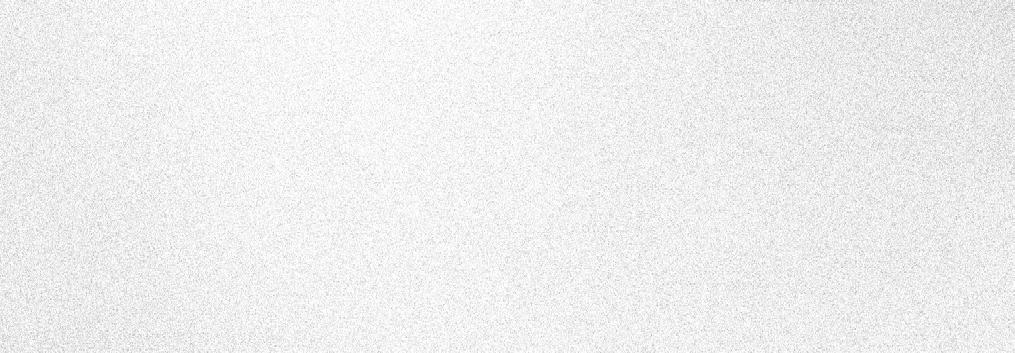
MELBOURNE WINTER MASTERPIECES ®
EXHIBITION PARTNER
PREMIUM PARTNER
LEARNING PARTNER WITH THE ASSISTANCE OF
Head of a statue of Thutmose III wearing the white crown (detail) 18th Dynasty, reign of Thutmose III c. 1479–1425 BCE, Karnak, Thebes, Egypt © The Trustees of the British Museum

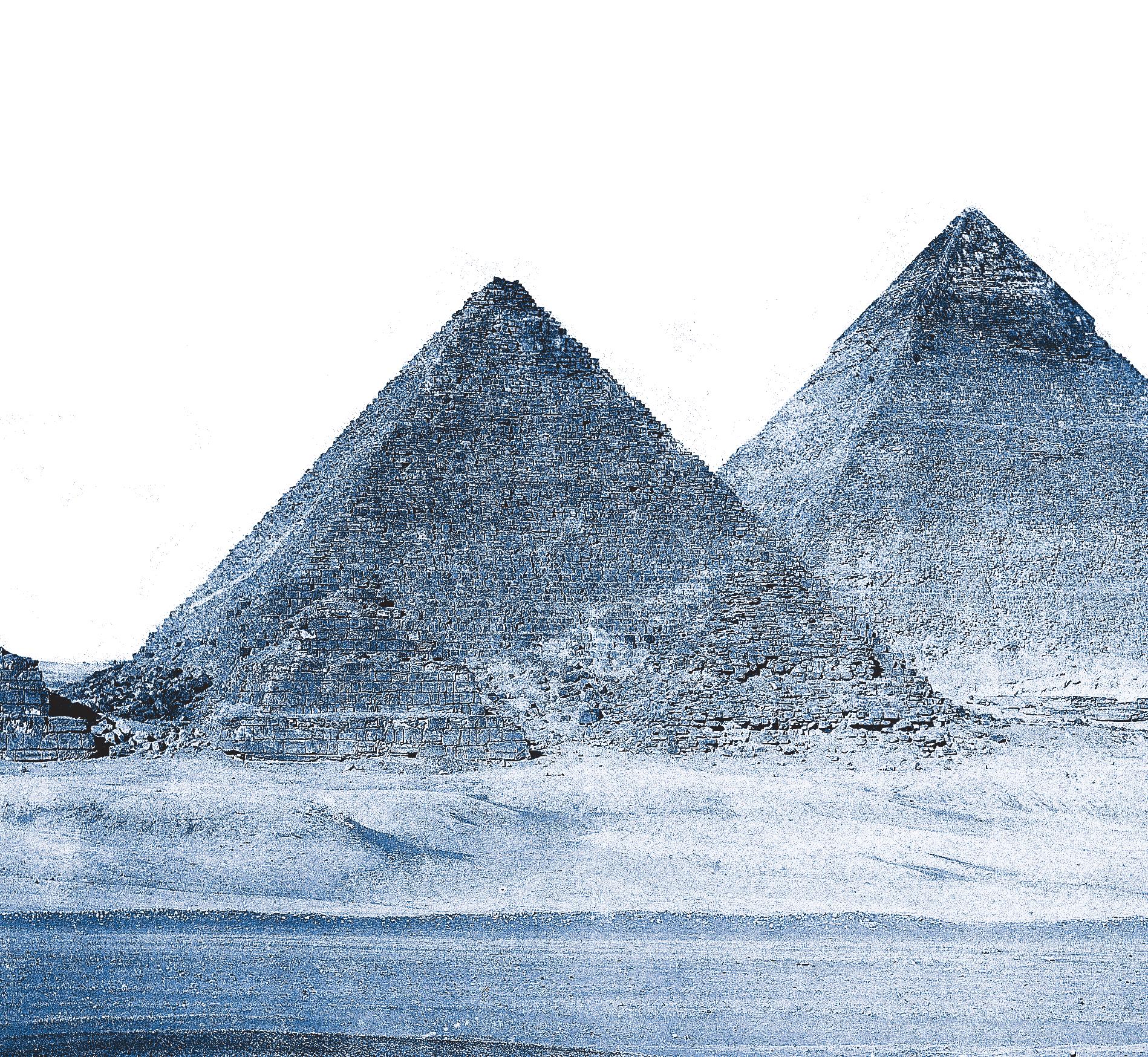
ON SHOW IN CANBERRA PRESENTING PARTNER MAJOR PARTNER The presentation of this exhibition is a collaboration between the Rijksmuseum van Oudheden (National Museum of Antiquities, Leiden, the Netherlands), the National Museum of Australia, the Western Australian Museum and the Queensland Museum Network. Inner coffin of Amenhotep (detail), 21st Dynasty, about 1076–944 BCE, Thebes, Egypt. © Rijksmuseum van Oudheden. 15 DECEMBER 2023 – 8 SEPTEMBER 2024 nma.gov.au/ancient-egypt TICKETS NOW ON SALE

135
HRH Crown Princess Mary of Denmark 2006 (detail) by Ralph Heimans. The Museum of National History at Frederiksborg Castle © Ralph Heimans
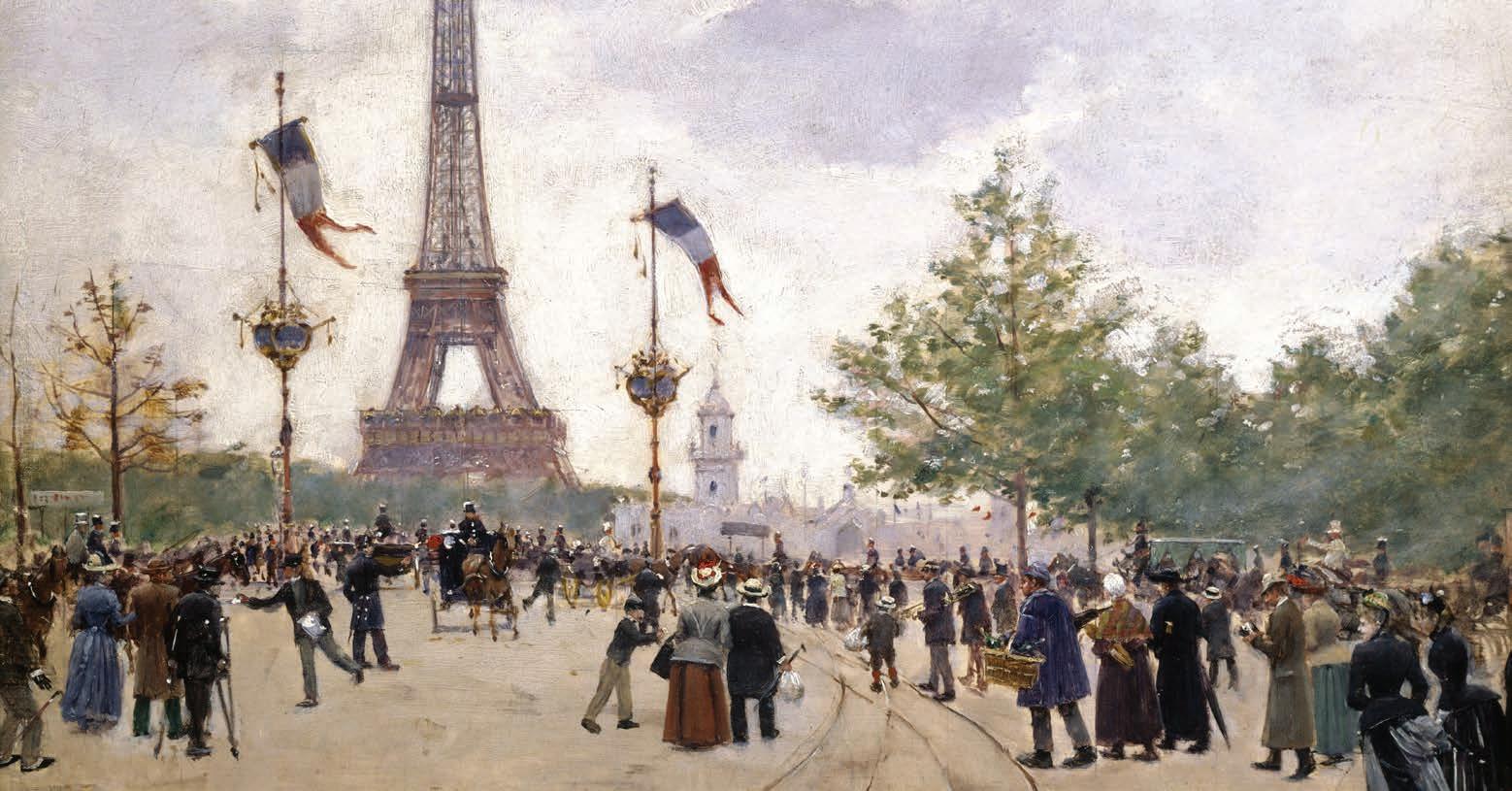

136 IMPORTANT AUSTRALIAN INDIGENOUS ART Impressions of Life 1880 – 1925 16 March – 14 July 2024 Bendigo exclusive Bendigo International Collections Exhibition organised by the Musée Carnavalet – Histoire de Paris, Paris Musées. Image credit: Jean Béraud, The Entrance to the 1889 Universal Exhibition (detail) 1889, oil on wood, Musée Carnavalet. © CCO Paris Musées / Musée Carnavalet – Histoire de Paris. @bendigoartgallery bendigoartgallery.com.au
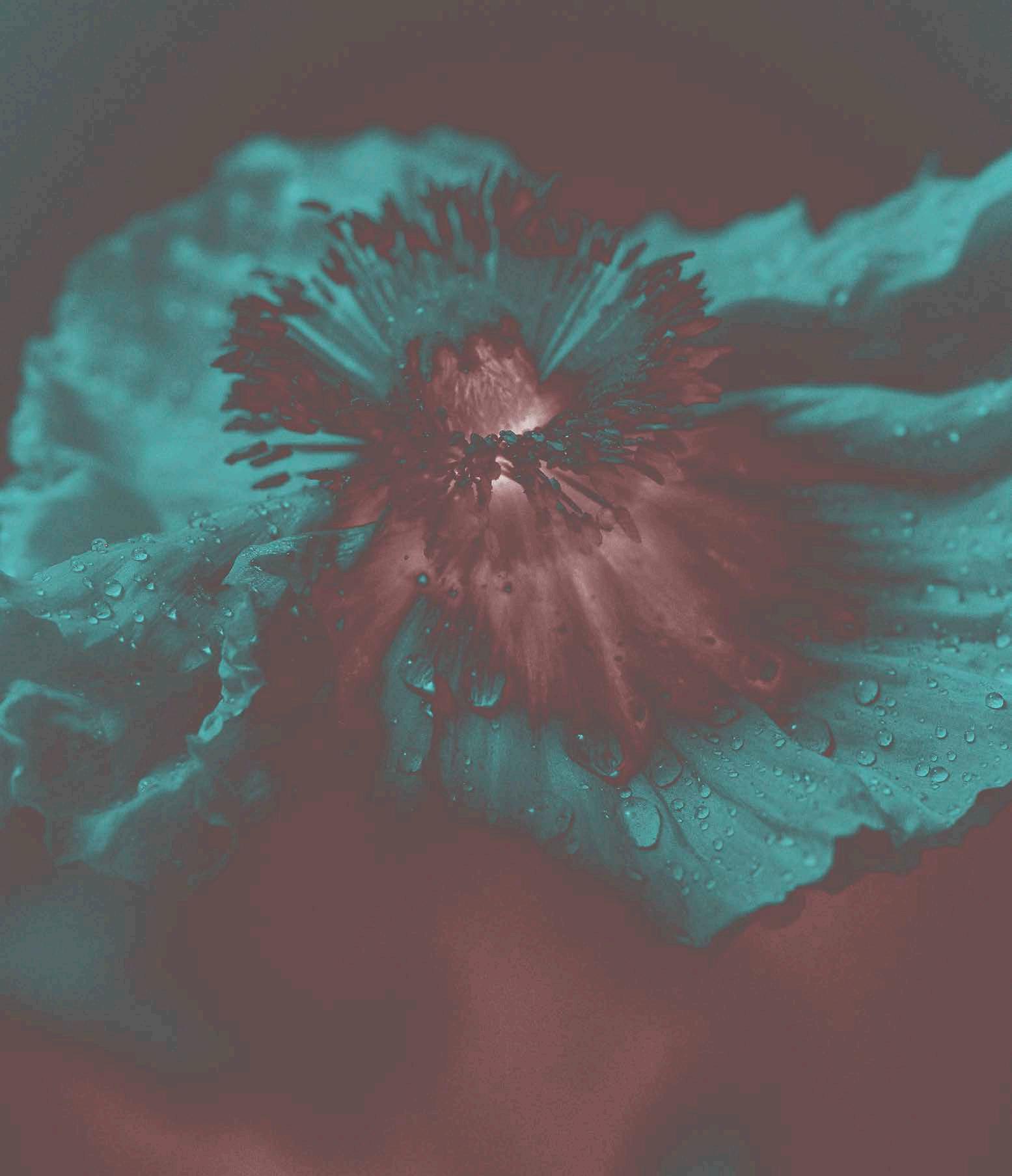


138 24.11.23 – 07.04.24 Wednesday–Sunday, free admission Nadine Christensen, Up all night (detail) 2023, courtesy of the artist and Sarah Scout Presents, Melbourne. Photograph: Christian Capurro NADINE CHRISTENSEN


Creating new beginnings for women and children at risk of homelessness with permanent and affordable homes.
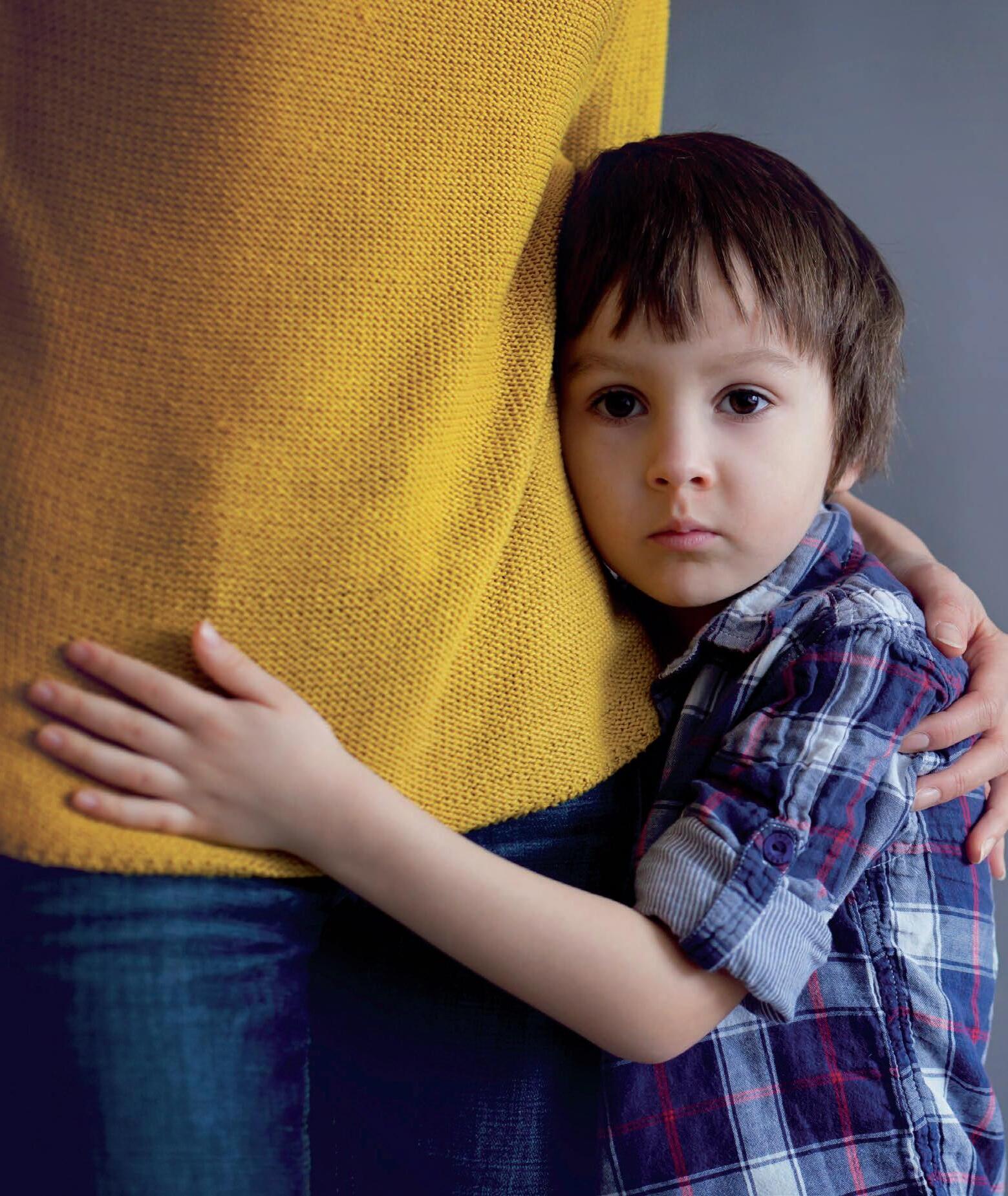
Donate now at wpi.org.au/donatenow








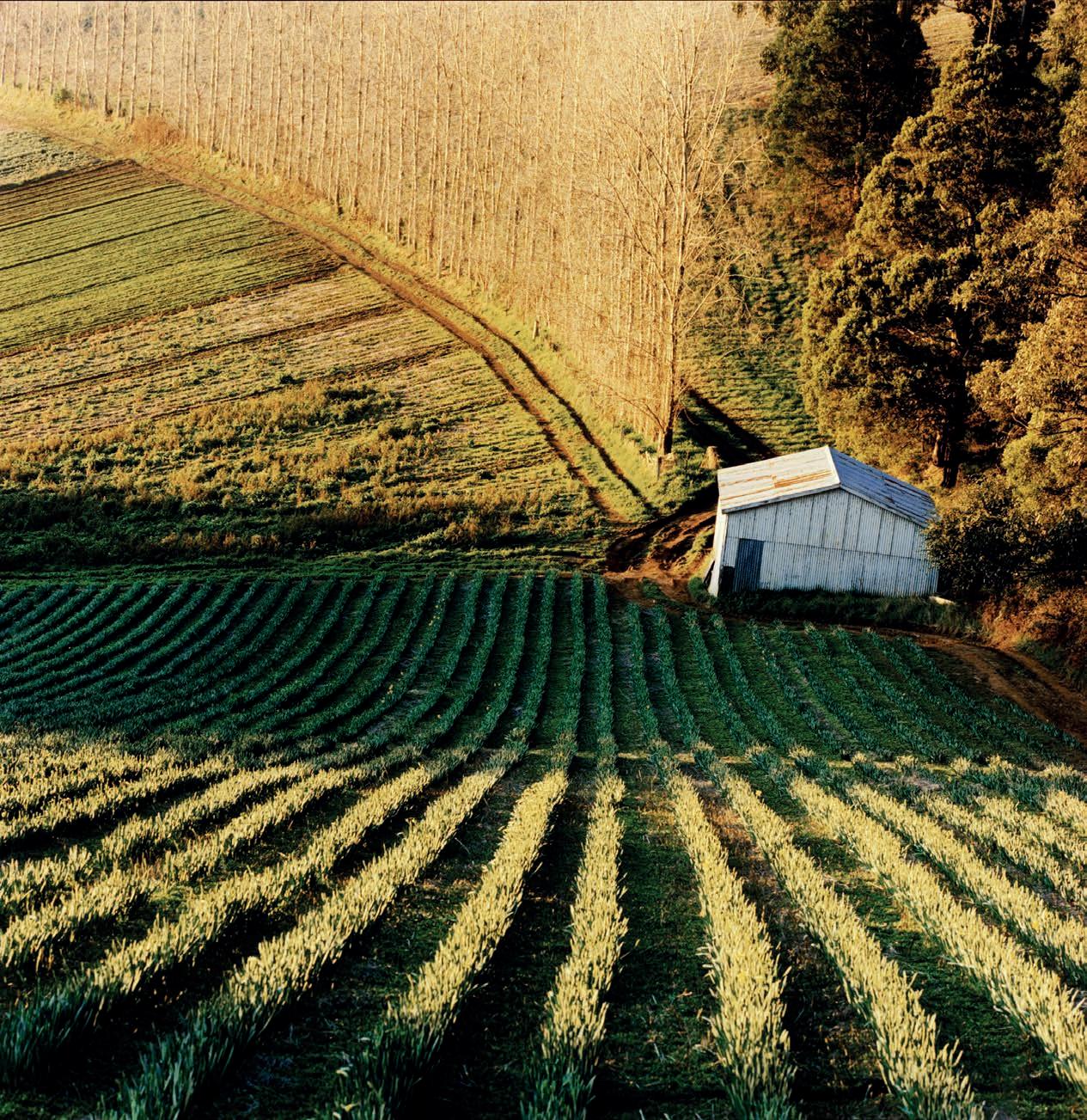











A book that showcases Australian photographer Joyce






remarkable body of work. Available in bookstores now
 Joyce Evans by Sasha Grishin
Joyce Evans by Sasha Grishin
141
Evans’
COPYRIGHT CREDITS
1 © Estate of Sally Gabori/Copyright Agency, 2024
2 © Noŋgirrŋa Marawili, courtesy Buku-Larrŋgay Mulka Art Centre
3 © courtesy of the artist's estate and Roslyn Oxley9 Gallery, Sydney
4 © courtesy of the artist's estate and Roslyn Oxley9 Gallery, Sydney
6
7
5 © Rammey Ramsey/Copyright Agency 2024
© Freddie Timms/Copyright Agency 2024
© Emily K Kngwarreye/Copyright Agency 2024
8 © Emily K Kngwarreye/Copyright Agency 2024
9
10
12
13
© John Mawurndjul/Copyright Agency 2024
© John Mawurndjul/Copyright Agency 2024
© courtesy of The Estate of Ginger Riley and Alcaston Gallery, Melbourne
© Estate of Sally Gabori/Copyright Agency, 2024
14 © Estate of Sally Gabori/Copyright Agency, 2024
15
© Fred Grant/Copyright Agency 2024
16 © Nellie Stewart/Copyright Agency 2024
17
18
19
20
21
© Jimmy Baker/Copyright Agency 2024
© Bill Whiskey Tjapaltjarri/Copyright Agency 2024
© Estate of Sally Gabori/Copyright Agency, 2024
© Estate of Sally Gabori/Copyright Agency, 2024
© Estate of Prince of Wales and Karen Brown Gallery, Darwin
CULTURAL HERITAGE PERMITS
Under the provisions of the Protection of Movable Cultural Heritage Act, 1986, buyers may be required to obtain an export permit for certain categories of items in this sale from the Cultural Property Section:
Department of Communications and the Arts
GPO Box 2154
Canberra ACT 2601
Email: movable.heritage@arts.gov.au
Phone: 1800 819 461
RESALE ROYALTY
Some lots consigned for this sale may be subject to the Resale Royalty Right for Visual Artists Act 2009 (Cth). Any payments due under the obligations of the Act will be paid by the vendor.
Design and Photography:
Danny Kneebone Design and Photography Manager
© Published by Deutscher and Hackett Pty Ltd 2024 978-0-6457871-2-2
22 © Angelina Ngale Apwerl (Pwerle)/ Copyright Agency 2024
23 © Emily K Kngwarreye/Copyright Agency 2024
24 © Emily K Kngwarreye/Copyright Agency 2024
25 © Makinti Napanangka/Copyright Agency 2024
26 © Naata Nungurrayi/Copyright Agency 2024
27 © courtesy of The Estate of Ginger Riley and Alcaston Gallery, Melbourne
28
© Namatjira Legacy Trust/Copyright Agency 2024
29 © Namatjira Legacy Trust/Copyright Agency 2024
30 © Namatjira Legacy Trust/Copyright Agency 2024
31 © Namatjira Legacy Trust/Copyright Agency 2024
32 © Namatjira Legacy Trust/Copyright Agency 2024
33 © courtesy of the artist and THIS IS NO FANTASY + dianne tanzer gallery
34 © Darren Siwes/Copyright Agency 2024
35 © Emily K Kngwarreye/Copyright Agency 2024
36 © Kitty Kantilla/Copyright Agency 2024
37 © Deaf Tommy Mungatopi/Copyright Agency 2024
38 © Eubena Nampitjin/Copyright Agency 2024
39 © Elizabeth Nyumi Nungurrayi/Copyright Agency 2024
40 © Freddy West Tjakamarra/Copyright Agency 2024
41 © Ronnie Tjampitjinpa/Copyright Agency 2024
42 © courtesy of The Estate of Paddy Bedford
43 © courtesy of The Estate of Paddy Bedford
LOTS CONSIGNED BY GST
REGISTERED ENTITIES
Lot 5 Rammey Ramsey
Lot 10 John Mawurndjul
Lot 12 Ginger Riley Munduwalawala
Lot 37 Deaf Tommy Mungatopi
Lot 40 Freddy West Tjakamarra
44 © Freddie Timms/Copyright Agency 2024
45 © Billy Thomas Joongoorra/Copyright Agency 2024
46 © Rover Thomas/Copyright Agency 2024
47 © Boxer Milner Tjampitjin/Copyright Agency 2024
48 © Wakartu Cory Surprise/Copyright Agency 2024
49 © Helicopter Tjungurrayi/Copyright Agency 2024
50 © Elizabeth Nyumi Nungurrayi/
Copyright Agency 2024
51 © Makinti Napanangka/Copyright Agency 2024
52 © Lorna Napanangka/Copyright Agency 2024
53 © Elizabeth Marks Nakamarra/ Copyright Agency 2024
54 © courtesy of the artist and Aboriginal & Pacific Art Sydney
55 © Owen Yalandja/Copyright Agency 2024
56 © Yirawala/Copyright Agency 2024
57 © John Mawurndjul/Copyright Agency 2024
58 © Namerredje Guymala/Copyright Agency 2024
60
© Jan Billycan/Copyright Agency 2024
61 © Lawrence Pennington/Copyright Agency 2024
62 © Billy Stockman Tjapaltjarri/Copyright Agency 2024
63 © Ronnie Tjampitjinpa/Copyright Agency 2024
64 © Brandy Tjungurrayi/Copyright Agency 2024
65 © Kaapa Tjampitjinpa/Copyright Agency 2024
66 © Willy Tjungurrayi/Copyright Agency 2024
142
143 i ndex A APWERL (PWERLE), ANGELINA NGALE 22 B BAKER, JIMMY 17 BEDFORD, PADDY NYUNKUNY 42, 43 BILLYCAN (DJAN NAMUNDIE), JAN 60 C COOK, MICHAEL 33 G GABORI, SALLY 1, 13, 14, 19, 20 GRANT, FRED 15 GUYMALA, NAMERREDJE 58 J JOONGOORRA, BILLY THOMAS 45 K KANTILLA, KITTY 36 KNGWARREYE, EMILY KAM 7, 8, 23, 24, 35 KOOLMATRIE, YVONNE 54 M MARAWILI, NOŊGIRRŊA 2 MAWURNDJUL, JOHN 9, 10, 57 MAYMURU, NARRITJIN 59 McRAE, TOMMY 11 MUNGATOPI, DEAF TOMMY 37 N NAKAMARRA, ELIZABETH MARKS 53 NAMATJIRA, ALBERT 28, 29, 30, 31, 32 NAMPITJIN, EUBENA 38 NAPANANGKA, LORNA 52 NAPANANGKA, MAKINTI 25, 51 NUNGURRAYI, ELIZABETH NYUMI 39, 50 NUNGURRAYI, NAATA 26 P PENNINGTON, LAWRENCE 61 PRINCE OF WALES (MIDPUL) 21 R RAMSEY, RAMMEY 5 RILEY MUNDUWALAWALA, GINGER 12, 27 S SIWES, DARREN 34 STEWART, NELLIE 16 SURPRISE, WAKARTU CORY 48 T THOMAS (JOOLAMA), ROVER 46 TIMMS, FREDDIE 6, 44 TJAKAMARRA, FREDDY WEST 40 TJAMPITJIN, BOXER MILNER 47 TJAMPITJINPA, KAAPA 65 TJAMPITJINPA, RONNIE 41, 63 TJAPALTJARRI, BILL WHISKEY 18 TJAPALTJARRI, BILLY STOCKMAN 62 TJUNGURRAYI, BRANDY 64 TJUNGURRAYI, HELICOPTER 49 TJUNGURRAYI, WILLY 66 Y YALANDJA, OWEN 55 YIRAWALA 56 YUNUPIŊU, NYAPANYAPA 3, 4


 specialist fine art auction house and private gallery
specialist fine art auction house and private gallery













































































































































 Joyce Evans by Sasha Grishin
Joyce Evans by Sasha Grishin


 specialist fine art auction house and private gallery
specialist fine art auction house and private gallery